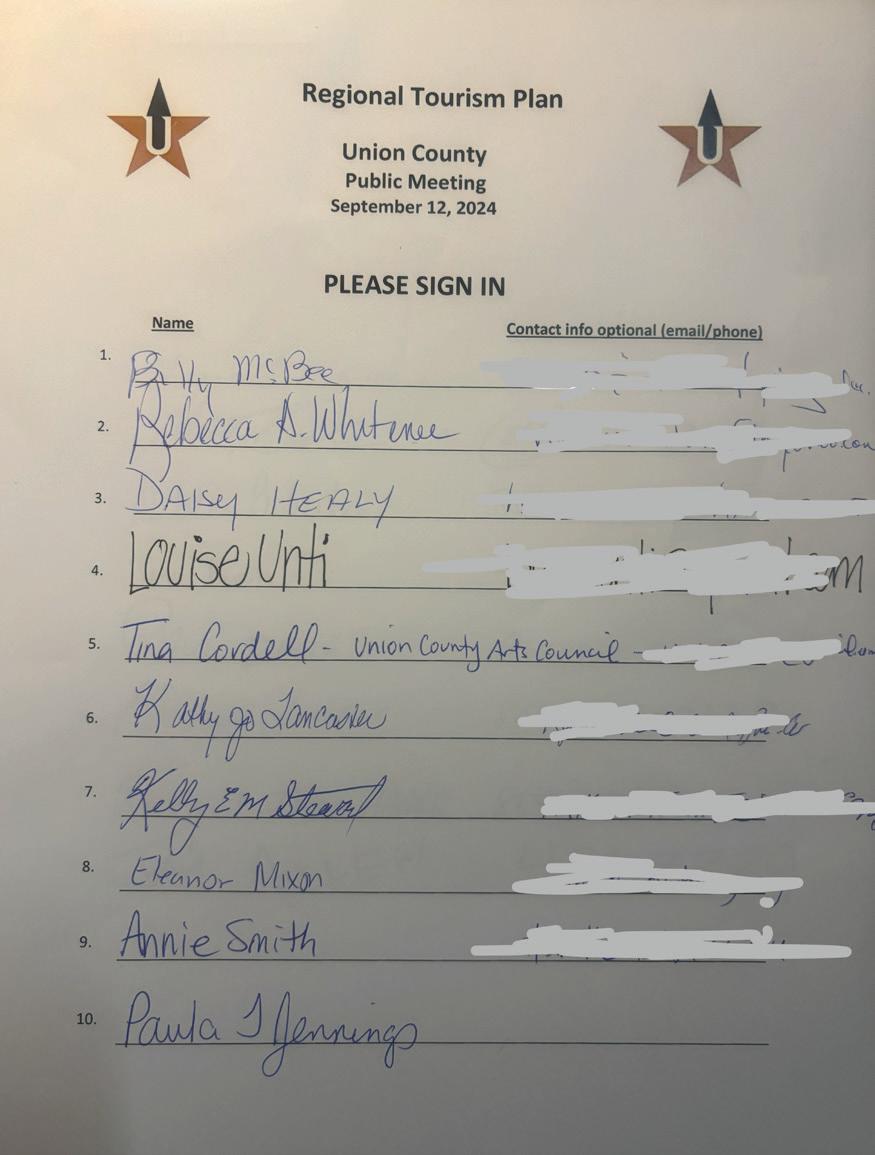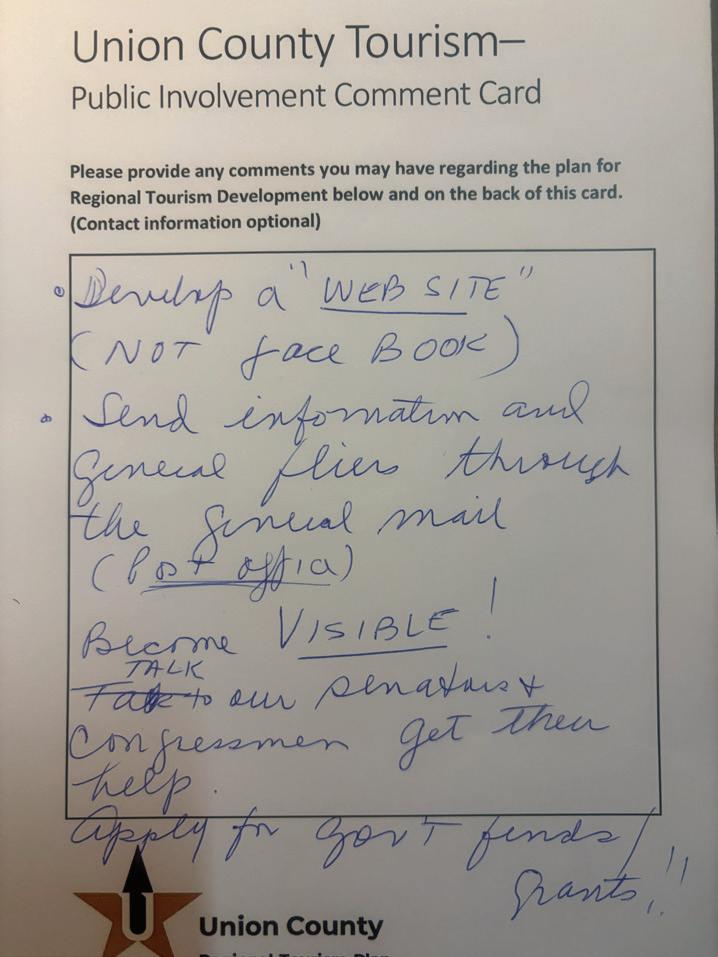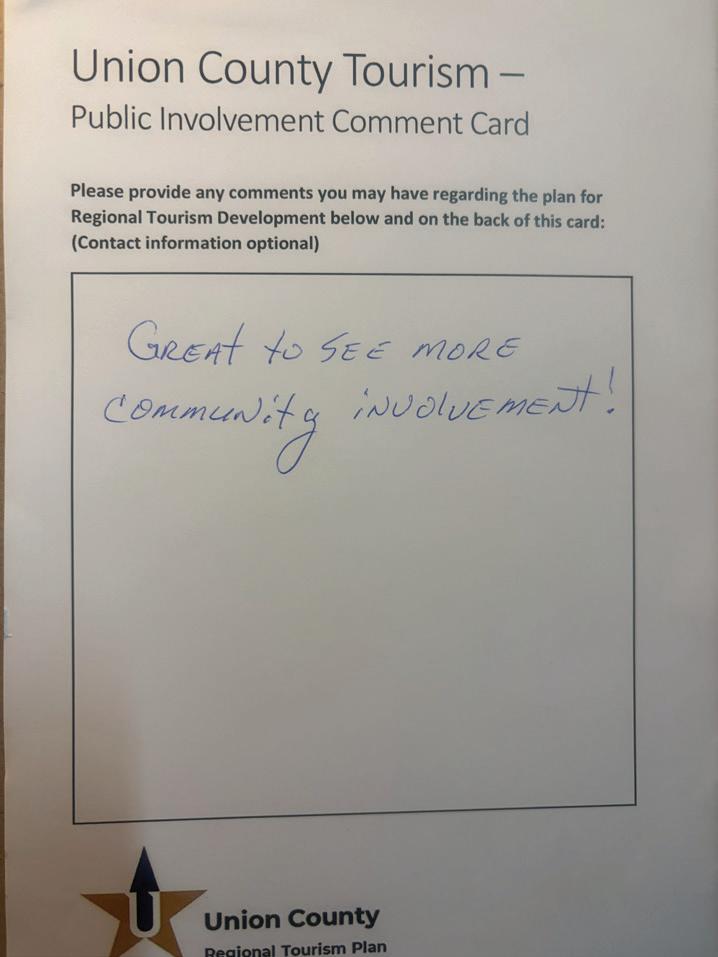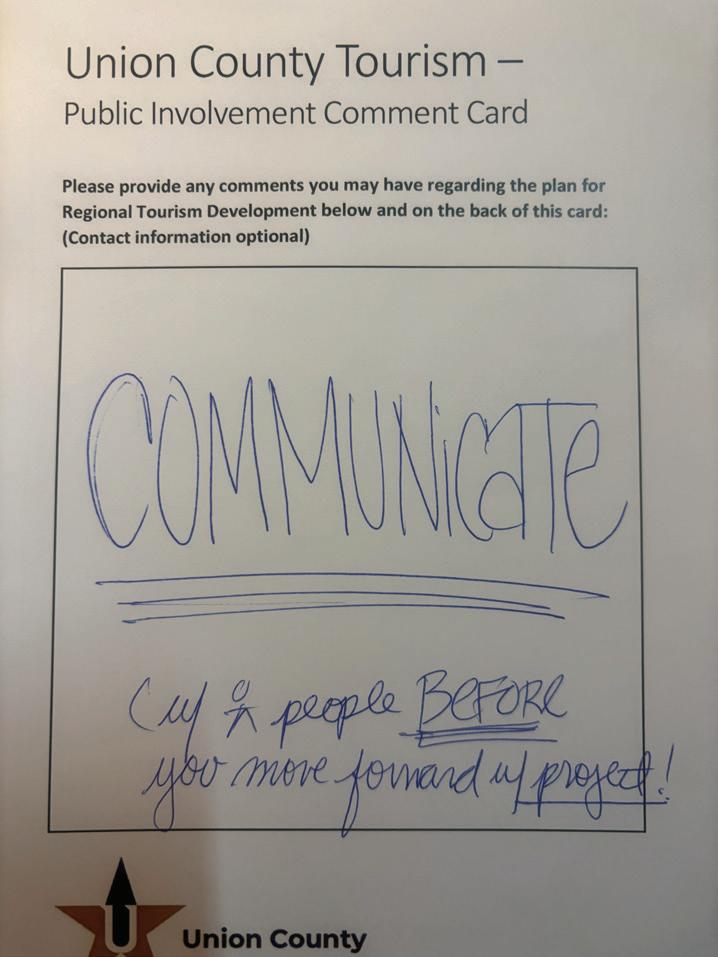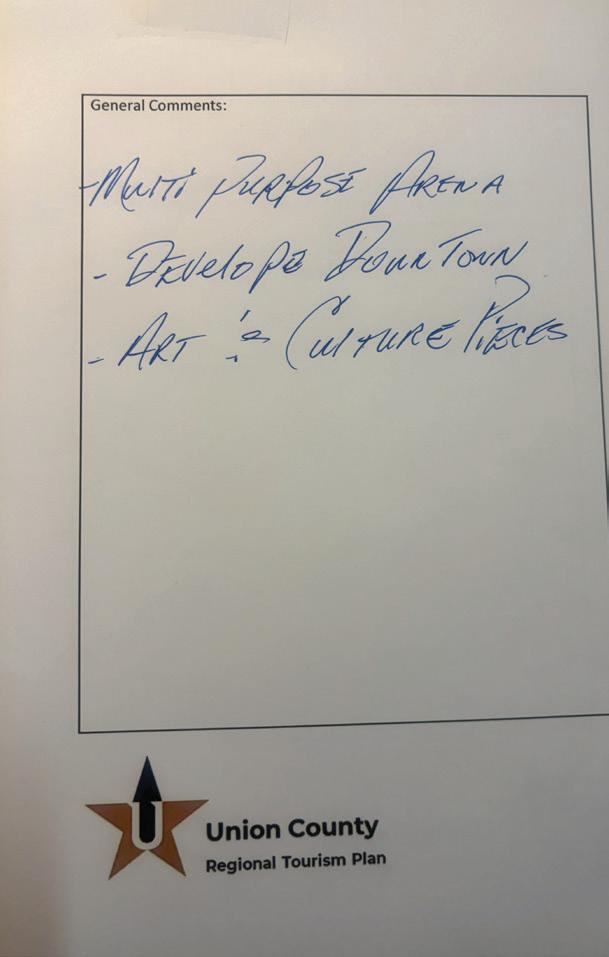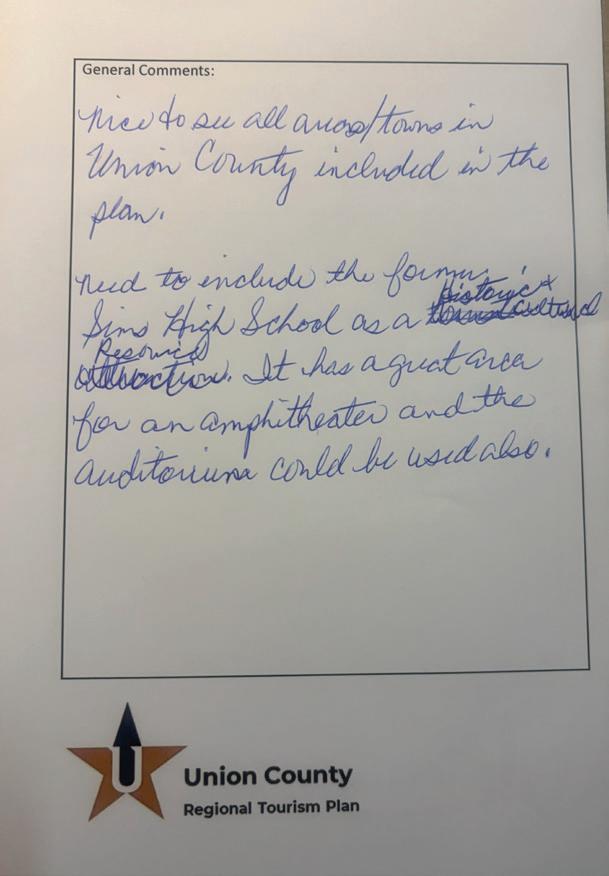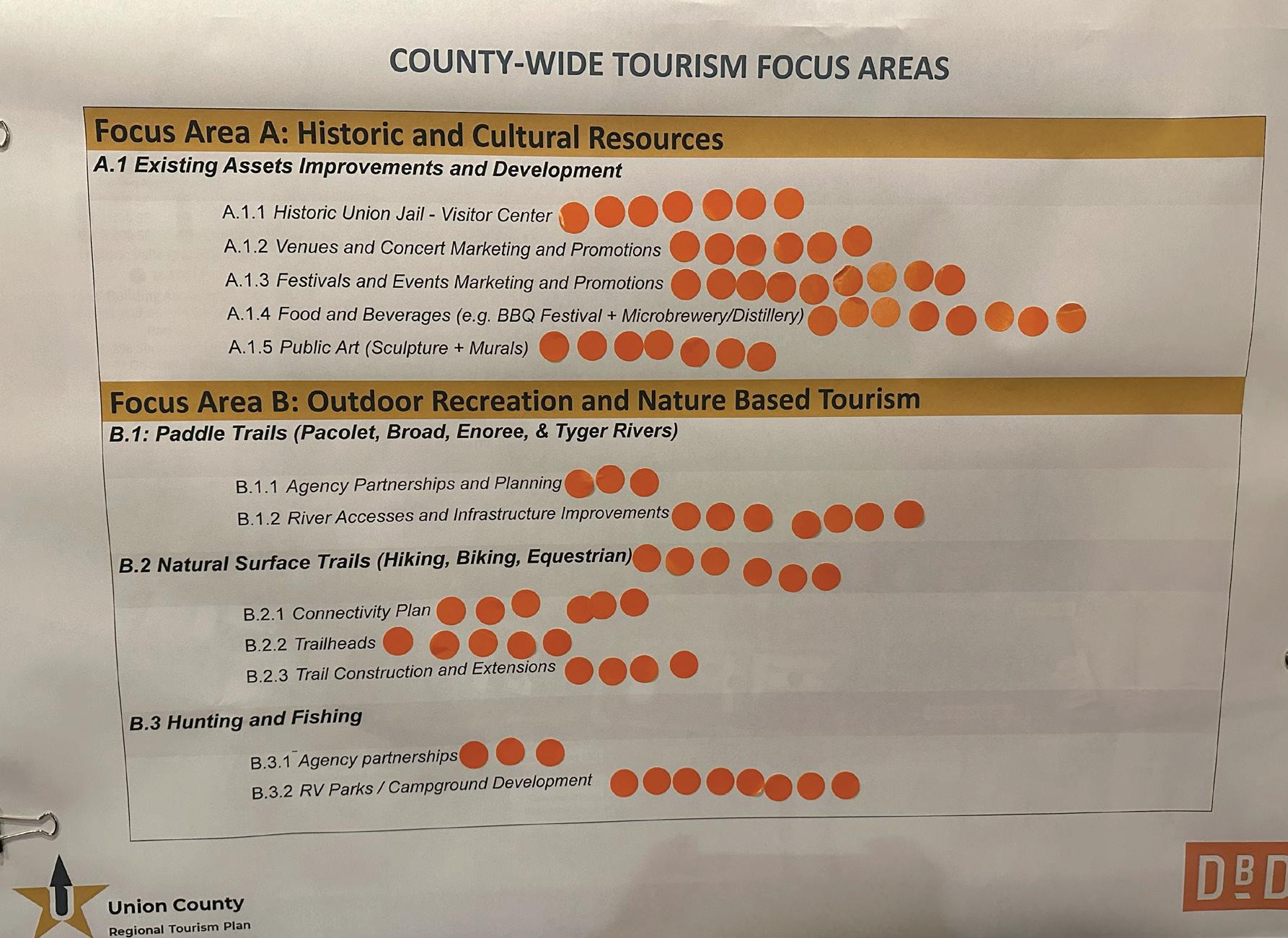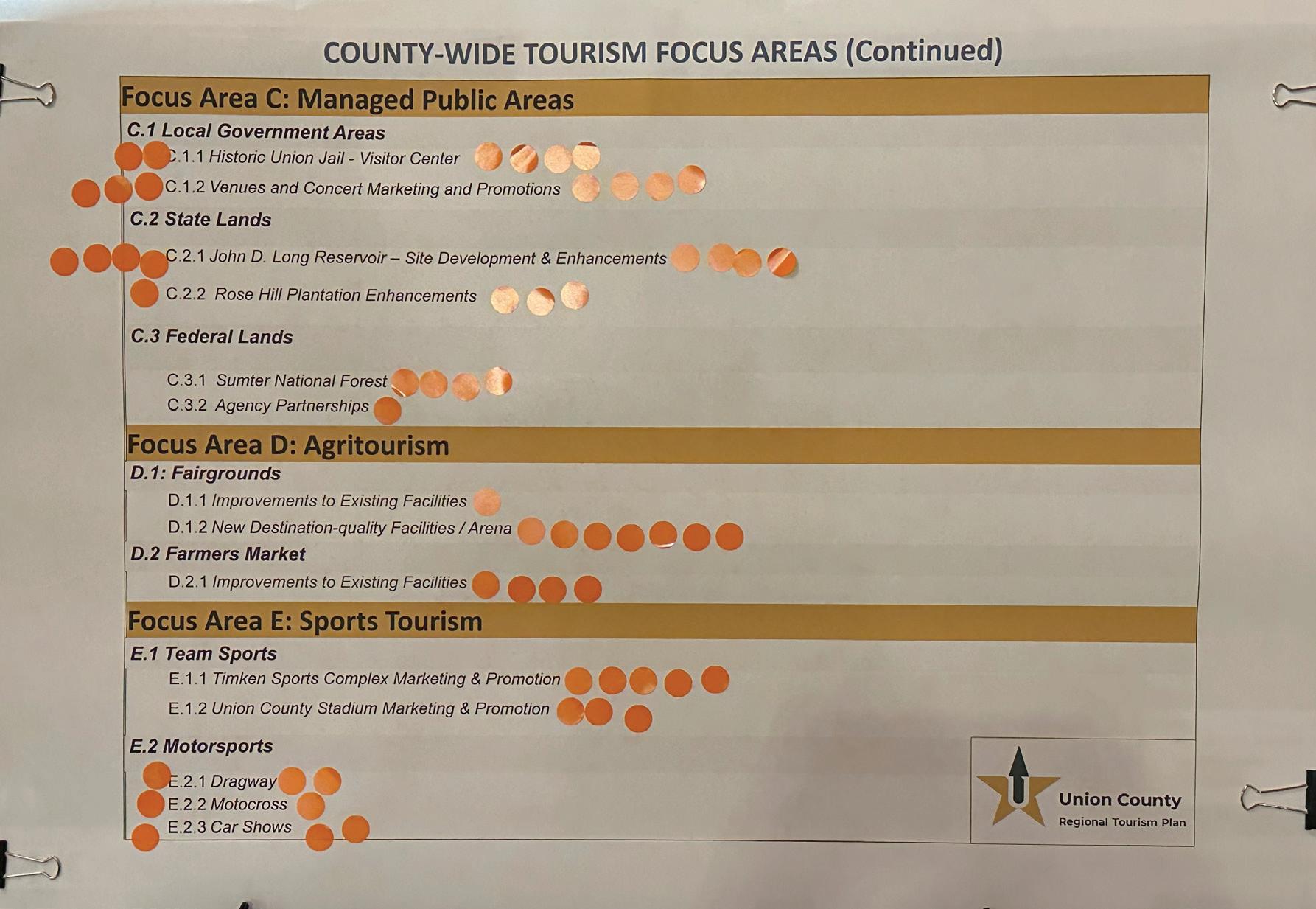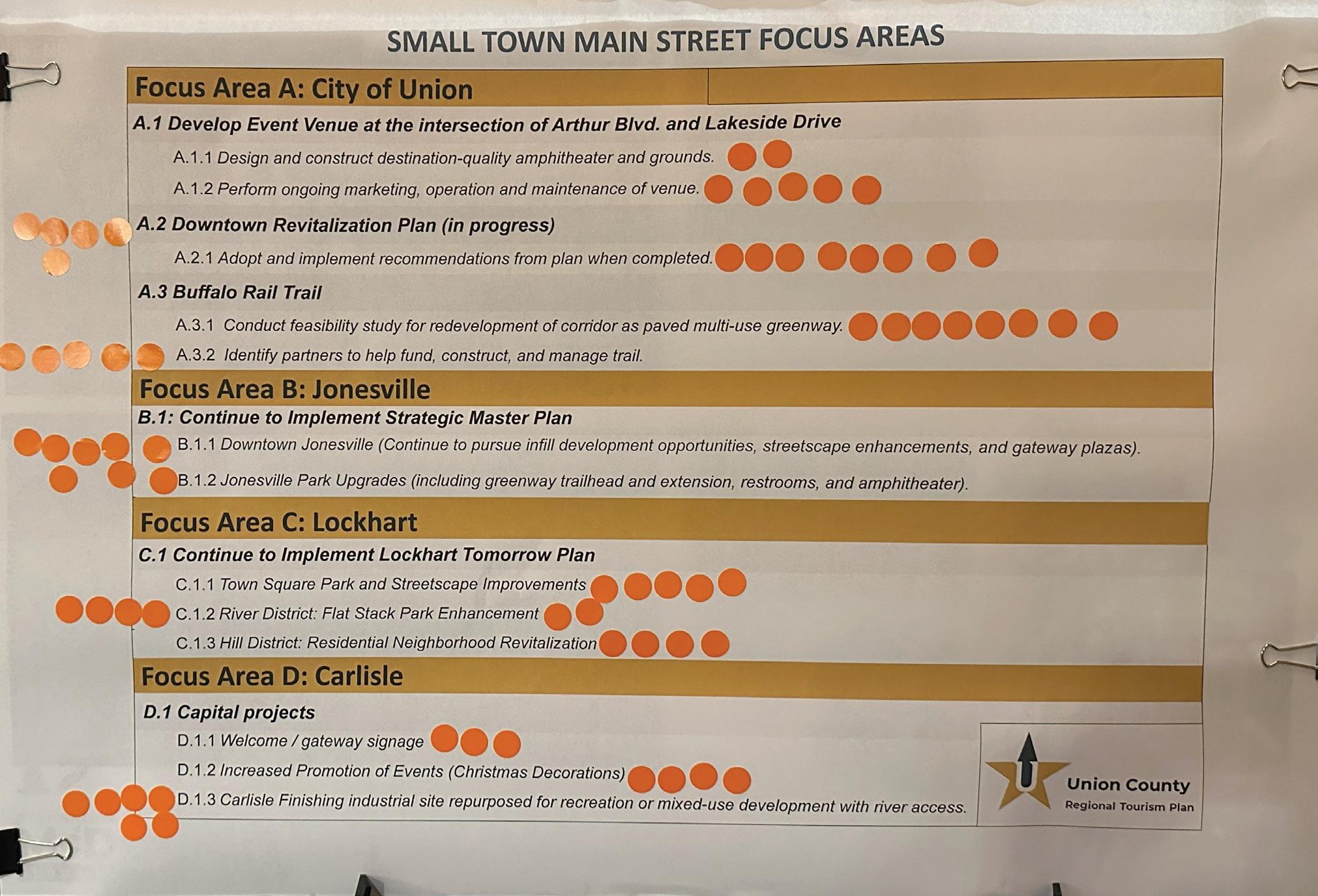










Phillip Russell, Supervisor/Chairman
Danny Bright, County Council, District 1
John Glenn, County Council, District 2
David Sinclair, County Council, District 3
Annie Smith, County Council, District 4
Carolyn Rutherford, County Council, District 5
John Flood, County Council, District 6
Curtiss Hunter, Tourism Director
Kathy Jo Lancaster, Community Development Director
Kevin Shropshire, Parks and Recreation Director
Dolton Williams, Development Board Director
Harold Thompson, Mayor
Jackie Earls, City Council, District 1
Robert Garner (Mayor Pro-Tem), Town Council, District 2
Gloria Rogers, City Council, District 3
Ricky Todd Harris, City Council, District 4
Pamela Garner Sloss, City Council, District 5
Monty Cooke, City Council, District 6
Joe Nichols, City Administrator
Lance Davis, Utilities Director
Mary Ferguson-Glenn, Mayor
Ronnie Lyles, Mayor Pro-Tem
Radzil Thompson, Town Council
Maxine Spencer, Town Council
Ann Stevens-Brown, Town Council
Ernest Moore, Mayor
Preston Bennett, Town Council
Ronnie Jenkins, Town Council
Ann Queen, Town Council
Ronald Young, Town Council
Lee Chambers, Town Administrator
Connie Porter, Mayor
Donnie Adams, Town Council
Bernice Canupp, Town Council
Mark McFalls, Town Council
Gina Porter, Town Council
Helen McFalls, Town Clerk
Jay Allen, At Large Member
Lee Chambers, Town Administrator, Town of Jonesville
Stanley Clowney, Jr., At Large Member
Paul Davis, At Large Member
John Glenn, Union County Council
Mary Hooker, At Large Member
Curtiss Hunter, Director, Union County Tourism
Eleanor Mixon, Community Development Planner, Catawba Regional COG
Connie Porter, Mayor, Town of Lockhart
Kevin Shropshire, Parks and Recreation Director, Union County
David Sinclair, Union County Council
Ann Stevens-Brown, Carlisle Town Council
Harold Thompson, Mayor, City of Union

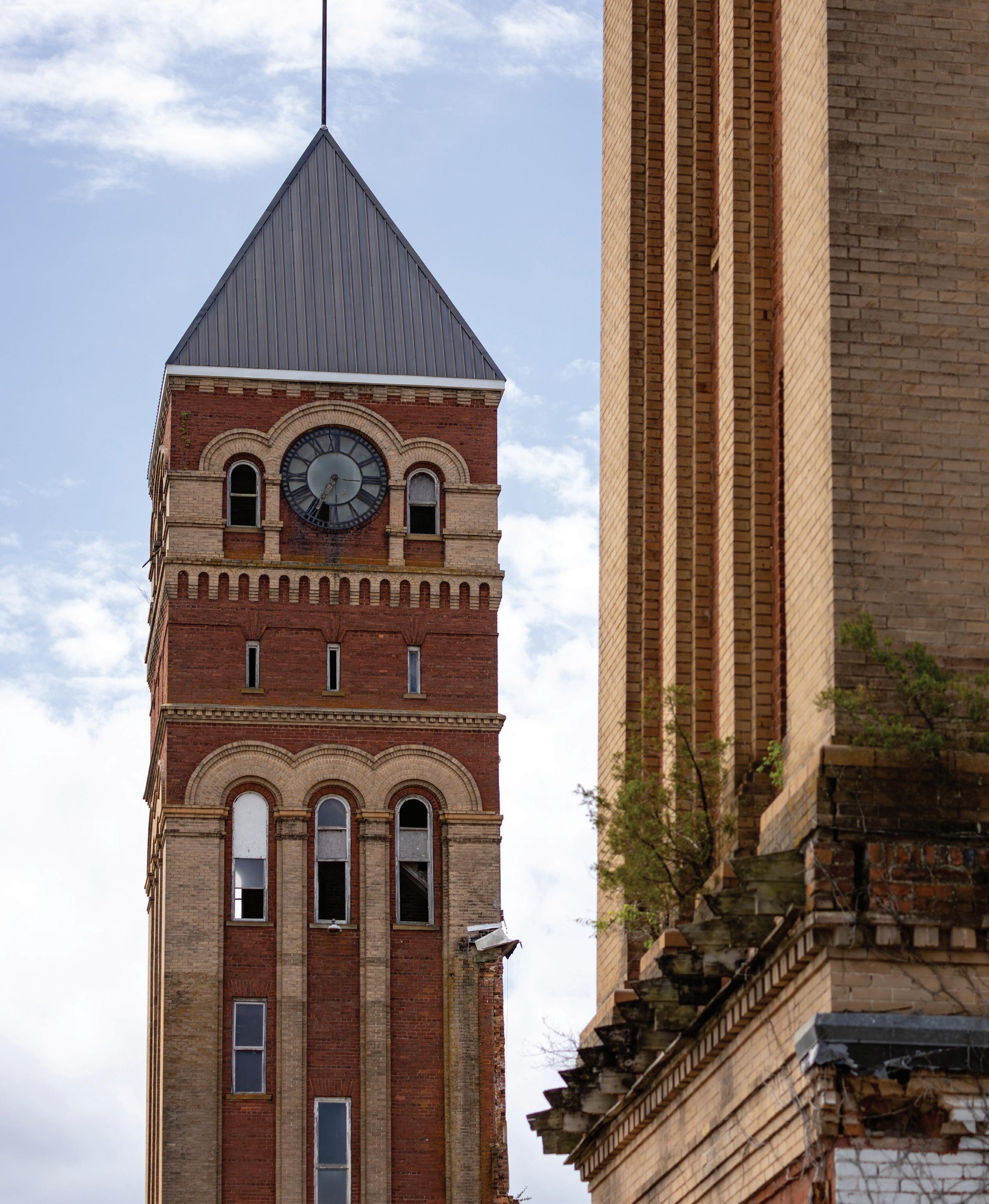
This chapter introduces the Union County Regional Tourism Plan and outlines its significance in shaping the regional tourism landscape and for promoting a healthy, active community. Here, the plan’s purpose in enhancing economic development, improving public health, and establishing Union County as a prominent tourist destination are emphasized. This section identifies specific goals, such as enhancing local businesses, promoting outdoor recreation, and addressing other specific community needs and preferences. An inclusive planning process has been used to engage a wide variety of community stakeholders and to help ensure a collaborative approach to tourism development. A brief overview of the plan’s structure is provided, emphasizing the key sections and topics in the following chapters that outline the blueprint for tourism asset development and enhancement. A summary of the chapter reinforces the importance of a cohesive tourism strategy that will foster economic growth and community wellness throughout Union County.
1.1 PROJECT BACKGROUND
1.2 PROJECT GOALS
1.3 PLANNING PROCESS
1.4 PLAN ORGANIZATION
The Union County Regional Tourism Plan is the result of the dedicated and collaborative efforts of the Project Oversight Committee. This committee includes elected officials and local government staff, as well as representatives from small businesses and the hospitality sector. Committee members agree that strengthening the area’s tourism economy will contribute to the health and economic vitality of Union County. This group has explored a variety of tactics intended to enhance and improve existing tourism assets, further develop new tourism products and infrastructure, and supplement promotion and marketing efforts.
The Oversight Committee and community stakeholders have cast a shared vision intended to grow a strong tourism economy that will contribute to a thriving community and promote healthy, active lifestyles for residents. Identifying tourism development strategies that support outdoor recreation and cultural enrichment, and minimize barriers to access, are fundamental objectives of this plan.

VISION STATEMENT
“The Union County Tourism Plan will identify strategies for tourism development that highlight the County’s unique cultural and natural resources and offer clearly defined recommendations that make the most of these assets to enhance the overall quality of life and help promote tourism within the County.”
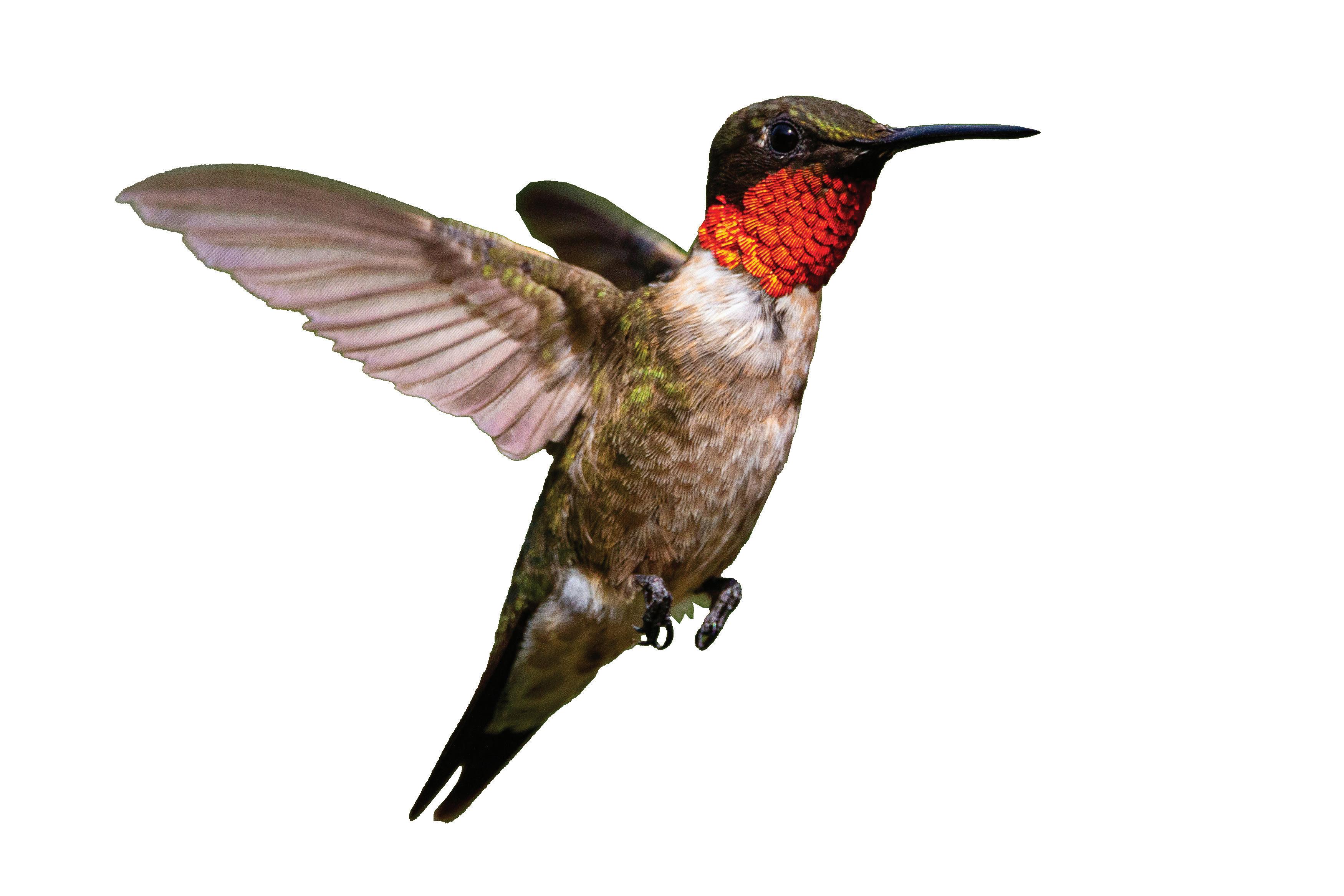
AND TAKE ADVANTAGE OF THE NATURAL BEAUTY WE HAVE IN OUR AREA.”
– Curtiss Hunter, Union County Tourism Director
The Union County Regional Tourism Plan is driven by the dedicated leadership of the Project Oversight Committee, which understands the importance of strategic planning and a cohesive vision. The Committee’s collaborative approach reflects a deep commitment to enhancing the region’s tourism potential. Recognizing the value of tourism, the Committee emphasizes the need to expand and promote the County’s diverse assets. By focusing on outdoor recreation and cultural heritage, Union County aims to improve the quality of life for residents while attracting visitors seeking unique experiences. The plan’s goals are designed to sustain and grow the tourism industry, ensuring that it contributes positively to the local economy and community well-being. Through targeted initiatives, the Committee aims to create a vibrant tourism sector that benefits all stakeholders. With effective leadership and diligent implementation of the plan’s strategies, Union County will be poised to become a sought-after destination for outdoor recreation and cultural heritage tourism. This unified vision will not only
enhance the region’s appeal but also foster a strong sense of community pride among residents.
The Union County Regional Tourism Plan represents numerous months of research and planning by the oversight committee and local stakeholders. Continued cooperation and alignment regarding the plan goals and development strategies will be crucial; ultimately this collaborative approach will demonstrate a commitment to success and should be leveraged to effectively pursue federal, state, and private funding.
The Oversight Committee established six (6) primary goals for the plan, including:
1. EVALUATE ASSETS 2. ENGAGE PARTNERS 3. IDENTIFY AND FILL GAPS
SUPPORT UNITY
5. COMMUNICATE VISUALLY
6. PROVIDE EFFECTIVE STRATEGIES
Identify the County’s existing tourism assets and evaluate the current conditions and their ability to support community and economic development.
Engage local stakeholders and community leaders to establish a vision for enhancing tourism opportunities and the quality of life within the County and Municipalities.
Identify new and innovative projects to fill existing gaps and help support and realize the County’s vision for the future.
County and City officials will support a unified, agreed upon collection of projects which inspires community and civic pride, encourages entrepreneurship, invests in small businesses, and promotes tourism.
Create a plan that generates interest and inspires the community by including high-quality imagery and other graphics that help effectively communicate the plan recommendations.
Provide Union County and its partners with implementation strategies and recommendations that will help attract visitors, residents, and businesses.
The Regional Tourism Plan represents the culmination of several months of planning, analysis, site visits, and meetings. The planning process was structured into three major phases, including:
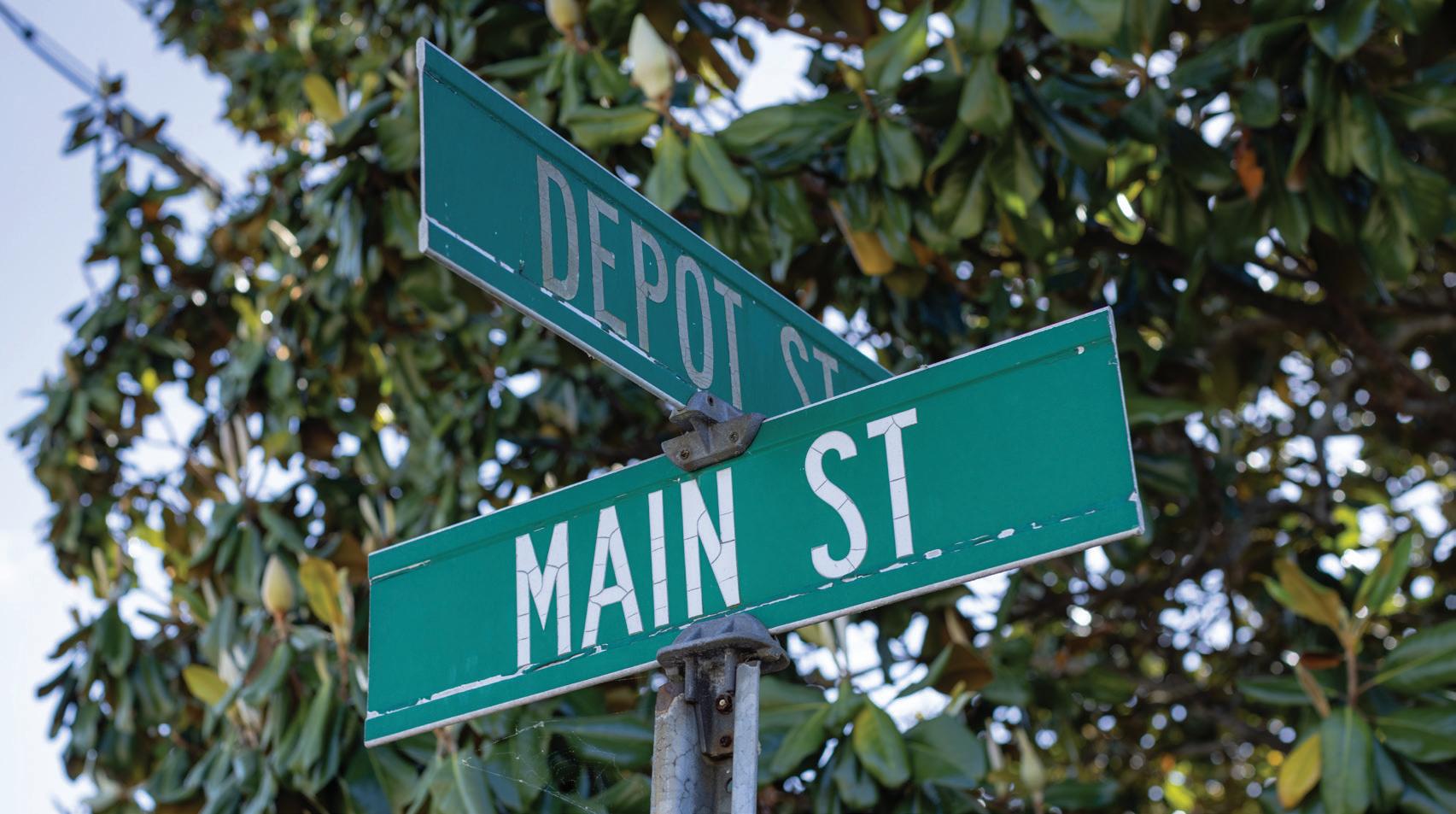
The consultant team held a direction-setting meeting with the Project Oversight Committee to discuss the project’s purpose, goals, and planning process. Additional meetings were conducted with elected officials and staff from Union County, the City of Union, and the Towns of Lockhart, Carlisle, and Jonesville to identify potential tourism development opportunities.
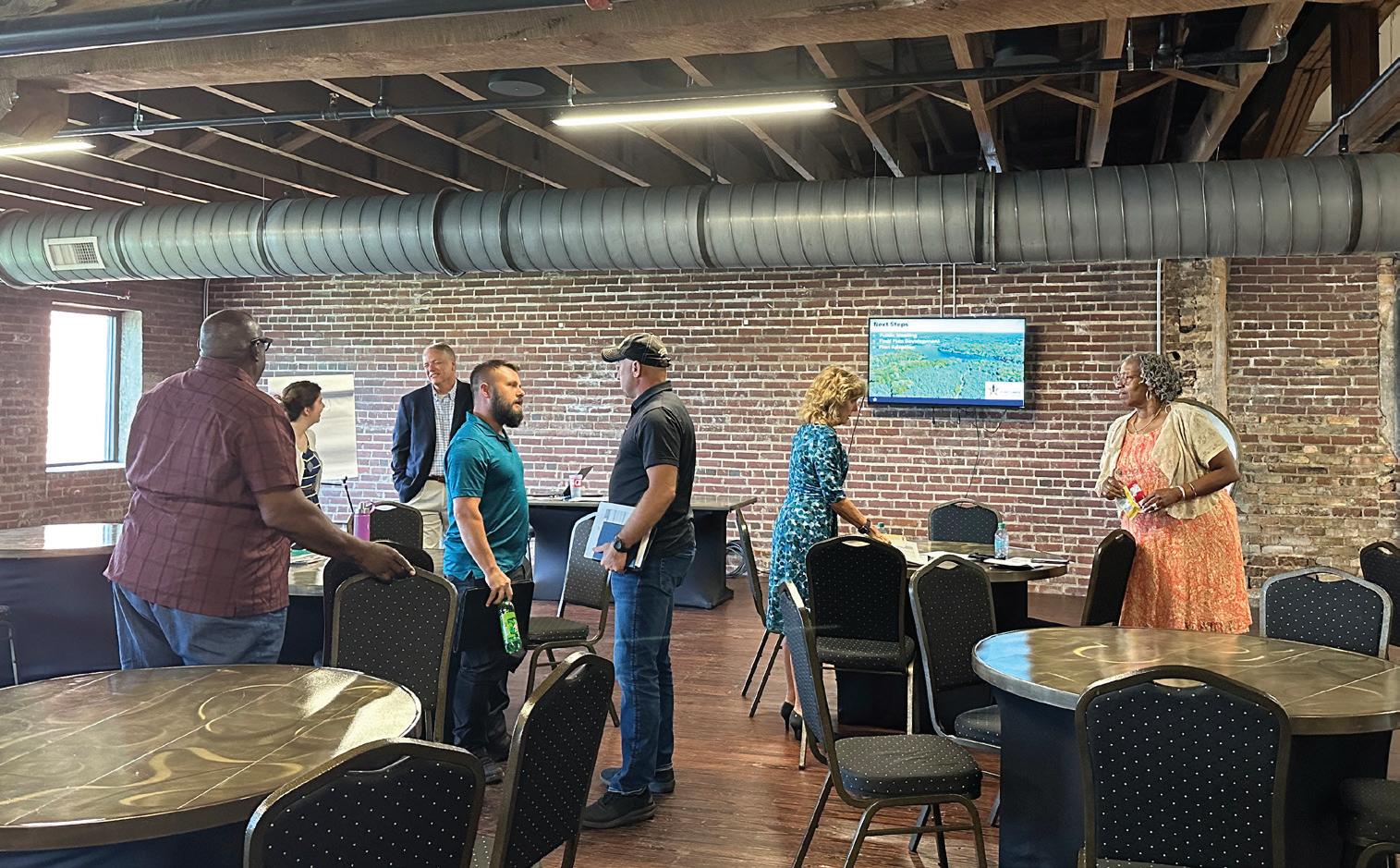
April - September 2024
Building on the results of Phase 1, the consultant team developed a plan that identifies key opportunities and constraints, compiles an inventory of existing tourism assets, and assesses previous planning efforts related to the Regional Tourism Plan. To ensure effective communication, a project website was created to share the plan’s purpose, goals, and process with stakeholders and community members. Stakeholder groups and community partners were engaged through personal interviews, while the wider community contributed their input via a survey available on the website.
The consultant team presented a plan framework that included preliminary recommendations for enhancing tourism assets. Feedback was also collected from local government staff and elected officials during a project workshop. Additionally, a dropin meeting was held at Main Street Junction to further involve the public and gather additional insights.
September - December 2024
The consultant team compiled the final plan document by incorporating community input, refining recommendations, and establishing implementation priorities. This process ensured that the plan reflects the needs and aspirations of the community while providing a clear roadmap for future development.
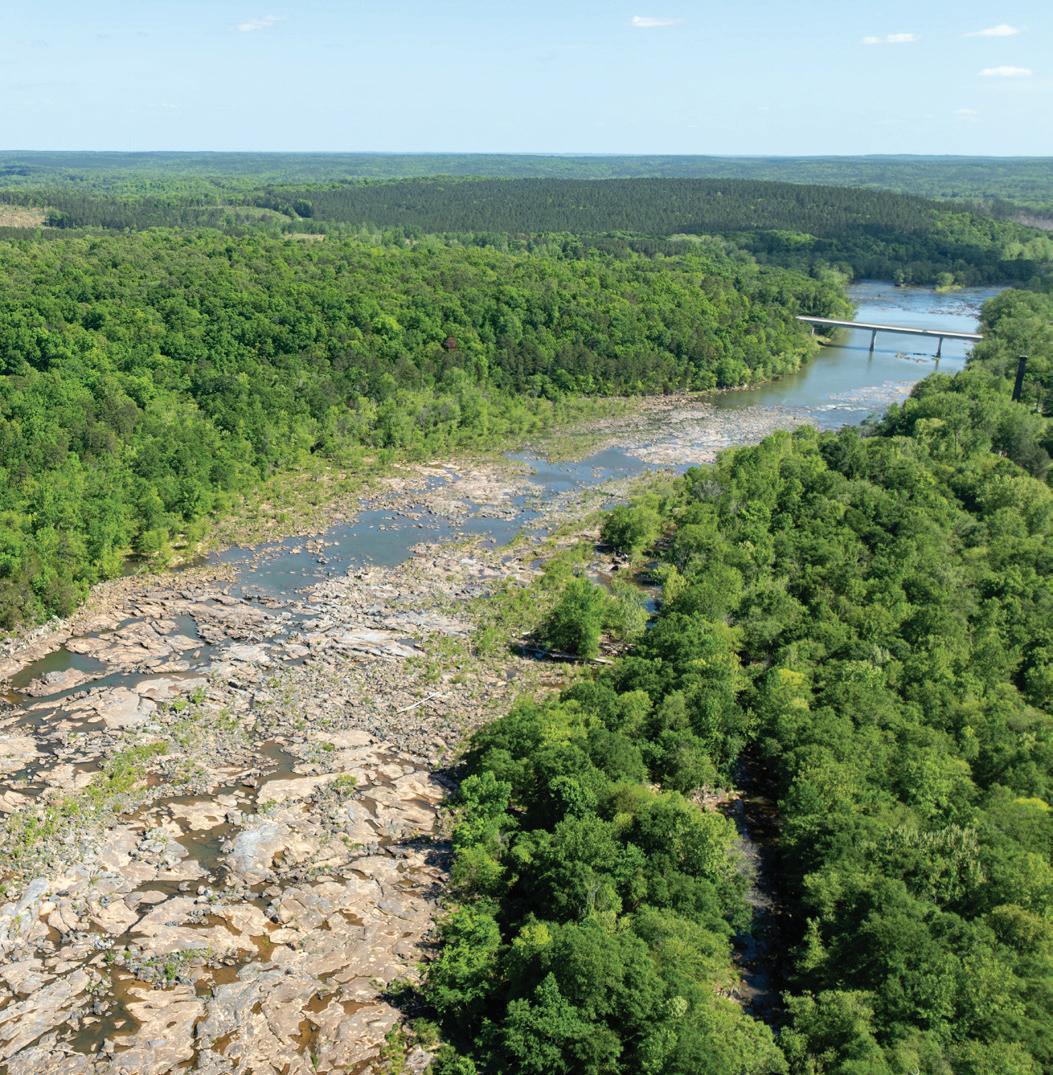
The Regional Tourism Plan is organized into five (5) major chapters as outlined below.
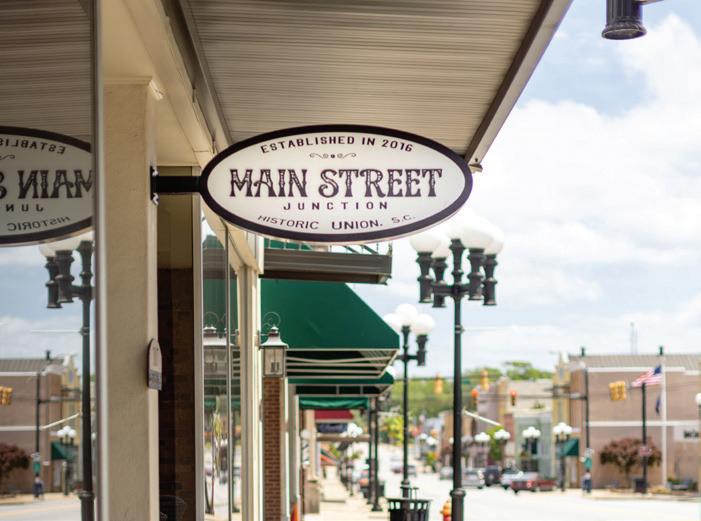
This chapter outlines the plan’s purpose, goals, processes, and overall structure. It provides a clear overview of the plan’s objectives and the steps involved in its development as well as how it is organized to ensure effective implementation and alignment with community and regional priorities.
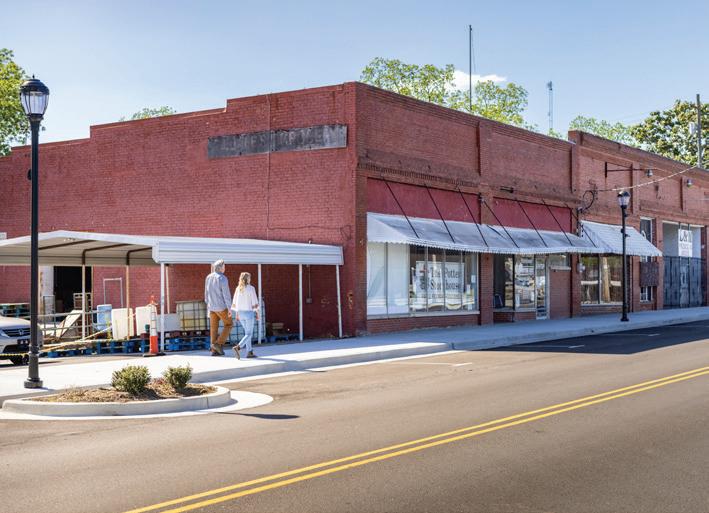
Discovery and Analysis provides an overview of the County’s regional context, demographic trends, and previous planning initiatives. Additionally, it includes a comprehensive inventory and analysis of the tourism assets found across the County, categorized into five major asset types. Each of these types is interrelated and directly contributes to Union County’s tourism economy.
“IT TAKES AS MUCH ENERGY TO WISH AS IT DOES TO PLAN.”
– Eleanor Roosevelt
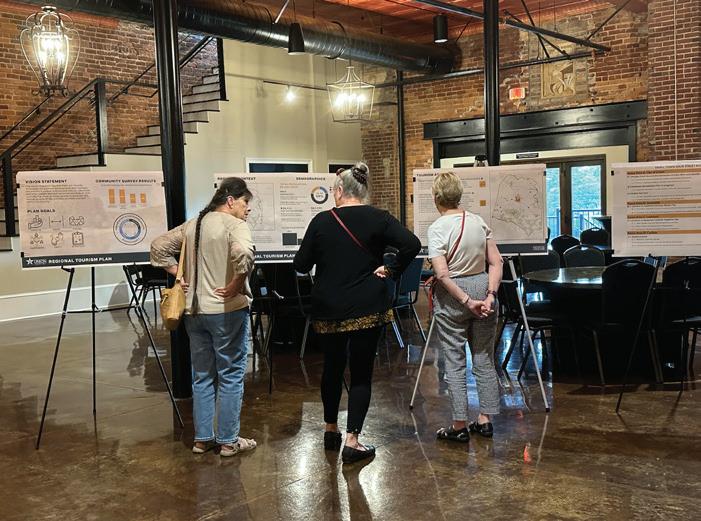
This chapter details the tools employed for public engagement throughout the planning process, highlighting the diverse partner organizations and stakeholders who contributed their insights. It concludes with the findings from a community survey that help inform specific tourism development recommendations.
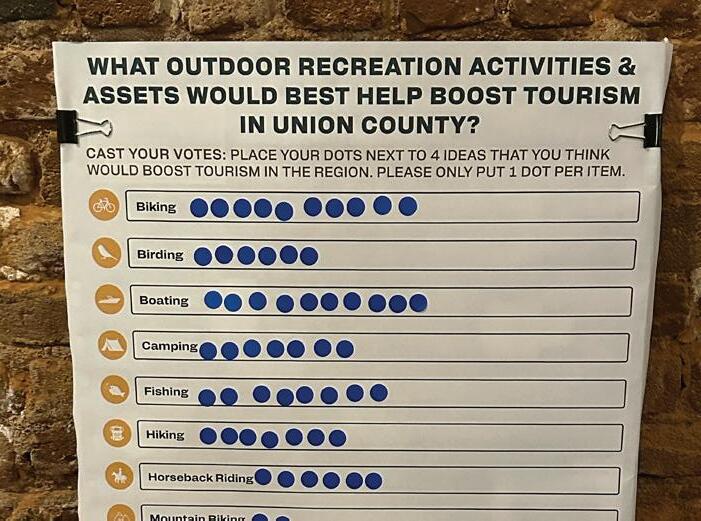
Recommendations are structured around six key Focus Areas that were identified during the planning process: 1) Historic and Cultural Resources, 2) Outdoor Recreation and Nature-Based Tourism, 3) Managed Areas, 4) Agritourism, 5) Sports Tourism, and 6) Main Streets. Within each Focus Area, specific projects and action items are outlined to guide implementation.
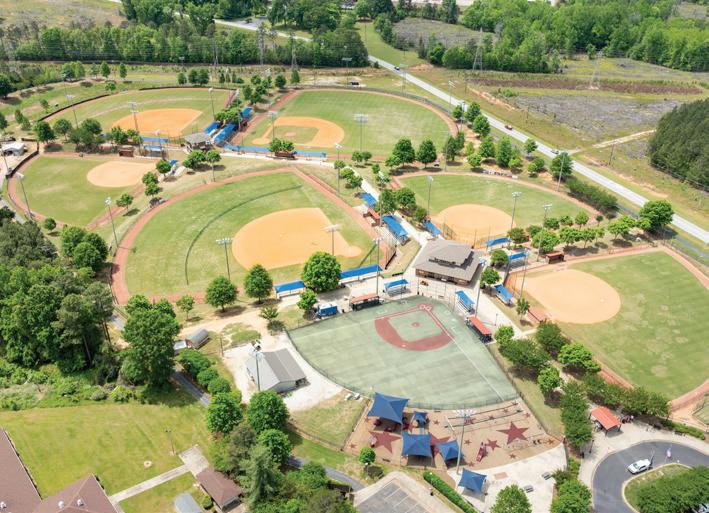
The final chapter presents a comprehensive matrix of tourism development recommendations, including prioritization and implementation strategies. It outlines estimated costs for key projects and provides an overview of potential grant funding sources to support their execution. The chapter is designed to guide the effective implementation of the tourism plan, ensuring that initiatives are both actionable and financially supported.
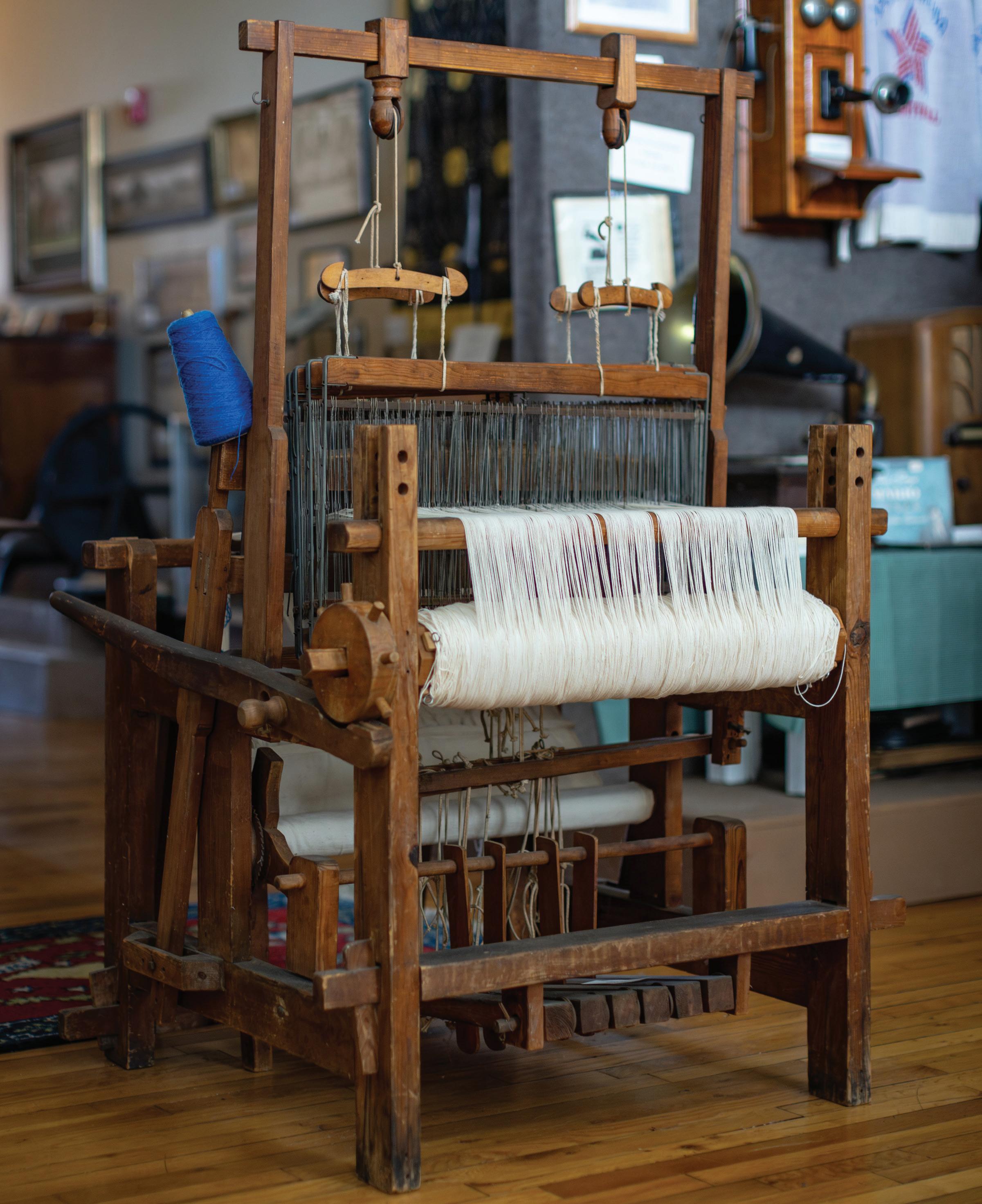
This chapter examines the regional context, demographics, and relevant past planning efforts in Union County. It also provides an inventory of assets, including existing resources and, in some cases, planned facilities. The chapter is organized into the following sections.
2.1 REGIONAL CONTEXT
2.2 DEMOGRAPHICS
2.3 PREVIOUS PLANNING EFFORTS
2.4 ASSET INVENTORY
This section examines the County’s geography, transportation network, and its setting within the regional context.
Union County, located in the Upstate of South Carolina, includes 515 square miles within the state’s Piedmont physiographic province. Entirely situated within the Broad River watershed, a significant river basin that originates in neighboring North Carolina, the county is shaped by several major streams, including the Broad, Tyger, Pacolet, and Enoree Rivers. These waterways not only define the county’s landscape but also mark its political boundaries. To the north, the county is bordered primarily by the Pacolet River, in the east by the Broad, the Enoree in the west, and the Tyger forms part of the southern boundary.
Union County is bordered by seven adjacent counties in South Carolina, arranged in a clockwise order from the north; these include: Cherokee, York, Chester, Fairfield, Newberry, Laurens, and Spartanburg.
Union County features diverse topography, encompassing the Southern Appalachian foothills, rolling Piedmont, and alluvial plains that dominate much of the area. The highest point in the county, located near the Spartanburg County line on Beddington Mountain, rises to an elevation of 796 feet and hosts a water tank owned by the Meansville-Riley Water Company. According to a 2023 report by the South Carolina Conservation Bank, approximately 21,000 acres—about six percent of the county’s land—are developed, while over 73,000 acres, or 22 percent, are protected, primarily within the Sumter National Forest.
State Highways 215, 9, and 49 are key vehicular routes within Union County, complemented by US Highway 176, which facilitates convenient access to Interstates 26, 85, and 77. US Highway 49 runs through the county, serving as the primary east-west corridor that connects the urban core of Union
County with surrounding areas. Additionally, these thoroughfares offer connectivity to neighboring urban areas, such as Spartanburg and Gaffney. Union County’s location provides easy access to major metropolitan areas such as Greenville, Columbia, and Charlotte, which are all within a relatively short drive.

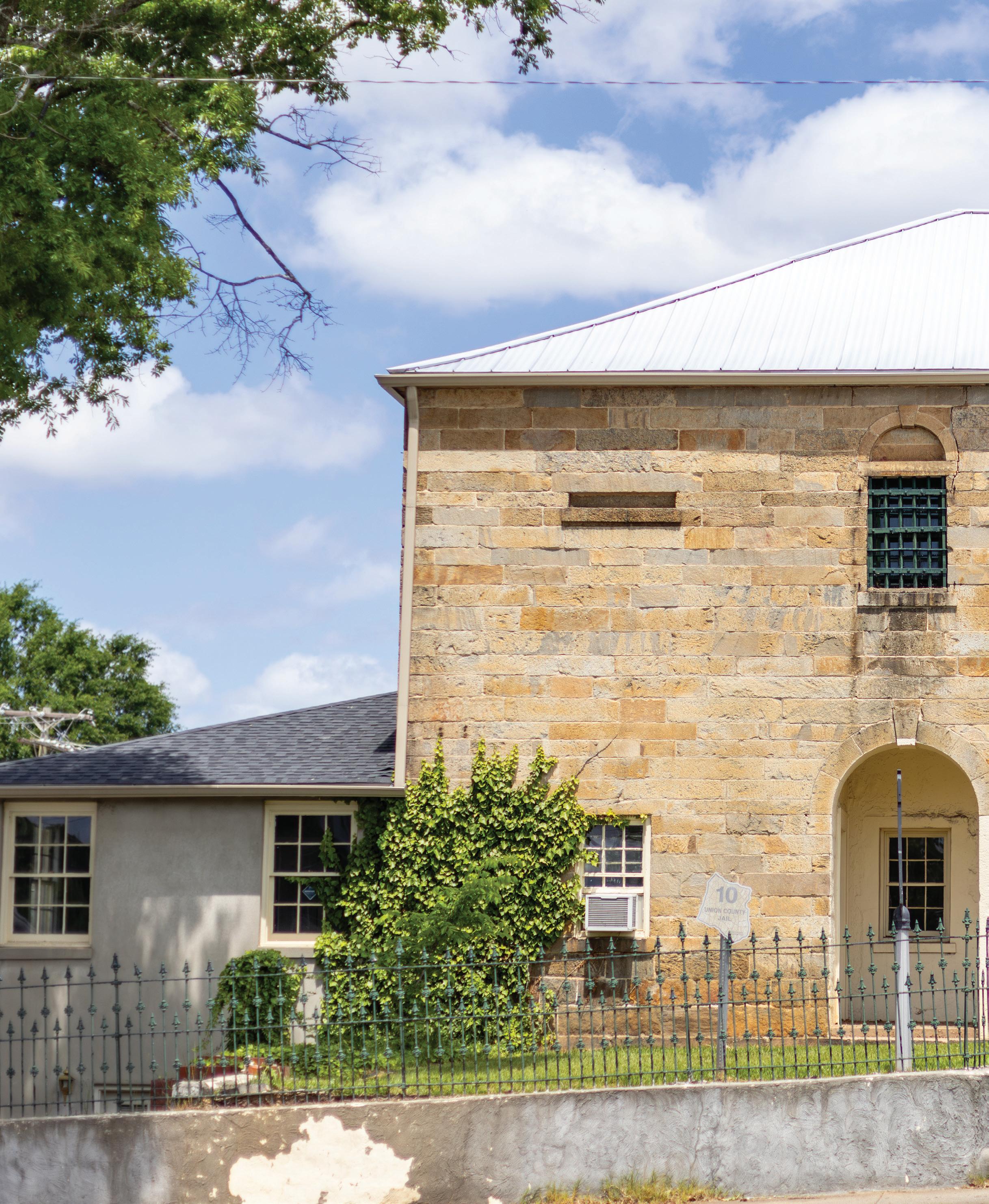
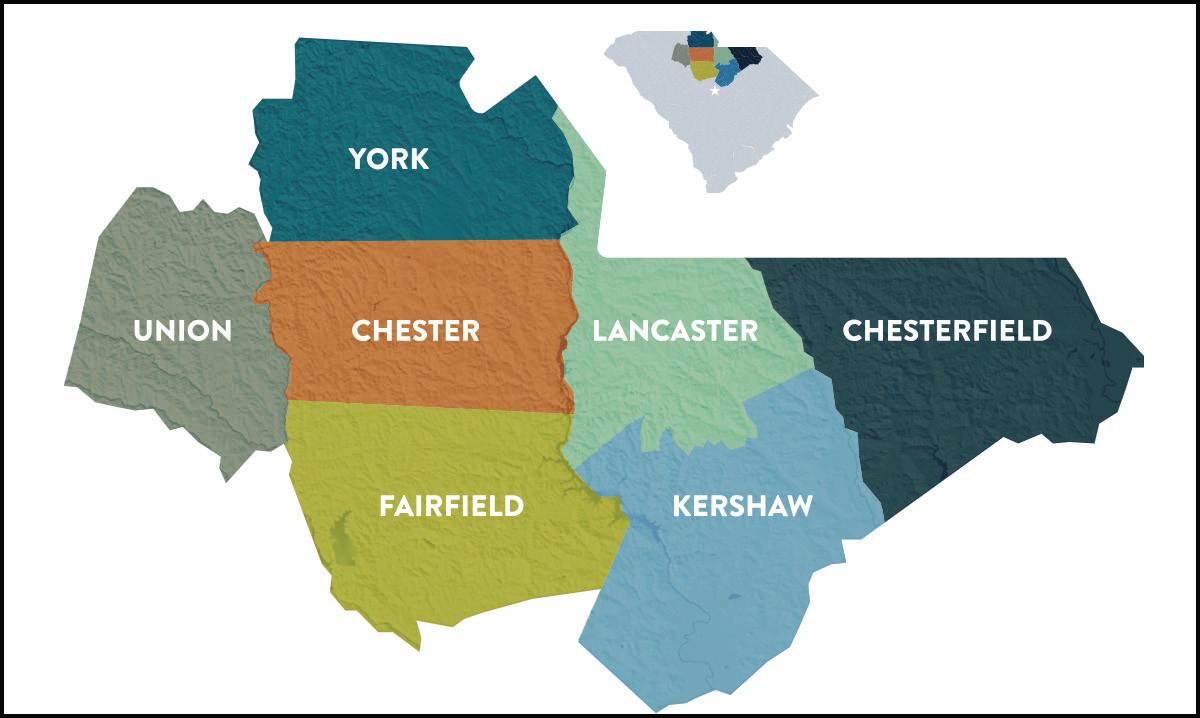
The Olde English District is one of eleven vernacular tourism regions designated by the South Carolina Department of Parks, Recreation and Tourism to help promote place-based economic development. The district draws its name from the early English settlers who arrived to the territory in the mid-1770s, and now encompasses seven counties in north-central South Carolina: Chester, Chesterfield, Fairfield, Kershaw, Lancaster, Union, and York. This region has made impressive strides and is now recognized as a premier destination, offering a wealth of outdoor adventures, agritourism, heritage tourism, and other authentic experiences. Visitors can explore multiple state parks and historic sites, each providing unique attractions that highlight the district’s rich cultural heritage.
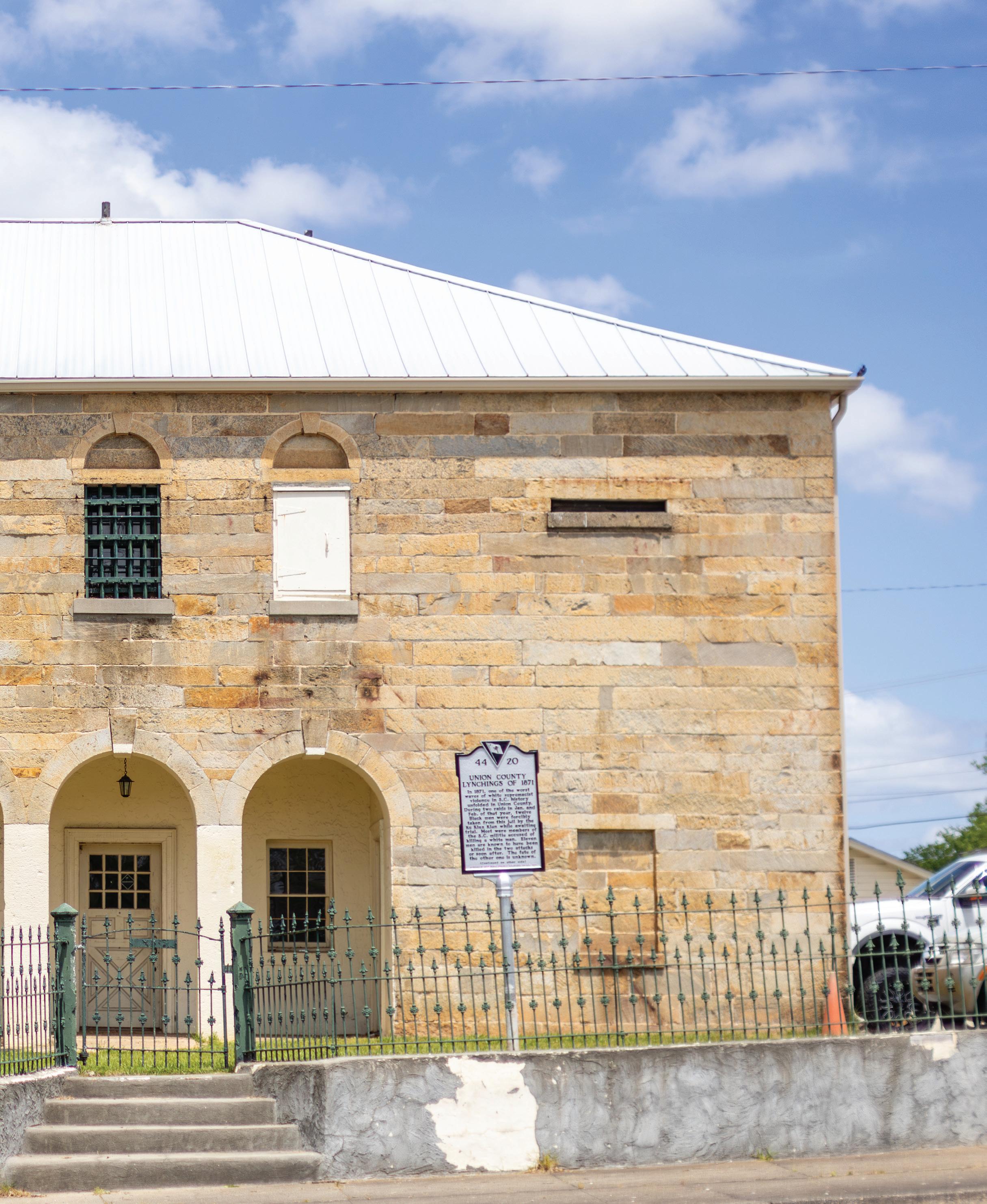
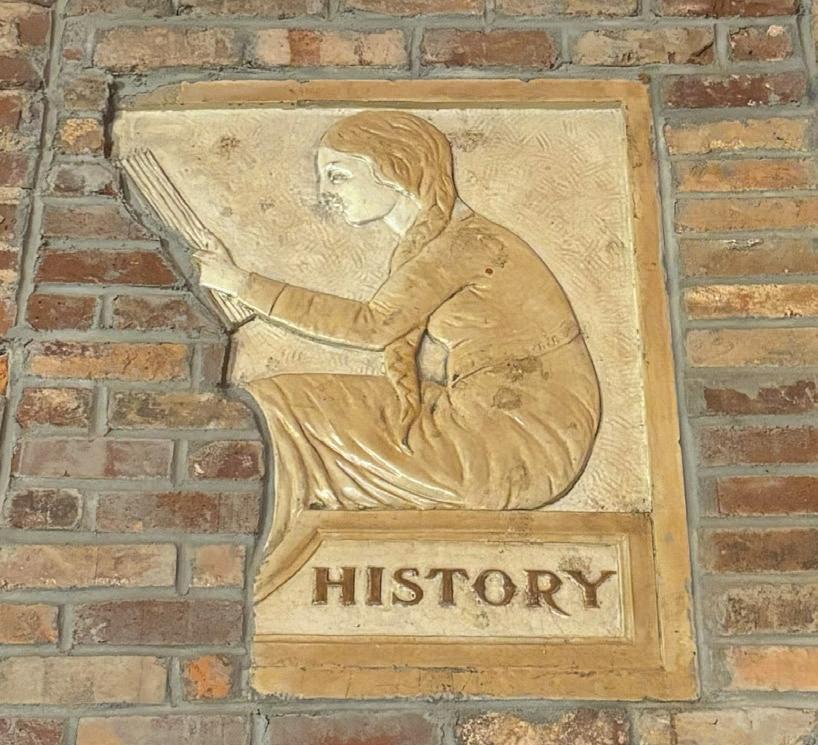

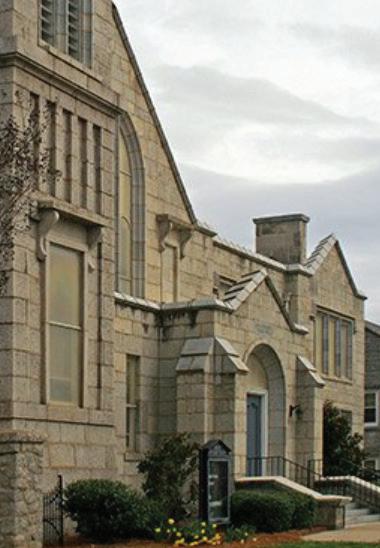
The Appalachian Regional Commission (ARC) is an economic development partnership of the federal government, 13 states, and 423 counties which is dedicated to improving the economic conditions throughout the Appalachian region. The ARC collaborates with the states and local communities to provide grants supporting a wide range of economic development initiatives. One of the five strategic investment goals identified by ARC is, “Building Regional Culture and Tourism: Strengthening Appalachia’s community and economic development potential by preserving and investing in the region’s local, cultural heritage and natural assets.”
Union County became a member of this partnership in 2021 and is now one of only seven northwestern counties in SC eligible for grant funding through ARC. Other counties include Anderson, Cherokee, Greenville, Pickens, Oconee, and Spartanburg. Because it is considered to be among the most economically depressed areas in the country, Union is the only county in SC designated as “distressed” by ARC for FY2025. This status makes Union County organizations eligible for grants that pay up to 80 percent of total project costs for tourism related development that benefits the local economy.

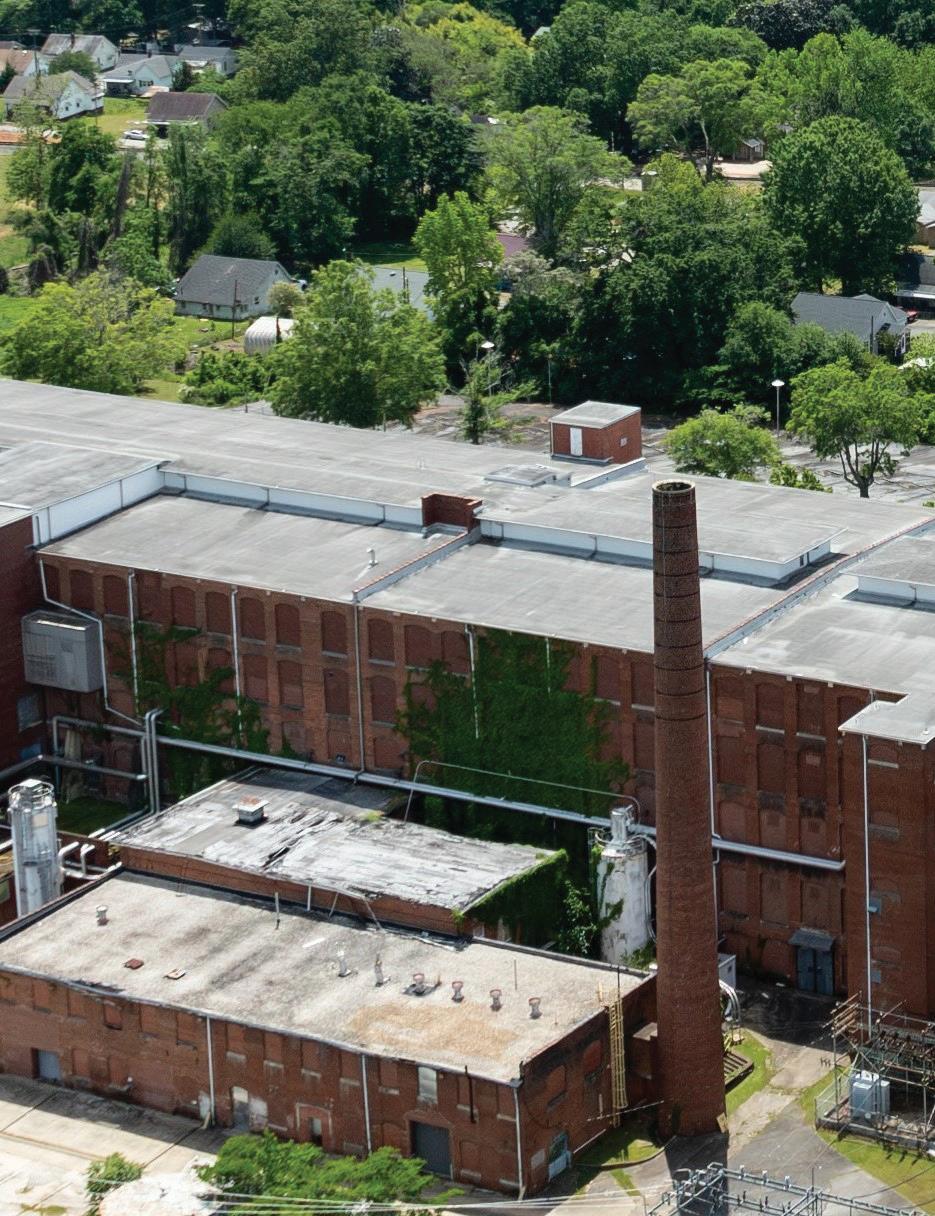
This section provides an overview of population, income, and employment data for Union County residents, as reported by the U.S. Census Bureau and the South Carolina Department of Commerce. The information highlights key demographic trends, economic conditions, and employment patterns within the county, offering a better understanding of the local workforce and economic landscape.
According to the latest decennial census, in 2020 Union County was home to an estimated 27,240 residents. The County population has declined 6 percent since 2010, representing 1,721 fewer residents. The City of Union has also experienced negative population growth in recent years, decreasing by an estimated 119 (1.5%) residents from 2010 to 2020. In 2020, Union County ranked 35 out of 46 South Carolina counties by total population, 12 out of 13 South Carolina Micropolitan Statistical Areas, and 452 out of 543 U.S. Micropolitan Statistical Areas.
Of the people living in the County in 2020, sixty-four percent were classified as rural and thirty-six percent as urban. However, it is estimated that 50 percent of the population resides within five miles of the urban core of Union.
Fifty-eight percent of the Union County population is considered working age, or between the ages of 18-64. The median age in the County is 44. The per capita income in 2022 was $26,111 while the median annual household income at the time was reportedly $42,305. County residents earn less compared with both the South Carolina average income ($36,072) and median household income ($63,623). The County performed lower in comparison with the 2022 national per capita income ($41,261), and the national median household income ($75,149) was somewhat higher than in Union County. It is believed that approximately 20 percent of all Union County residents live in poverty, which is about 1.5 times both the national and state rate for this important economic indicator. However, with an average unemployment rate of only 4.2 percent in March 2024, the largest employment sectors in the County include manufacturing, retail trade, health care, and education.
*2020 US Decennial Census
44.2 Age
Median age
about 10 percent higher than the figure in South Carolina: 40
about 20 percent higher than the figure in United States: 38.5
Income
$26,111
Per capita income
about 75 percent of the amount in South Carolina: $36,072
about 60 percent of the amount in United States: $41,261
$42,305
Median household income
about 65 percent of the amount in South Carolina: $63,623
about 60 percent of the amount in United States: $75,149
The consultant team examined a range of previous plans for the region, including comprehensive land use plans, downtown revitalization strategies, and transportation initiatives. These plans address various aspects of land use, outdoor recreation, tourism, and economic development. They are organized chronologically for clarity and context.
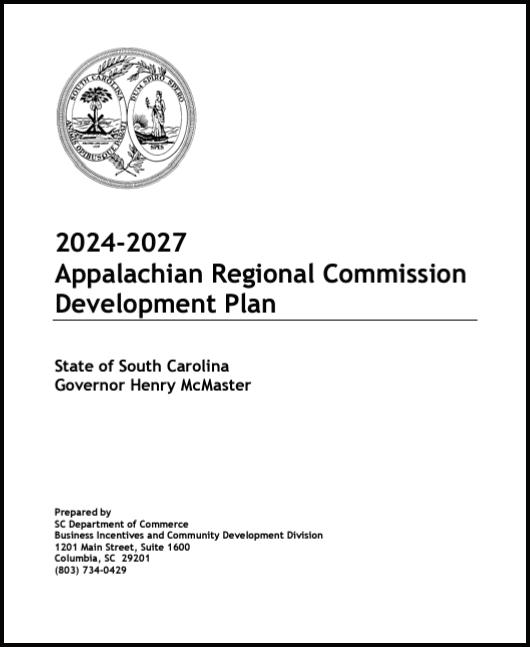
This plan, developed by the State of South Carolina, outlines strategies for economic growth in the Appalachian region aligned with the Appalachian Regional Commission’s (ARC) mission to invest in projects that uphold fundamental economic development principles. One of ARC’s primary goals is “Building Regional Culture and Tourism.” The strategies aim to enhance economic opportunities by fostering a ready workforce, developing critical infrastructure, leveraging natural and cultural assets, and building community leadership and capacity. The plan prioritizes specific state goals and objectives, details project eligibility and evaluation criteria, and defines output measures. It also discusses the roles of state and regional agencies, as well as the importance of both public and private partnerships in achieving these goals. It also describes the relationship between economic development in the Appalachian region of the state and Appalachian Development Highway System corridors.
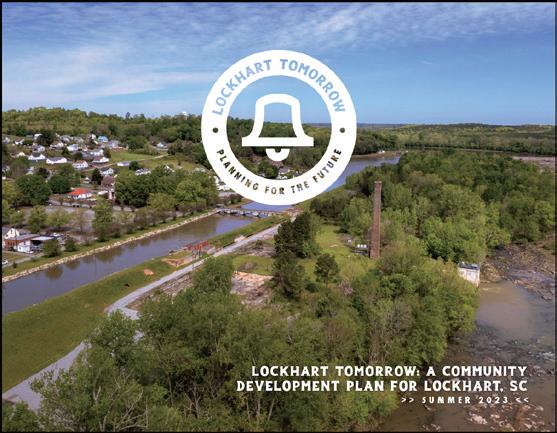
The “Lockhart Tomorrow” community development plan serves as the primary framework for community and economic development in the Town of Lockhart. The planning process engaged local stakeholders to cast a shared vision for the future. The plan aims to leverage available resources and assets to improve the community’s built environment and stimulate local economic growth. It identifies three key focus areas: the Town Square, On the River, and the Village Grid, each having distinct opportunities for enhancement and revitalization. The plan includes a list of general recommendations alongside an implementation matrix, detailing recommended actions and their estimated costs. Additionally, it outlines potential funding sources and identifies key grant-making agencies that can support these initiatives.

The Catawba Regional Comprehensive Economic Development Strategy (CEDS) is the outcome of a formal planning process mandated by the U.S. Economic Development Administration. The development of a CEDS enables access to federal economic development and grant assistance programs. Produced by the Catawba Regional COG, this strategy serves its local government partners in collaboration with key economic development stakeholders, including the SC Department of Commerce and the Union County Development Board, and serves as a blueprint for coordinating economic development efforts across the region. It includes an analysis of critical factors such as population growth, employment sectors, commuter patterns, and industrial clusters, that influence regional economic trends. The region’s strengths and opportunities, strategic location, strong partnerships, and existing infrastructure, are discussed and its perceived weaknesses and threats, workforce development, affordable housing, and the availability of industrial sites, are also explored. The promotion of cultural resources and environmental protection are considered issues important to the region’s future growth potential and economic development needs.
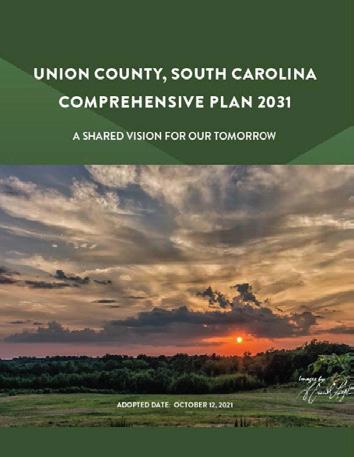
The Union County Comprehensive Plan outlines the County’s adopted policies designed to guide growth and new development while preserving the County’s cultural and natural heritage. Its primary goals focus on neighborhood protection, housing, historic preservation, transportation networks, utility infrastructure, active living, and natural resource conservation. The plan emphasizes the County’s potential for outdoor recreation and nature-based tourism as key areas for future economic development. To support these initiatives, it proposes strategies for financing capital improvements and encourages economic growth through public-private partnerships. By aligning educational and recreational initiatives with growth management and strategic public investments, the plan aims to foster a sustainable and prosperous future for Union County.
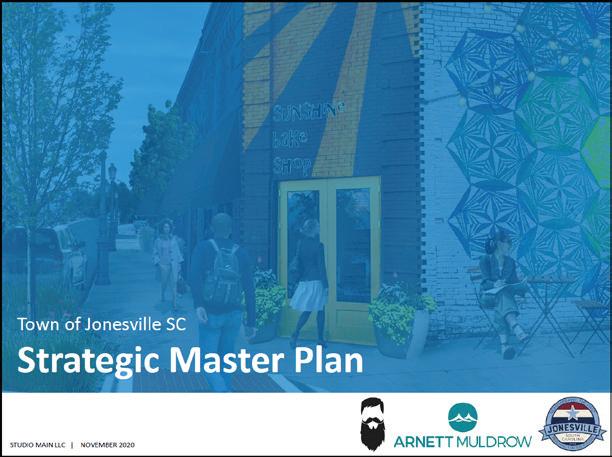
The strategic plan for Jonesville provides a collaborative framework for community input and visioning. It begins with a market analysis to identify economic leakage and opportunities for growth, followed by a branding and marketing strategy aimed at enhancing the town’s identity and attracting visitors and businesses. The Strategic Master Plan outlines specific project goals, including developing a strategic vision for the town, creating a vibrant sense of place, and fostering new business opportunities. Additionally, the plan emphasizes connectivity and safety within the community. An implementation matrix details actionable steps and timelines, ensuring that the plan is executed effectively, setting the stage for Jonesville’s sustainable growth and revitalization.
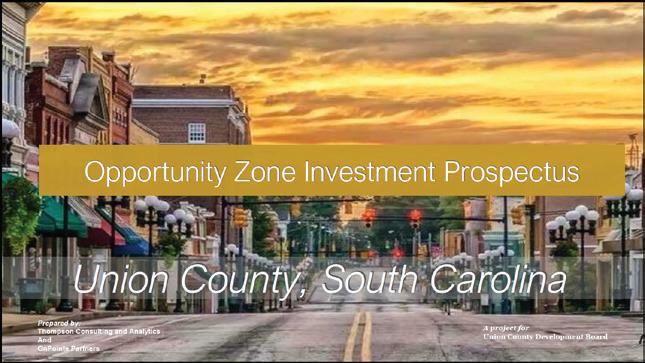
This prospectus highlights why investing in Union County is a smart business decision. The county’s probusiness policies are crafted to cultivate a diverse economy that appeals to businesses, industry, and innovative organizations. The report emphasizes how the combination of low overhead, an affordable cost of living, and a business-friendly environment fosters growth and promising returns on investment. Union County is well-positioned to offer employers a highly trained and skilled workforce, supported by a robust transportation system that ensures excellent access to the Opportunity Zone located in the City of Union. The area’s strong infrastructure is conducive to new business ventures and has ample space available for commercial, retail, restaurant, and recreational opportunities. Furthermore, Union County’s collaborative approach among local governments and stakeholders is recognized for its effectiveness in creating unique opportunities for investment and development.
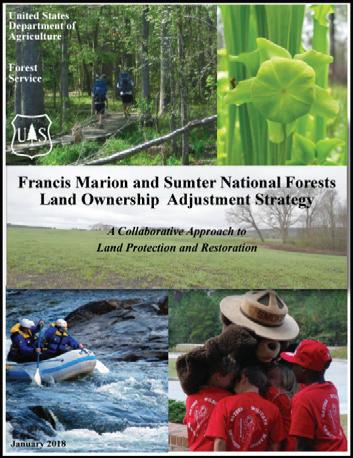
The Land Ownership Adjustment Strategy (LOAS) integrates partner objectives and evaluates opportunities for land protection and restoration, ensuring that future restoration efforts are rooted in collaborative, forward-thinking planning. The recommendations outlined in this strategy stem from workshops and discussions held with district partners, focusing on landscape-scale protection and restoration goals in South Carolina. Additionally, related planning initiatives, such as recreation realignment, along with local and state government efforts, have also shaped this plan. Participants in the LOAS process identified and shared key priorities for land protection and restoration, ensuring that any expansion of National Forest System lands enhances management efforts and adds value to local communities.
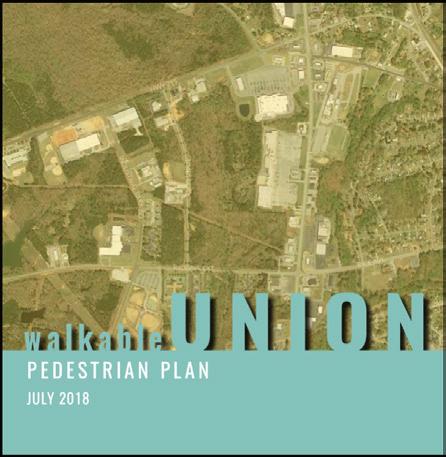
The Walkable Union Pedestrian Plan is guided by three key principles: equitybased planning, access to healthy foods, and inclusive community engagement. These principles aim to promote healthy eating and active living, particularly for the community’s most vulnerable members. The plan focuses on improving the pedestrian and bicycle network, emphasizing critical crossing connections at US-176 as well as north-south and east-west routes. It also includes programmatic recommendations designed to enhance walkability throughout Union.
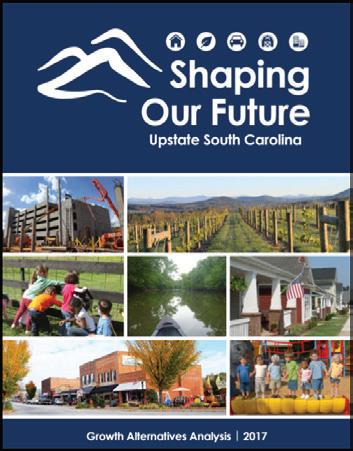
The Shaping Our Future initiative, led by the Shaping Our Future Consortium, examines alternative growth patterns through scenario planning. This collaborative effort involves a diverse group of stakeholders, including elected officials, businesses, local governments, schools, and environmental organizations. The study evaluates the impacts and trade-offs of different growth choices, offering valuable insights for community plans, policies, and studies. It advocates for a balanced approach that prioritizes proactive planning, informed policy decisions, and active community engagement to achieve desired outcomes while preserving quality of life. The findings serve as a resource for constructive discussions on growth options, highlighting the importance of relationship-building, knowledge enhancement, and coordinated infrastructure development in shaping a resilient and vibrant future for the region.
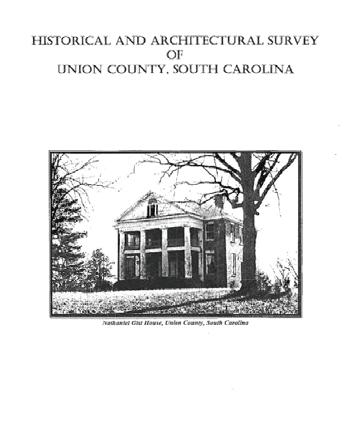
The Palmetto Conservation Foundation has conducted a comprehensive survey of Union County to identify properties of significant architectural and historical value. This survey not only serves important historic preservation goals but also acts as a valuable resource for promoting heritage tourism in the area. The document includes a historical overview of Union County and its surroundings, tracing the earliest European settlements in the upstate region, which began in the mid-1700s with Scots-Irish pioneers. It explores the region’s extensive military history, agricultural economy, textile industry, and the evolution of transportation networks. Key highlights include public works projects vital to the County’s development as well as the establishment of the railroad and highway systems that facilitated robust commerce for many decades. The survey also offers recommendations for historic preservation, land use planning, and initiatives to enhance public awareness, ensuring the county’s rich heritage is celebrated and protected for future generations.
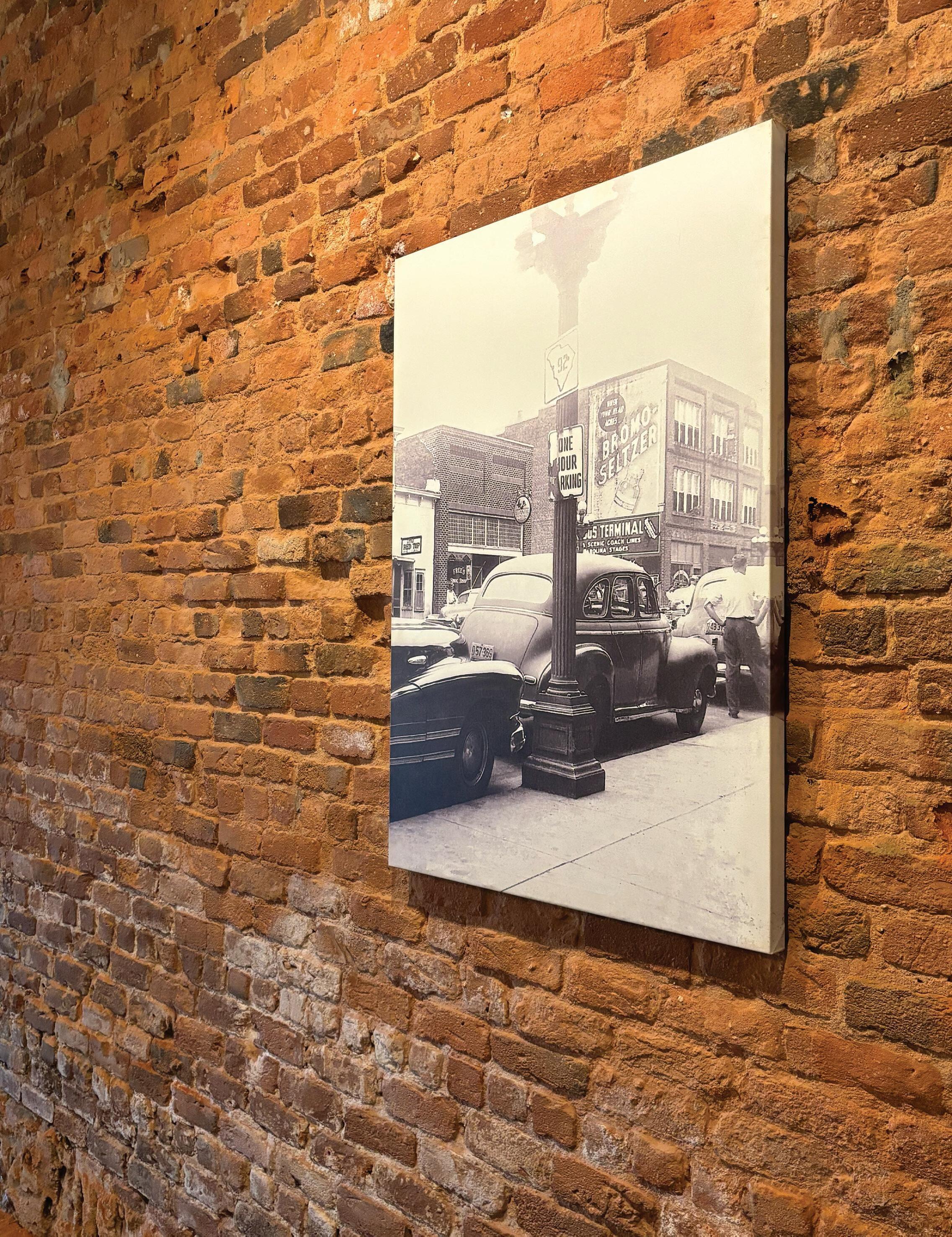
This section provides an overview of existing Union County tourism assets, including:
1) Historic & Cultural Resources; 2) Natural Resources; 3) Outdoor Recreation & Managed Areas; 4) Agritourism; 5) Sports Tourism; and 6) Main Street Communities.
Mountain bike trails
Palmetto trail
Equestrian trails
Hiking trails
Major rivers
MAIN STREET COMMUNITIES
1. Town of Carlisle
2. Town of Jonesville
3. Town of Lockhart
4. City of Union
HISTORIC & CULTURAL RESOURCES
1. Buffalo Mill Historic District
2. Cross Keys House 3. Musgrove’s Mill Historic Site 4. Rose Hill Plantation 5. Carnegie Library
Union Historic District 7. Union County Historic Jail 8. Union County Museum
OUTDOOR RECREATION & MANAGED AREAS 1. Flat Stack Trail
Foster Park
John D. Long Lake
The Palmetto Trail
Pacolet River Blueway
Piedmont Physic Garden
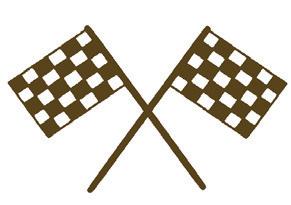
Broad River
Enoree River
Pacolet River
Sumter Natl. Forest
Tyger River
Belmont Farm
Chastain Place
Cross Anchor Farm
Farm at Hully Bridge
Hereford Hills
Roger’s Farm
Rolling Hills Farm
Sheeply Farm
Six Oaks Farm
Wildwood Ranch
Union Co. Fairgrounds
Aloha Acres
Sunset Farm

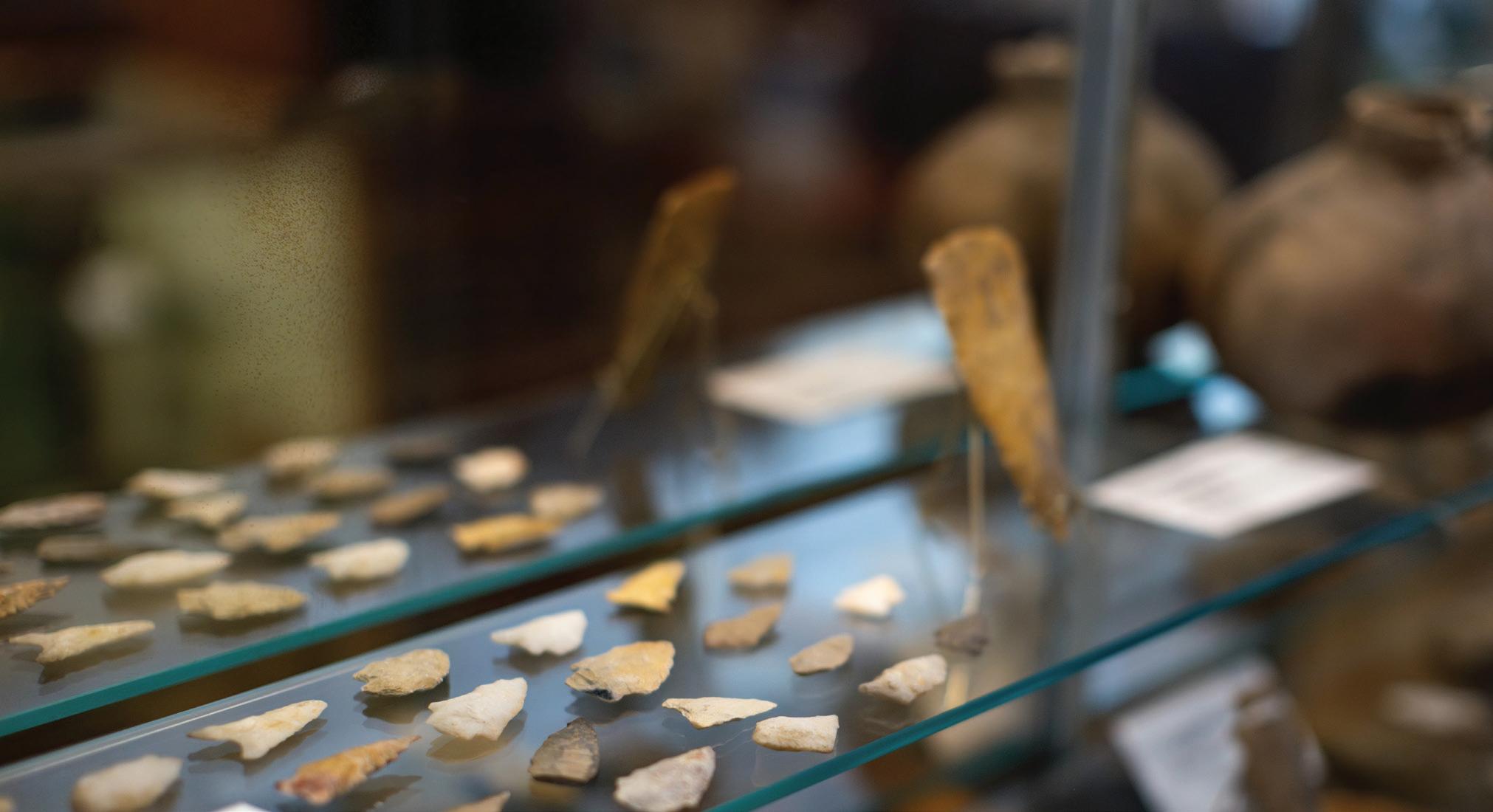
Union County is steeped in the rich cultural and historical traditions of the Southern Appalachians. The region’s vibrant local culture is evident in its cuisine, music, arts and crafts, and a variety of other enduring traditions. This proud heritage not only adds depth to the community but also highlights the unique character of an area that has played a significant role in American history for centuries. Union County’s involvement in pivotal events, such as the American Revolutionary War, the Civil War, and the Civil Rights Movement, is carefully documented at several museums and historical sites across the region, offering a window into its profound historical and cultural impact.
• Buffalo Mill Historic District
• Carnegie Library
• Cross Keys House
• L.W. Long Building
• Main Street Junction
• Musgrove’s Mill Historic Site
• Rose Hill Plantation
• Union County Historic Jail
• Union County Museum
• Union Historic District
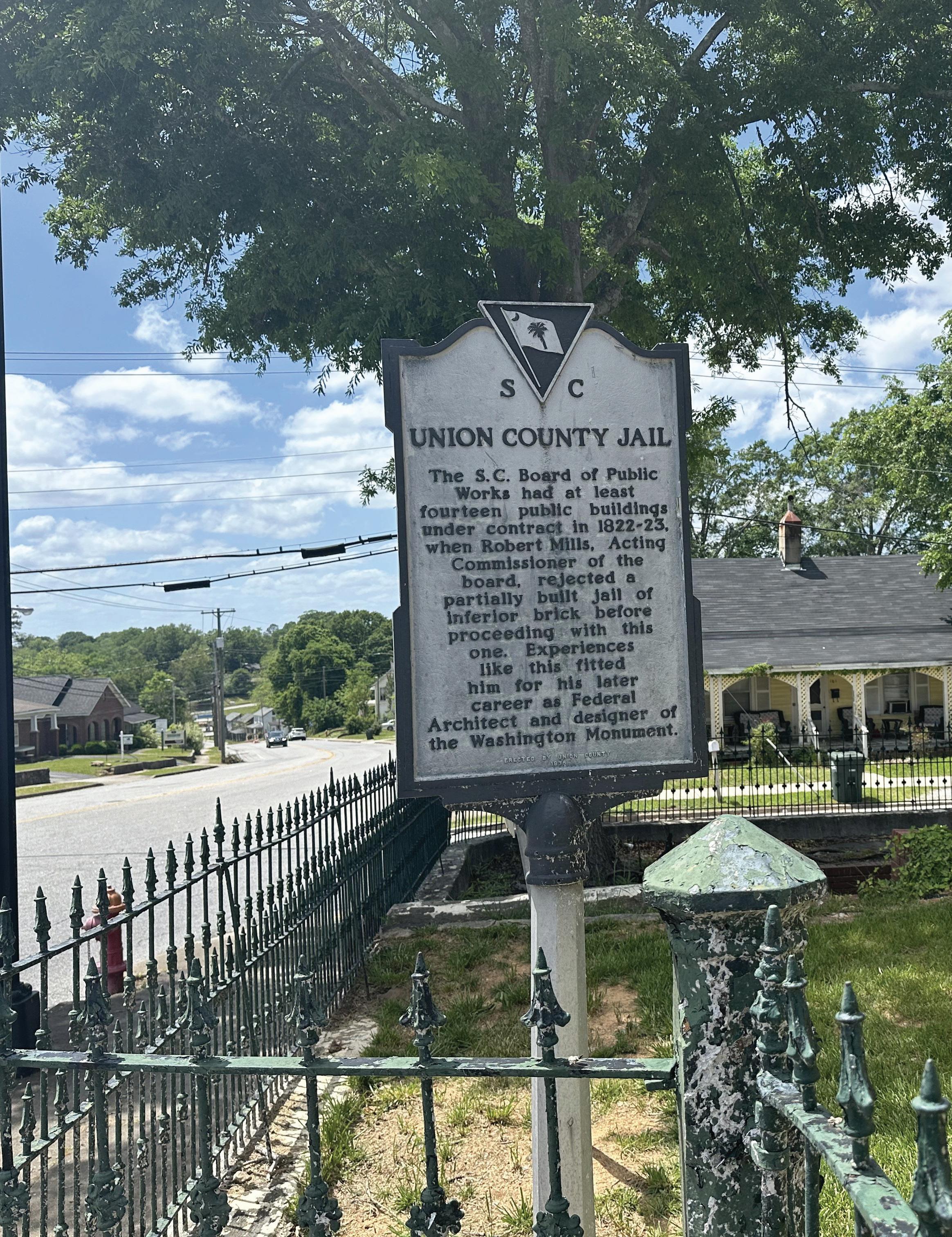
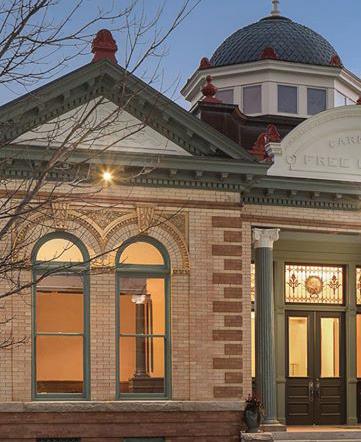
The Union County Library first opened in 1905 as the Carnegie Free Library and was made possible by the generosity from industrialist and philanthropist Andrew Carnegie. This architectural treasure has since been restored to its original glory and was listed in the National Register of Historic Places in 1983 as part of the South Street Historic District. It not only provides space for essential community services like United Way and workforce development, but it also serves as the academic library for USCUnion, making it a central hub for cultural and educational activities in Union County.
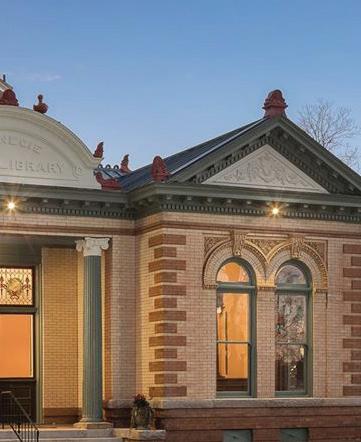
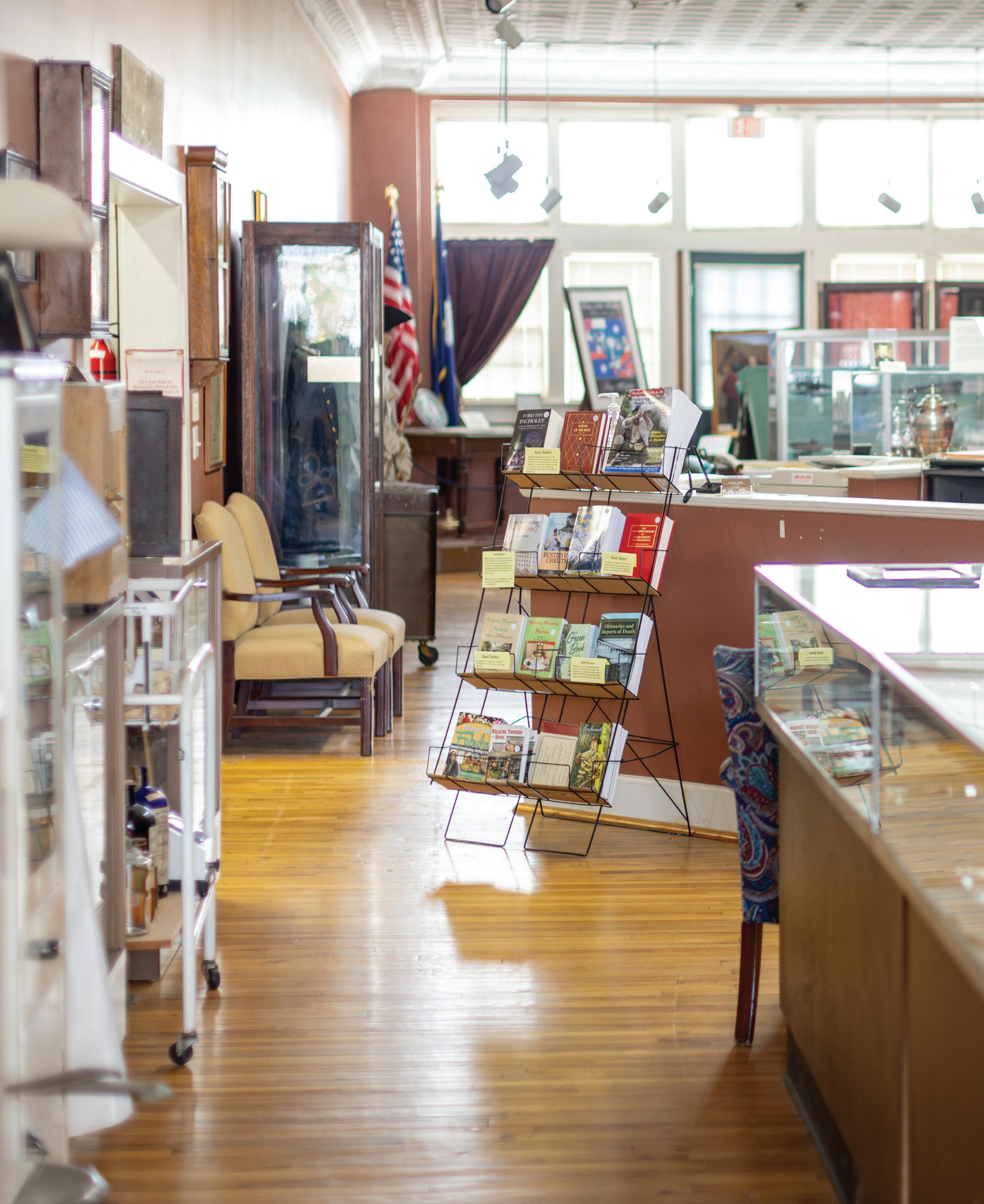
The Union County Museum is dedicated to preserving the past for future generations and is prominently situated on Historic Main Street in Union. A cherished local asset, the museum has been recognized as the “Best Local Museum in South Carolina.”
Inside, visitors can explore a rich collection of historical items, including photographs, paintings, books, and various artifacts and antiques that tell the story of yesteryear in Union County. Additionally, the museum boasts one of the largest genealogical research collections in South Carolina, making it a valuable resource for those tracing their roots and exploring the region’s history.

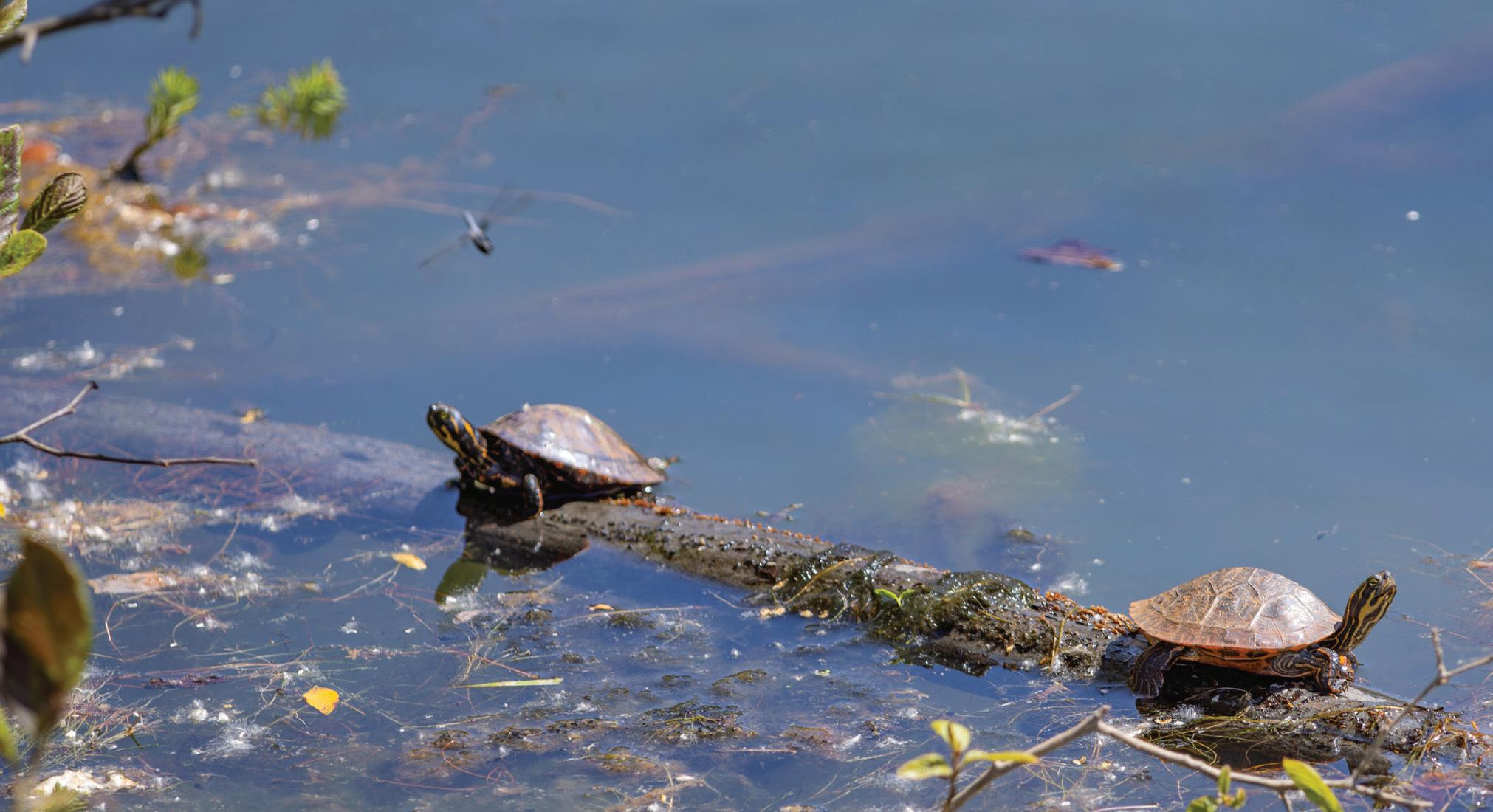
Natural resources are vital for tourism development, environmental sustainability, and the overall well-being of communities. These renewable resources include forests, which provide timber, fuel, and wildlife habitat, and surface water, which is essential for drinking, irrigation, and industry. Union County’s diverse landscape, featuring rolling hills, vast forests, extensive streams, lakes, and watersheds, provide the region with tremendous assets.
• Sumter National Forest
• Broad River
• Enoree River
• Pacolet River
• Tyger River
The Sumter National Forest provides unique outdoor recreation and nature based tourism opportunities. The largest areas of protected federal lands in this area are in the Enoree Ranger District in southern and eastern parts of Union County. The Enoree Ranger District comprises approximately 55,000 acres within the county and 170,000 within the region overall. This natural resource attracts thousands of visitors annually and the economic, recreational, and biological significance of the asset is undeniable.
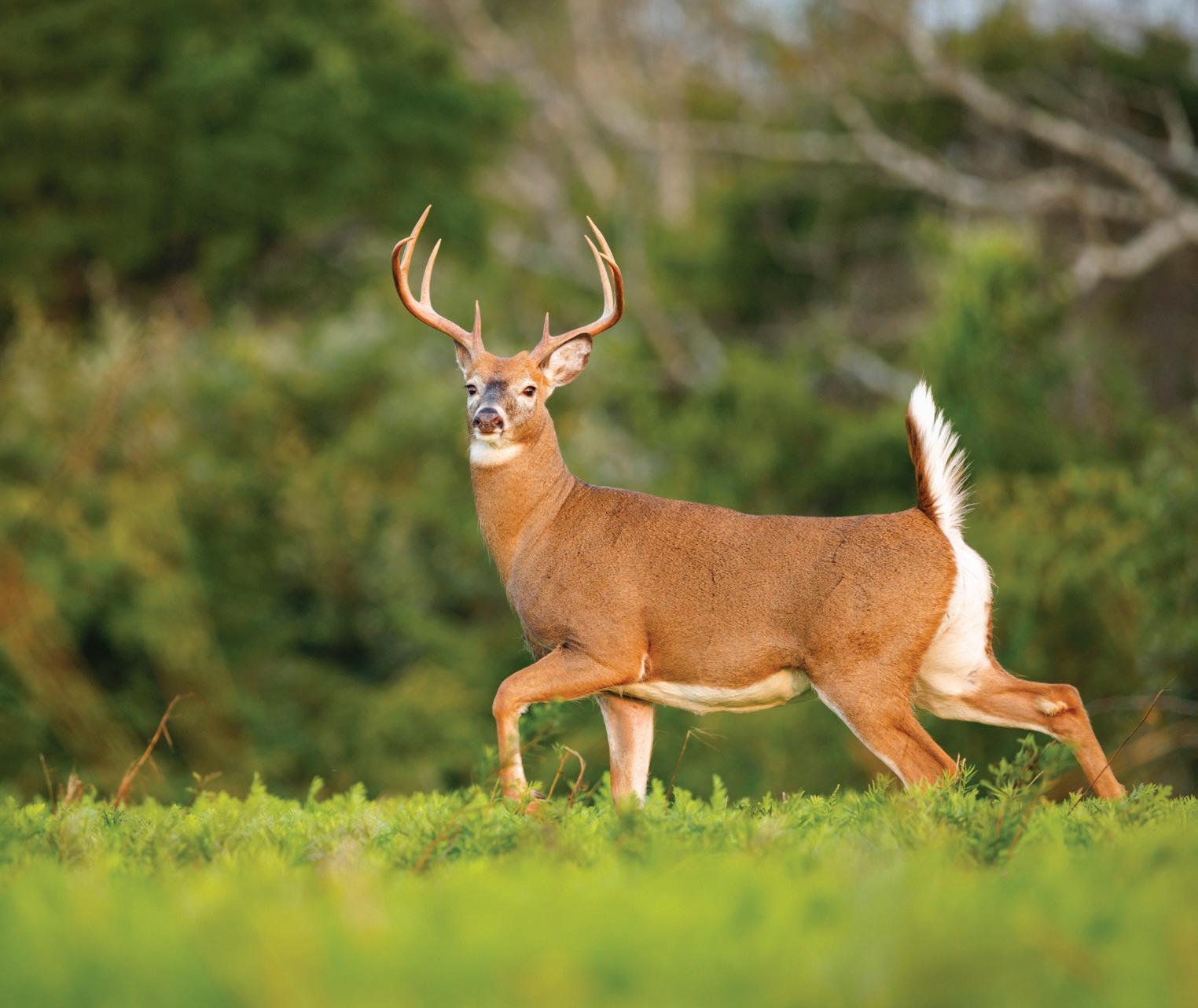
The Broad River originates in North Carolina and flows into South Carolina, receiving drainage from both states along its journey. In South Carolina, the Broad River Basin spans the Piedmont region and covers over 2.5 million acres, including the Enoree, Tyger, and Pacolet River basins. Within this expansive area, there are approximately 10,000 miles of streams that contribute to the Broad River Basin in South Carolina.
The Broad and its tributaries flow southward through Union County, supplying drinking water to much of the City of Union. Continuing its journey, it eventually converges with the Saluda River near Columbia, where it forms the Congaree River. The river then feeds Lake Marion and Lake Moultrie and ultimately becomes the Cooper River before entering the Atlantic Ocean at Charleston.
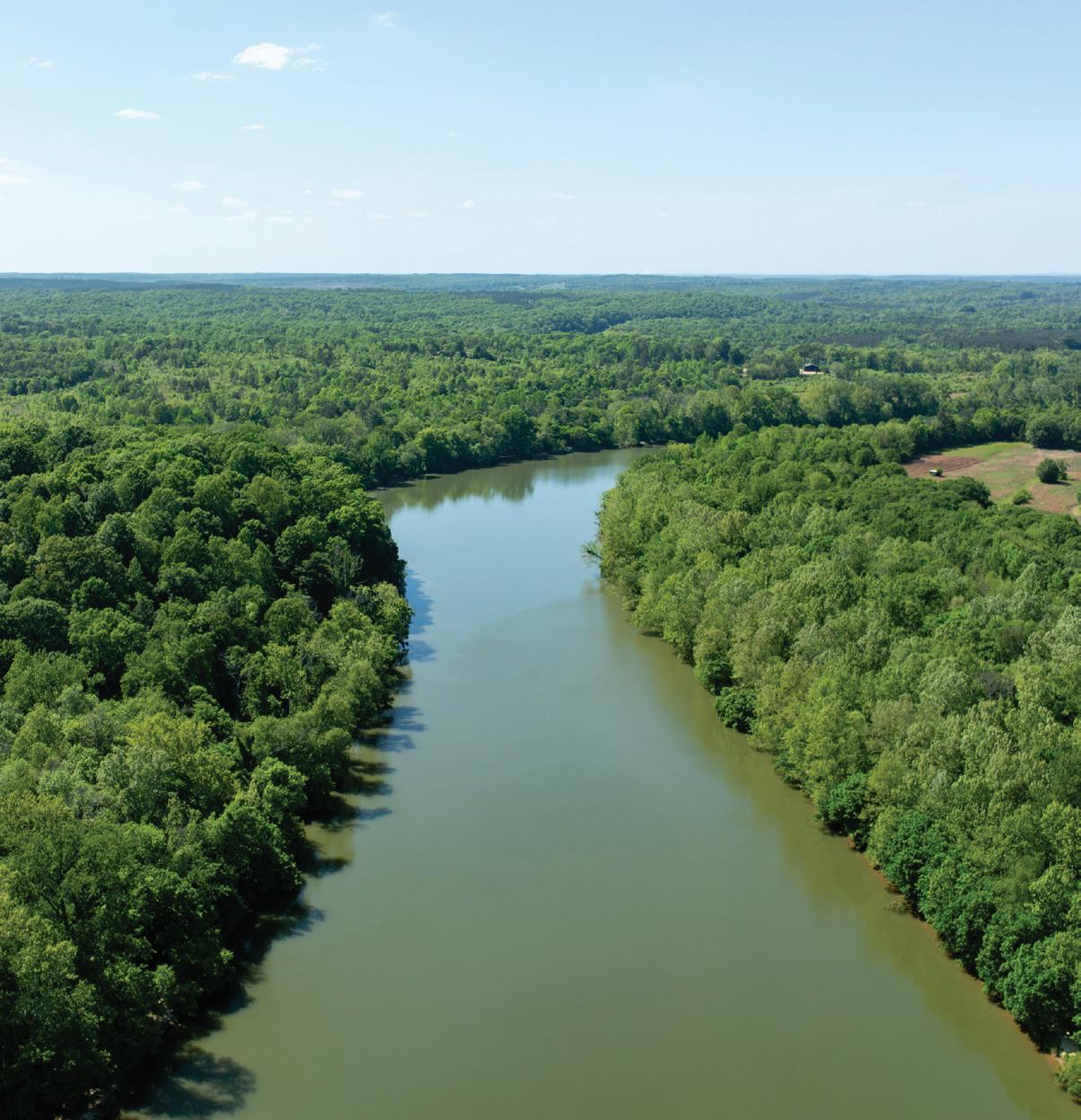

Union County has a wealth of managed areas with significant opportunities for outdoor recreation activities. Renowned for its stunning natural landscapes and diverse ecosystems, the region is a haven for those with a penchant for outdoor adventure.
This area is a true paradise for outdoor enthusiasts and features a range of popular activities that cater to nature lovers and thrillseekers.
There are abundant hunting grounds for the pursuit of deer, wild turkey, and other small game that can provide a rewarding experience for both novice and seasoned hunters. Scenic rivers and lakes offer serene and natural settings for paddling and boating as well as excellent fishing spots where anglers can catch a variety of fish, including bass and catfish.
Numerous campgrounds and natural areas invite visitors to immerse themselves in the great outdoors. Featuring both tent camping and RV facilities, there are plenty of options for visitors to spend a night under the stars. For thrill-seekers, there are multiple trails suitable for horseback, mountain bike, and ATV rides.
• Buffalo Community Park
• Flat Stack Trail
• Foster Park / Veterans Park
• John D. Long Lake
• Pacolet River Blueway
• Piedmont Physic Garden
• Renaissance Community Park
• The Palmetto Trail
There are numerous opportunities to enhance existing blueway assets and develop new paddle trails on the region’s major waterways. Regional collaboration has played a crucial role in establishing the 30-mile Pacolet and Lawson’s Creek Blueway, which continues to progress. These blueways and paddle trails provide users with unique outdoor adventures in conservation areas while fostering connectivity between the various communities along the rivers.

This 80-acre reservoir, constructed in 1976 to honor the father of State Senator John D. Long III, is managed by the SC Department of Natural Resources. Its primary purposes are recreation and wildlife conservation. The lake presents a variety of outdoor activities, including paddling, fishing, hiking, picnicking, and nature watching. Along the western shoreline, visitors will find a ramp for non-motorized boats, a canoe launch, and a fishing pier to improve the recreational experience.
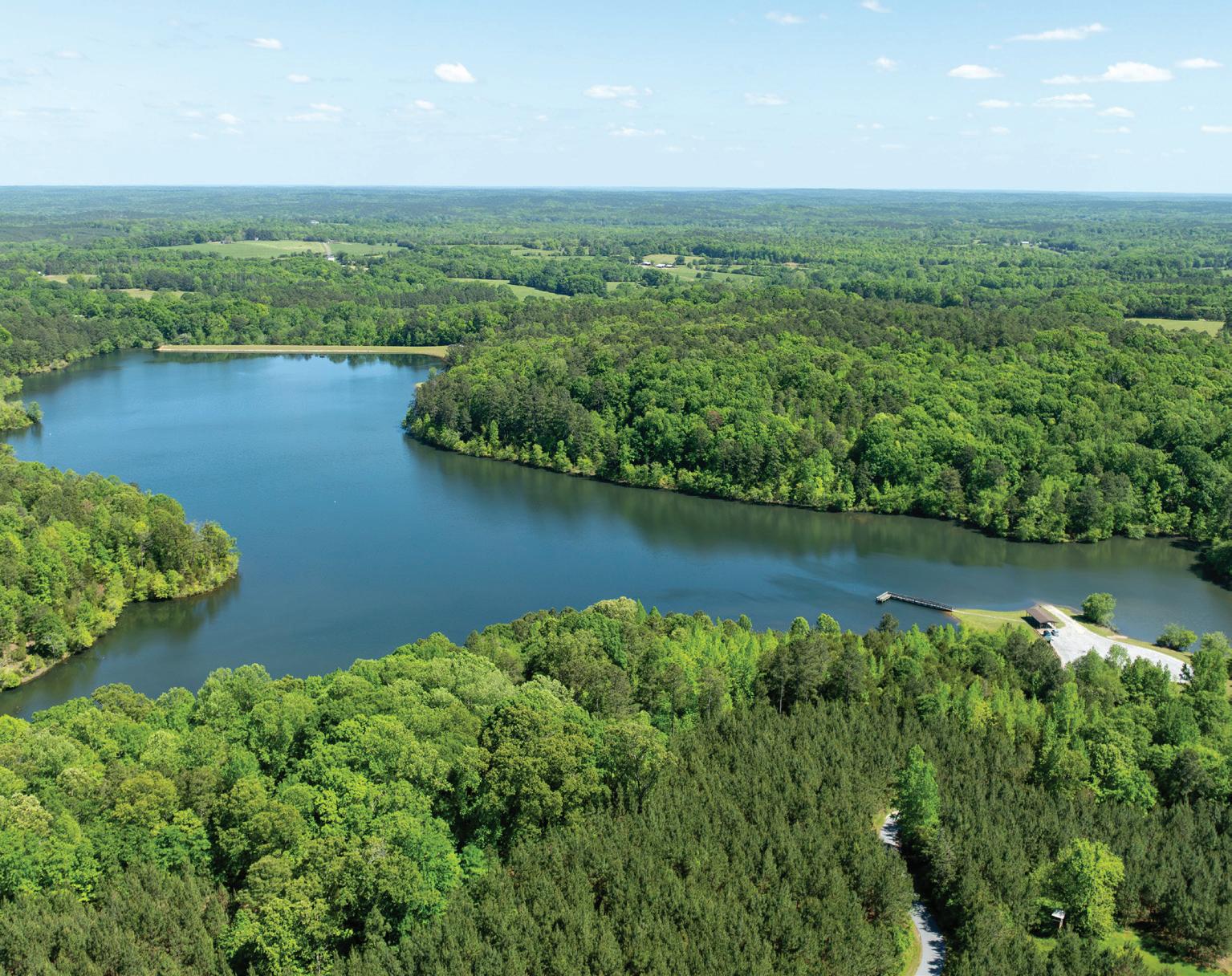
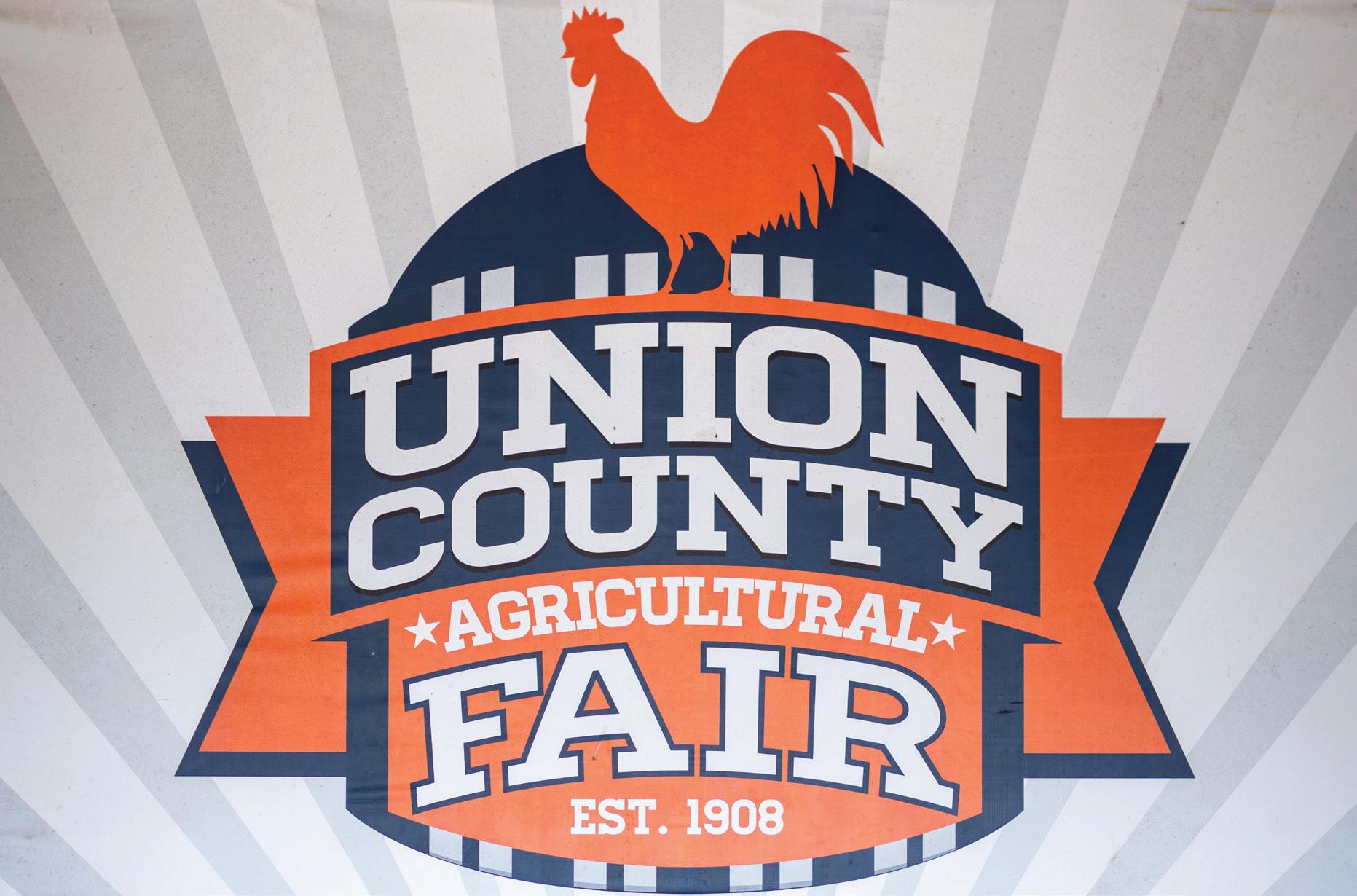
Agriculture is an important industry in Union County and has positioned the area as a leader in agritourism. The region’s rich agricultural assets significantly bolster the local economy and play a vital role in promoting tourism and community well-being. In 2017, there were 241 farms in Union County, comprising 43,765 acres, or 13 percent of the county’s land area. Pasture land and woodland comprised 77 percent, or 33,700 acres of the agricultural land. Livestock and poultry products accounted for 90 percent ($9,257,000) of all the agricultural products sold that year ($10,329,000). The numerous working farms in the county that are open to the public draw visitors seeking authentic experiences and enhance the county’s appeal to sojourners. The Union County Farm and Craft Market, located in downtown Union, offers myriad selections of produce, plants, and other goods and crafts for sale by local farmers and artisans.
• Aloha Acres
• Belmont Farm
• Chastain Place
• Cross Anchor Farm
• Farm at Hully Bridge
• Hereford Hills
• Roger’s Farm
• Rolling Hills Farm
• Sheeply Farm
• Six Oaks Farm
• Sunset Farm
• Wildwood Ranch
• Union County Fairgrounds
• Union County Farm and Craft Market
Farmers markets play a significant role in boosting tourism and economic development by attracting visitors who seek local, fresh produce and unique artisanal products. Additionally, they often stimulate related businesses, such as restaurants and shops, further contributing to the local economy. Overall, farmers markets serve as a catalyst for economic growth and tourism, fostering a deeper appreciation for local agriculture and culture. The Union County Farm and Craft Market not only supports local farmers and artisans, ensuring that money stays within the community, but also serves as a vibrant social hub that enhances the local culture. By promoting local food traditions and providing opportunities for community engagement, this market makes the region more appealing as a travel destination.

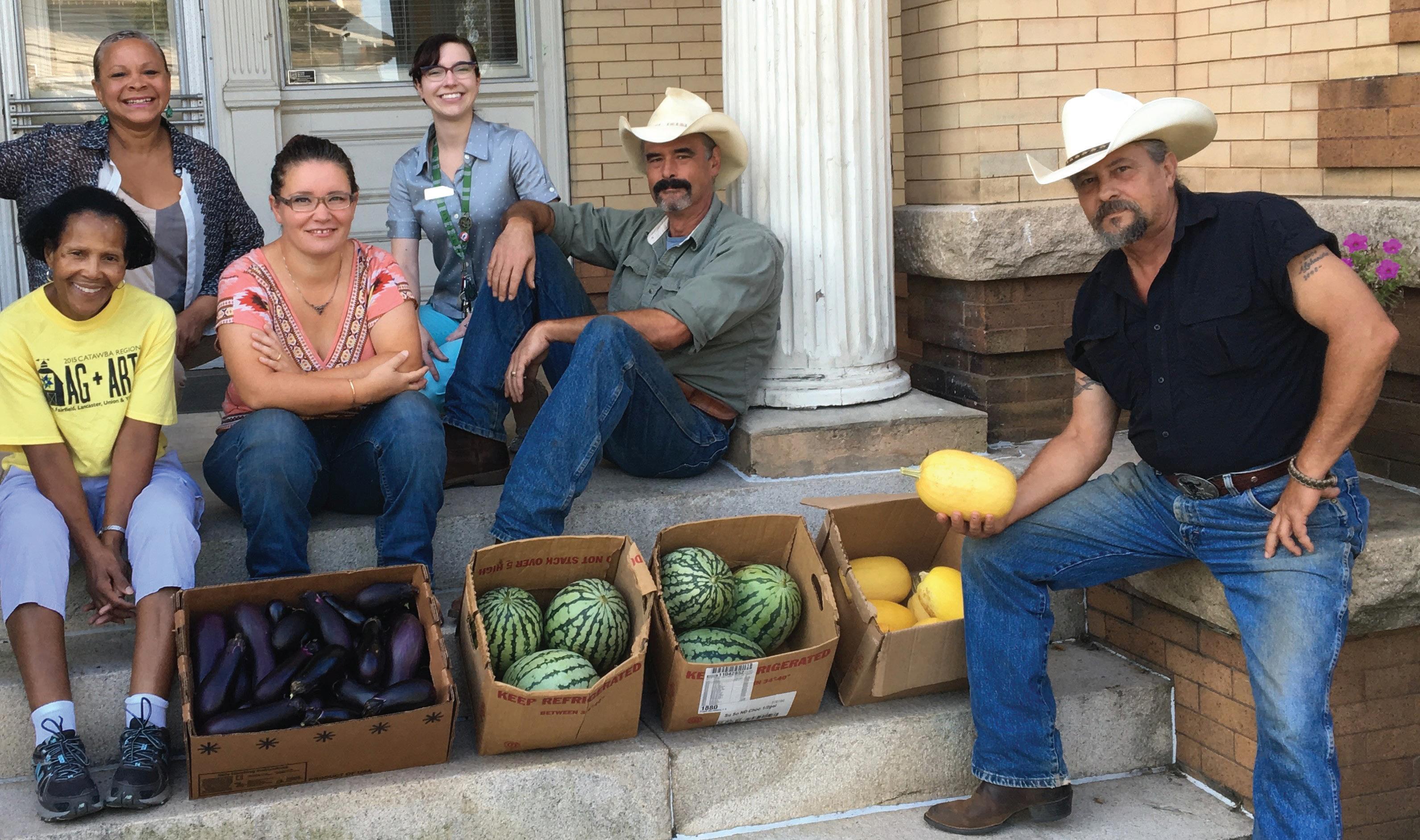
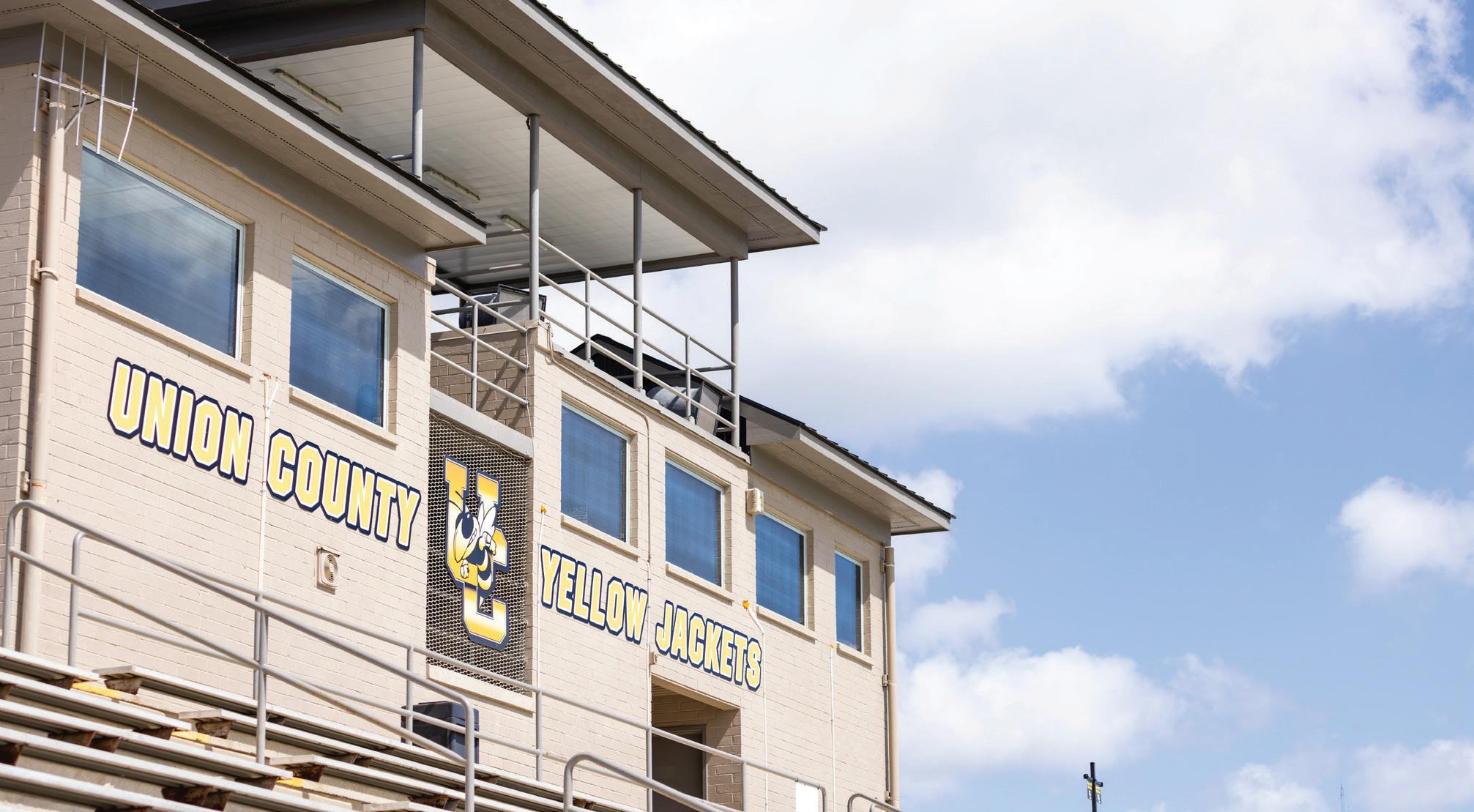
Sports tourism refers to travel specifically for the purpose of participating in or watching sporting events. This form of tourism can include a wide range of activities, such as travel associated with attending major sporting events (auto races, professional sports, etc.); participating in sports activities and competitions (marathons, golf tournaments, youth tournaments, etc.); training camps and clinics (specialized facilities for skill development); and participating in adventure sports (rafting, mountain biking, hunting, etc.). Sports tourism can contribute significantly to local economies by generating revenue from accommodations, dining, transportation, and other related services.
• Big Buck Motocross
• Little Brown Jug Enduro
• Revolution Park Motocross
• Silver Hawk Motocross
• Timken Sports Complex
• Union County Dragway
• Union County Stadium
Timken Sports Complex in the City of Union is a premier destination for tournaments, featuring seven versatile ball fields that attract teams and visitors from across the region. With fields suitable for youth baseball, fastpitch and slow pitch softball, and championship baseball, the complex hosts a variety of tournaments and events that boost local tourism and economic activity. Additional features include batting cages, a walking trail, and the Miracle League field and All Star Park, an all-inclusive playground for those with disabilities.
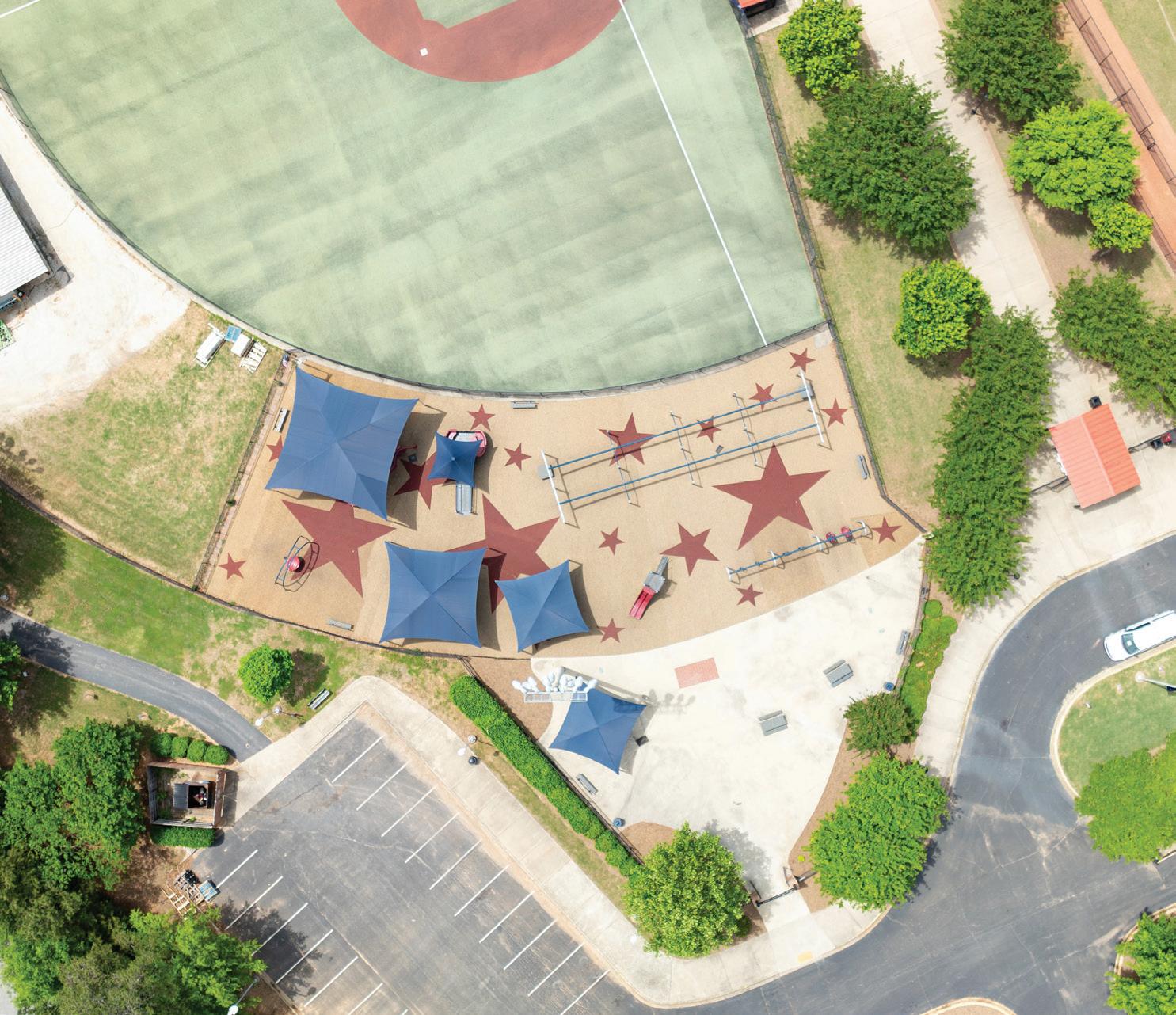
Union County is home to an exciting racing environment that attracts thousands of competitors and spectators. The enduring appeal of motorsports in the region continues to inspire new generations of racers and fans. Local facilities host numerous events that boost tourism and showcase Union County as a premier destination. Union Dragway draws competitors from across the country with a passion for drag racing. Known for its vibrant community atmosphere, the dragway fosters camaraderie among racers and fans alike. America’s largest off-road motorcycle and ATV racing series takes place at Big Buck Farm. Since its inception, over 19,000 riders from around the globe have participated in thrilling offroad races here, helping to make Union County a mecca for motorsports enthusiasts.

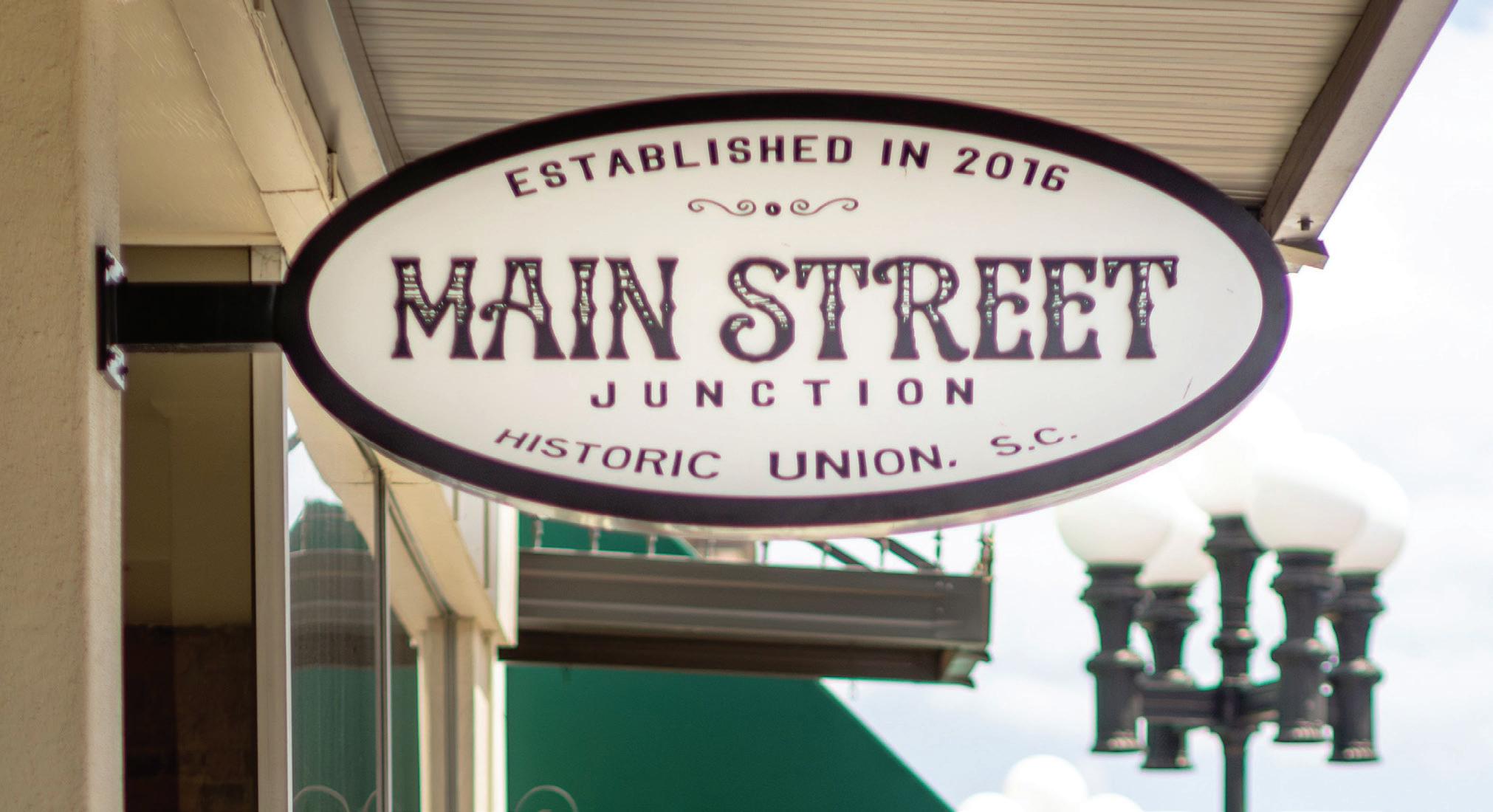
Union County’s historic downtowns are valuable tourism assets for the region. This section explores the historic Main Streets of Union County, highlighting the numerous opportunities to leverage the area’s rich small-town heritage while catering to tourist interests and supporting community development priorities.
• City of Union
• Town of Lockhart
• Town of Jonesville
• Town of Carlisle
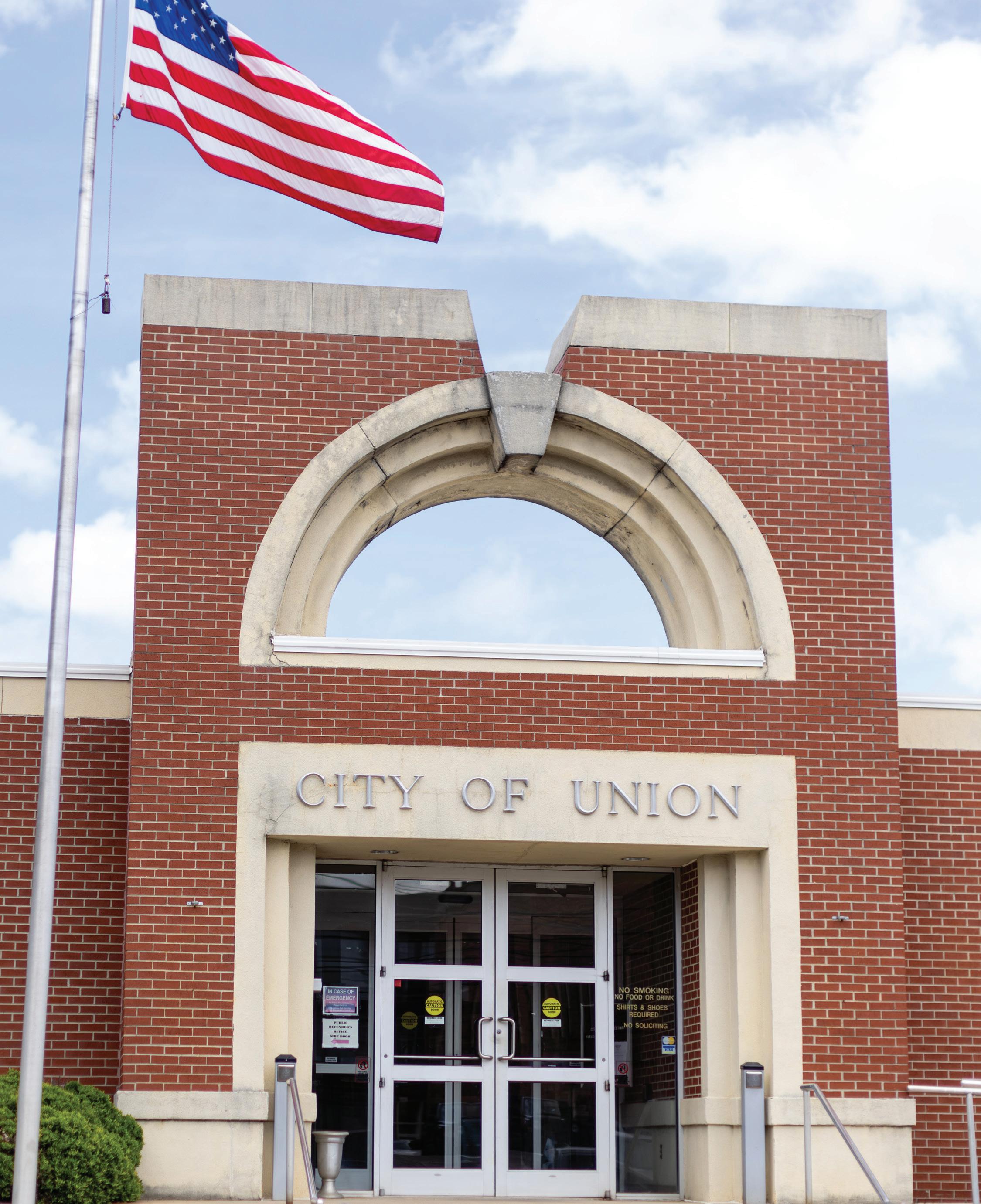
Downtown Union offers a blend of historic charm and community, making it a pleasant and welcoming place. The downtown area is home to a variety of local businesses, including antique shops, cafes, boutiques, and family-owned stores. These establishments offer a mix of unique goods and services, catering to both locals and visitors. Downtown Union hosts various community events
and festivals throughout the year, such as holiday parades and outdoor concerts, which help foster a sense of community. These events draw visitors, help boost the local tourism economy, and showcase the region’s cultural offerings. The City’s commitment to revitalizing its downtown area will help ensure that it remains a focal point for local culture and commerce and an important tourism asset.
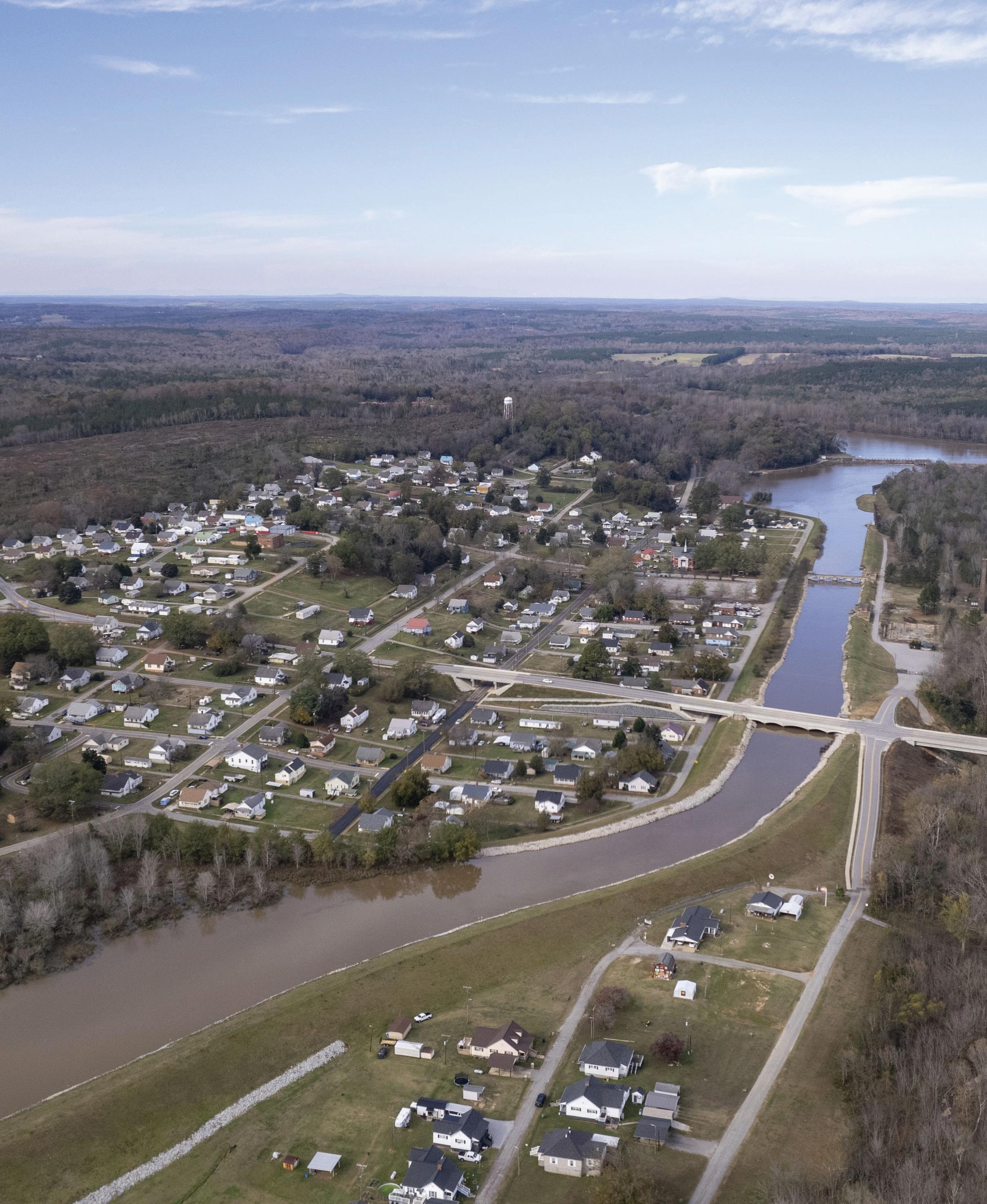
The Town of Lockhart, a historic mill village located on the Broad River in northeastern Union County, flourished for over a century alongside the local textile industry. However, the closure of Lockhart Mills in 1994 marked the beginning of a period of economic decline. In 2022, the town was awarded a planning grant from the
Appalachian Regional Commission (ARC) to develop a community development plan aimed at revitalizing the area and addressing the challenges brought about by the mill’s closure. “Lockhart Tomorrow” has identified tourism and outdoor recreation as possible growth sectors.
Jonesville is embracing a fresh perspective with the USC-Union Bantams men’s baseball and soccer teams now calling the town home. Jonesville Park, planned for development on the site of a former textile mill, will feature several new amenities, including playgrounds, picnic pavilions, and interpretive signage. Looking ahead, the town also plans to expand its trail network and create a connection between the USC-Union Bantams ballfield and downtown Jonesville, which is undergoing improvements with new streetscape elements as part of its downtown strategic master plan. As the local saying goes, “It’s a whole new ball game in Jonesville.”

The Town of Carlisle is conveniently located just 15 minutes from Union in the southern part of the county. The area offers an ideal setting for nature lovers seeking both adventure and tranquility. Just outside of town lies Sumter National Forest, a valuable natural asset renowned for its breathtaking beauty. This expansive forest is the perfect destination for a variety of outdoor activities, including camping, hunting, fishing, boating, horseback riding, and hiking, making the area a retreat for those who love the great outdoors.
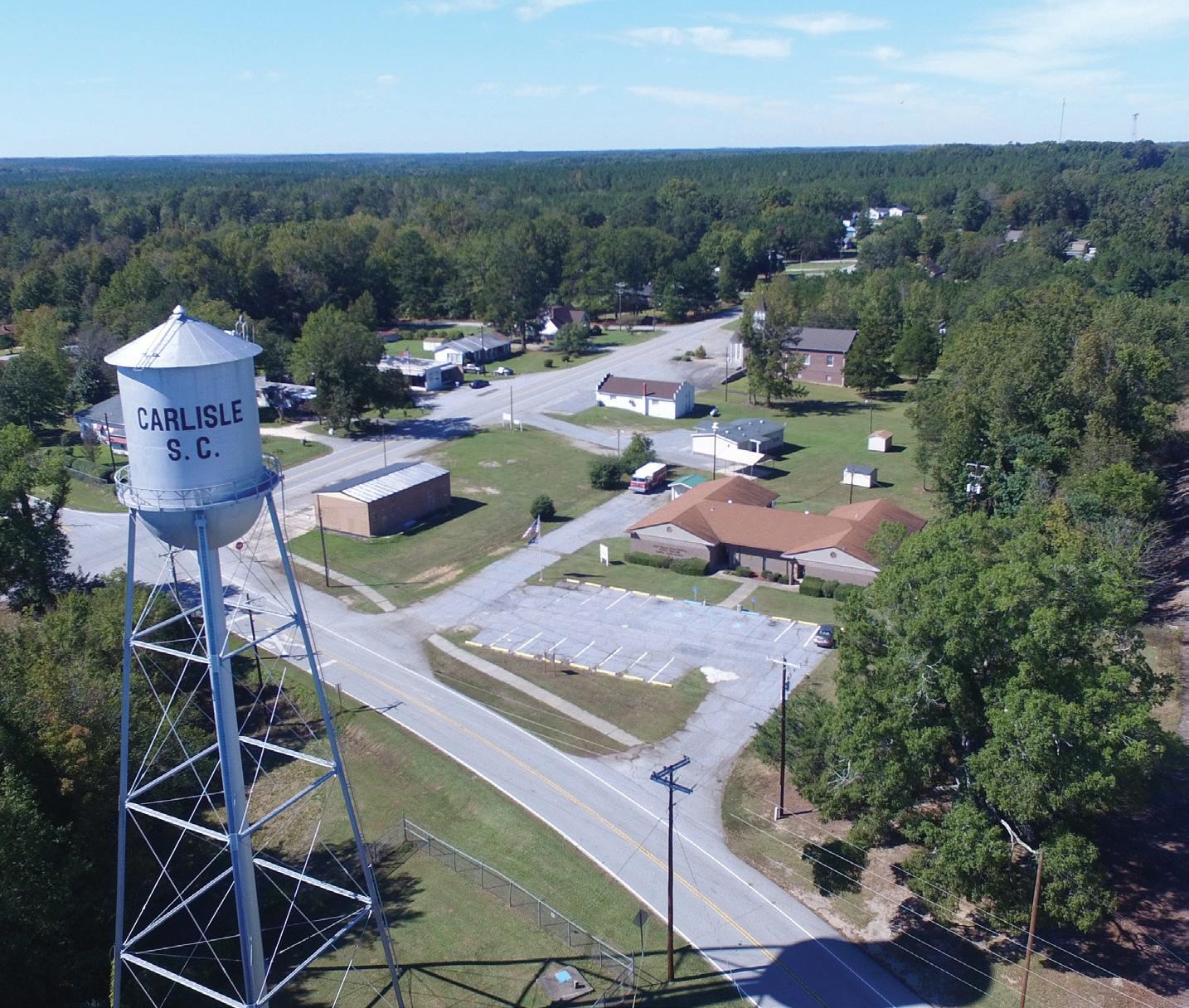
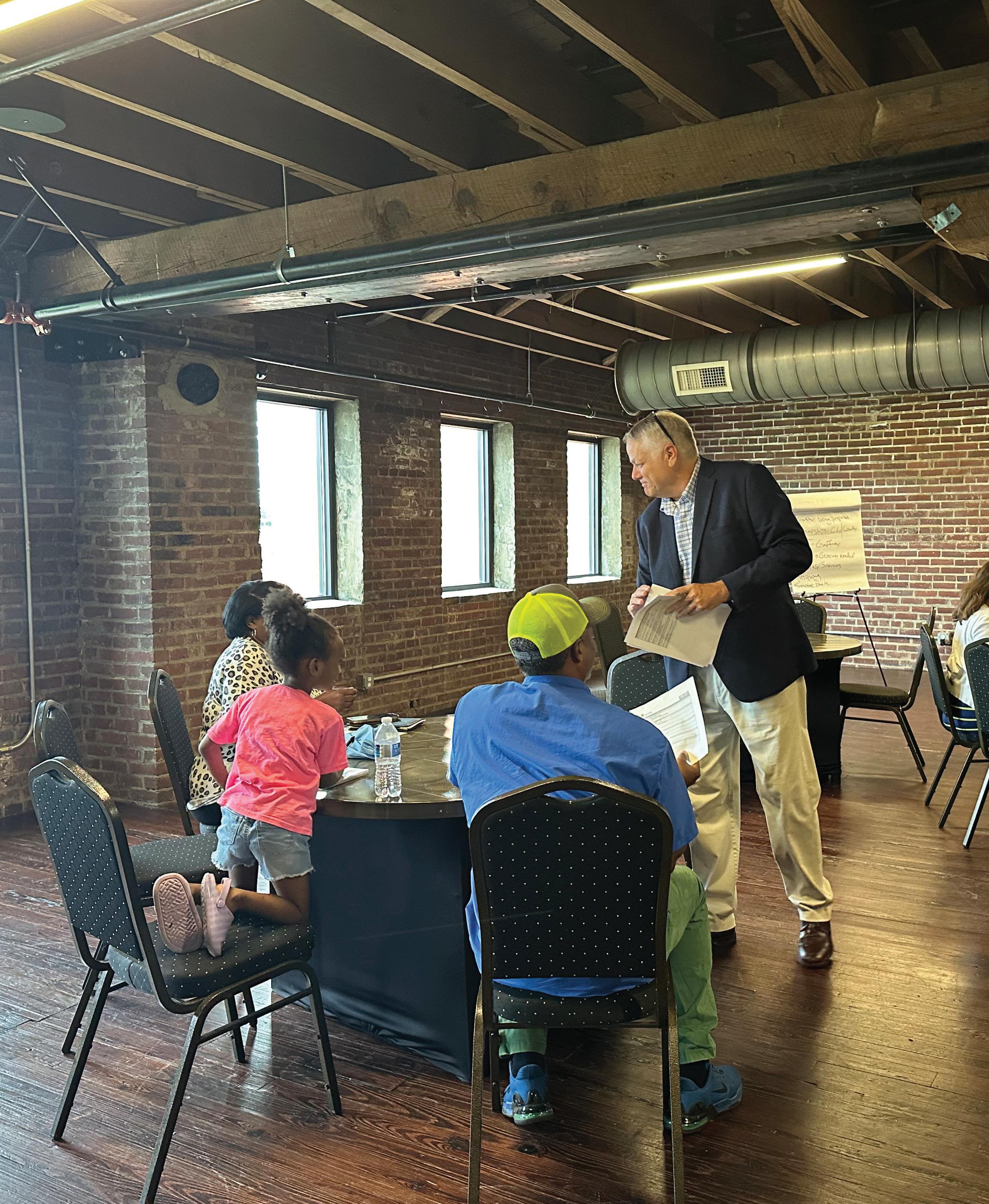
This chapter outlines the public engagement techniques used throughout the planning process. An online survey was developed to collect community input on local tourism assets. It also identifies the key stakeholders involved in the development of the plan and presents the results from a public meeting, highlighting the community’s feedback and contributions to the planning process. The chapter is organized into the following sections.
3.1 TOOLS OF ENGAGEMENT
3.2 COMMUNITY SURVEY
3.3 COMMUNITY PARTNERS & PUBLIC FORUM
The Regional Tourism Plan project was officially launched and introduced to the public using a range of outreach techniques. A project fact sheet was developed for stakeholders and community members, offering key information about the plan (see Appendix A.1). The fact sheet outlined: 1) the plan’s purpose and vision, 2) its goals, and 3) an overview of the planning process, ensuring that the community could be well-informed and engaged from the outset.
A dedicated project webpage for the Regional Tourism Plan was created at uniontourismplan.com. The site featured a link to an online community survey, allowing the public to share their input, as well as detailed information about the desired outcomes of the planning process and the overall goals of the project. This online platform served as a key tool to allow community engagement and keep stakeholders informed throughout the planning process.
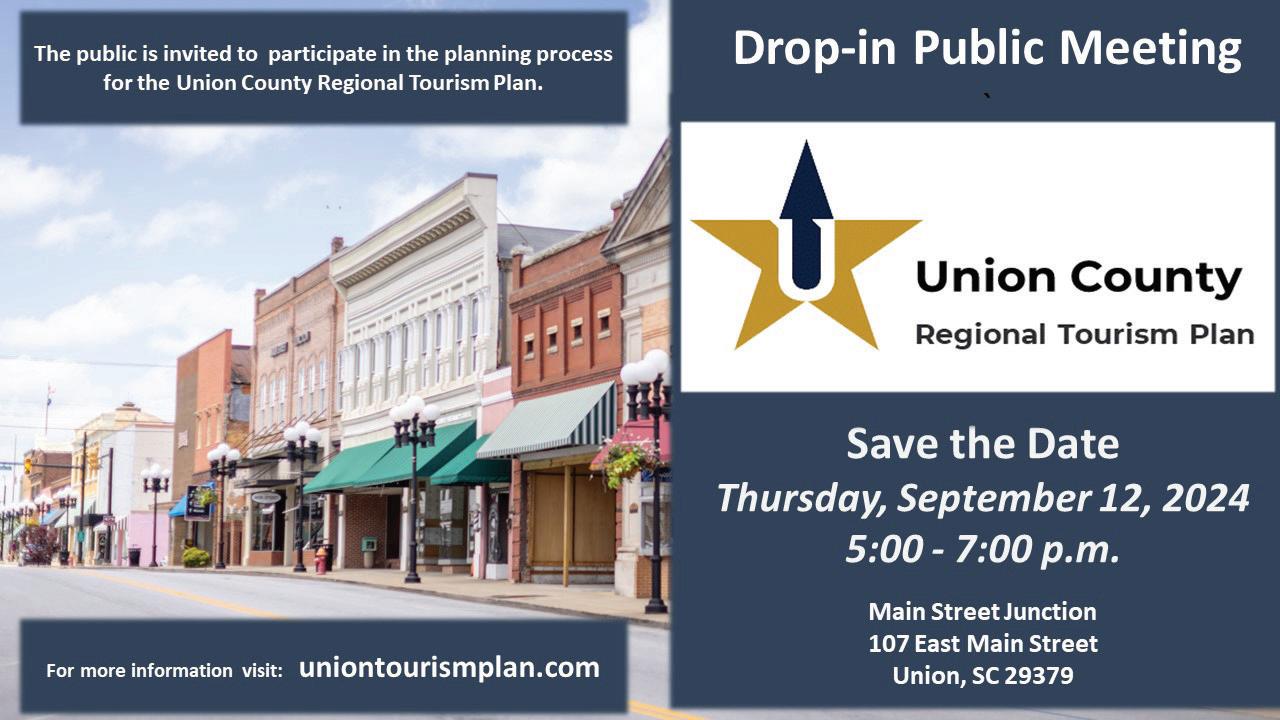

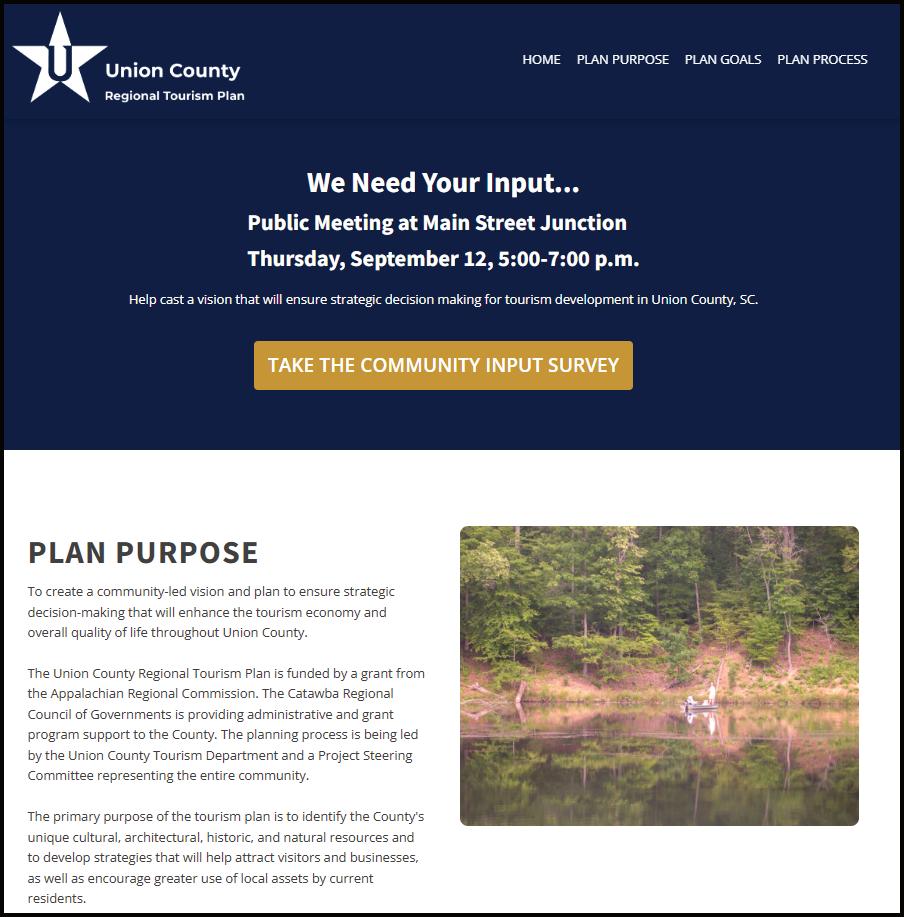
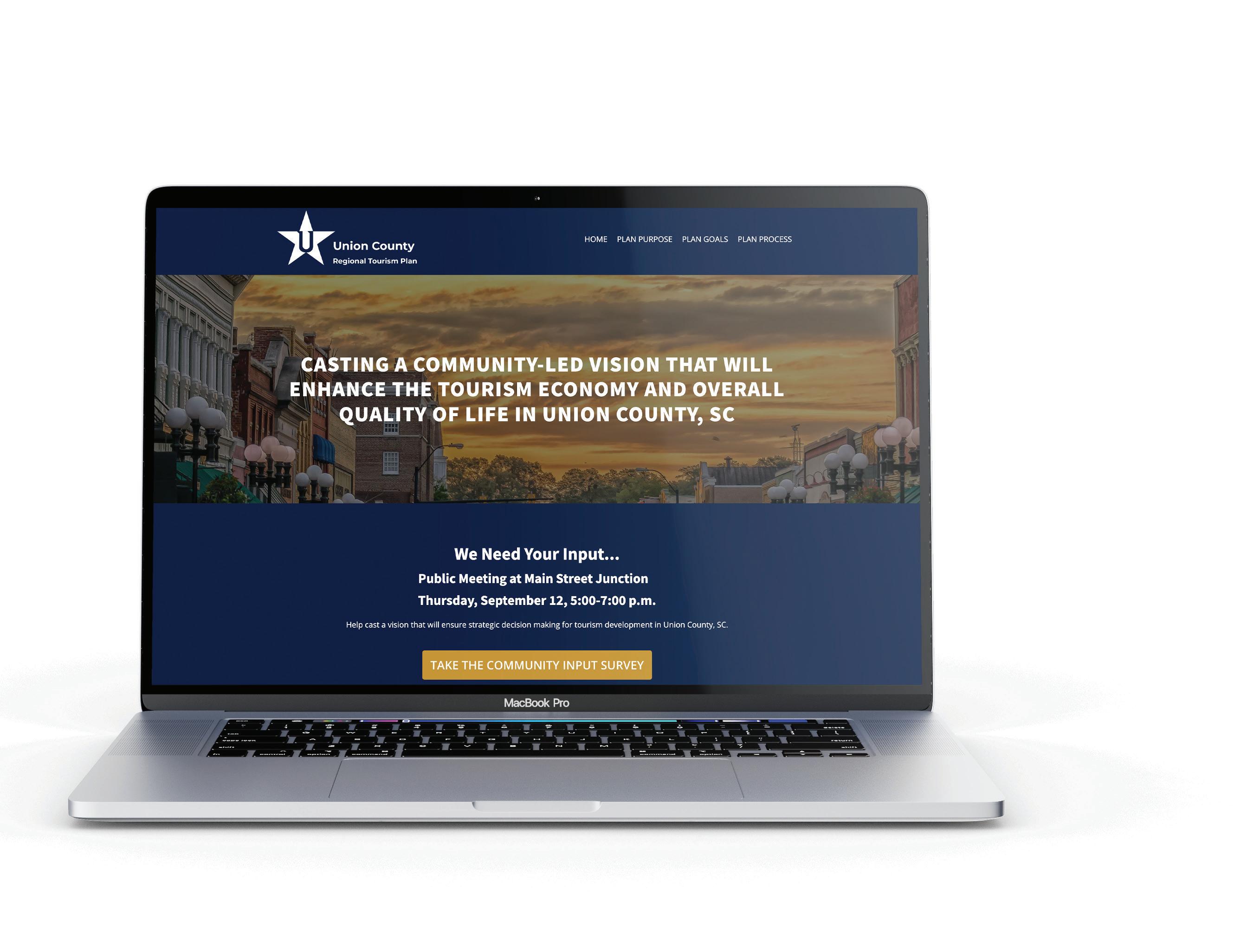

The Regional Tourism Plan Community Survey was conducted to gather input from residents on the tourism assets they value most and to identify priorities for future projects. The survey received 65 responses between April and June 2024. It was distributed by town and county officials, as well as local stakeholder groups, through a variety of channels, including newspapers, websites, email, and social media platforms. This section summarizes the key findings from the survey. Complete survey results are available in Appendix A.2.
Tourism Category Ranked by Importance
The Project Oversight Committee played an essential role in shaping a plan to drive economic development and foster the growth of the tourism industry in the region. Composed of representatives from the local business community, the Union County Tourism Department, Union County Parks and Recreation, the City of Union, the Towns of Lockhart, Carlisle, and Jonesville, the Committee has worked collaboratively to ensure the plan’s success. Their efforts have focused on identifying actionable recommendations that align with the region’s economic development objectives. United by a shared vision, the Committee supports leveraging Union County’s existing tourism assets to fuel economic growth and position the county as a premier travel destination.
To gather valuable insights, the consultant team engaged stakeholders through a series of interviews, which highlighted community needs, aspirations, and key opportunities and constraints. Working alongside the Oversight Committee, these stakeholders played a vital role in establishing a unified vision and formulating recommendations for the county’s tourism development strategy. While not exhaustive, the following list highlights the diverse range of additional ‘Potential Partners & Stakeholders’ who could contribute to the successful implementation of tourism-related projects.
• Appalachian Regional Commission
• Catawba Regional Council of Governments
• Discover South Carolina
• Main Street South Carolina
• Municipal Association of South Carolina
• Palmetto Conservation
• SC Association of Tourism Regions
• SC Department of Commerce
• SC Department of Archives and History
• SC Department of Natural Resources
• SC Nature-Based Tourism Association
• SC Department of Parks, Recreation and Tourism
• SC State Parks
• South Carolina Trails
• Spartanburg Community College
• Union Chamber of Commerce
• Union Community Foundation
• Union County Arts Council
• Union County Motorsports Association
• Union County Parks and Recreation
• Union County Schools
• Union County Health Department
• Union County Development Board
• Upstate Alliance
• Upstate Forever
• US Forest ServiceEnoree Ranger District
• USC Union
The consultant team conducted interviews, meetings, and public input sessions to gather feedback and formulate recommendations for the Regional Tourism Plan. Engaging with community stakeholders and the public, the team identified opportunities, underutilized assets, and key challenges facing tourism development in Union County. This valuable input played a crucial role in shaping the plan’s recommendations and priorities. To inform the community about the
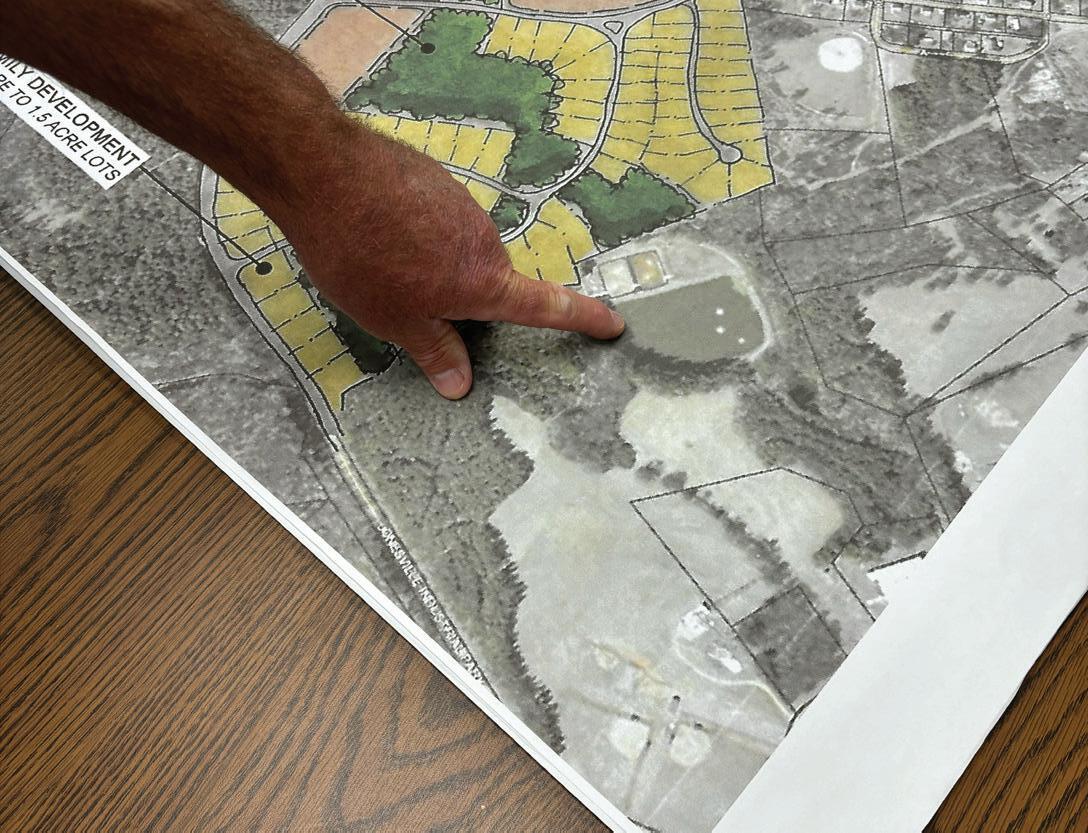
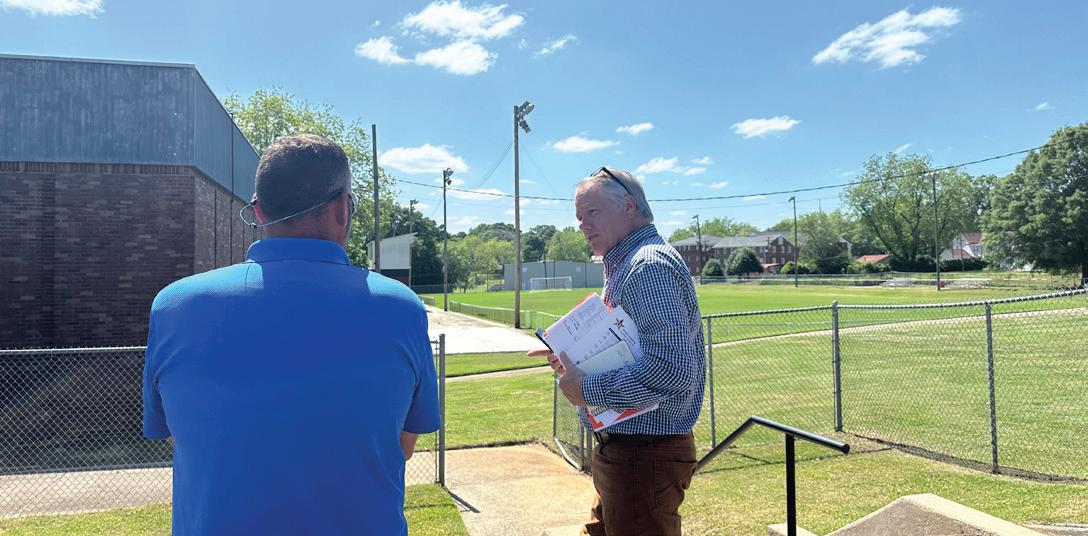
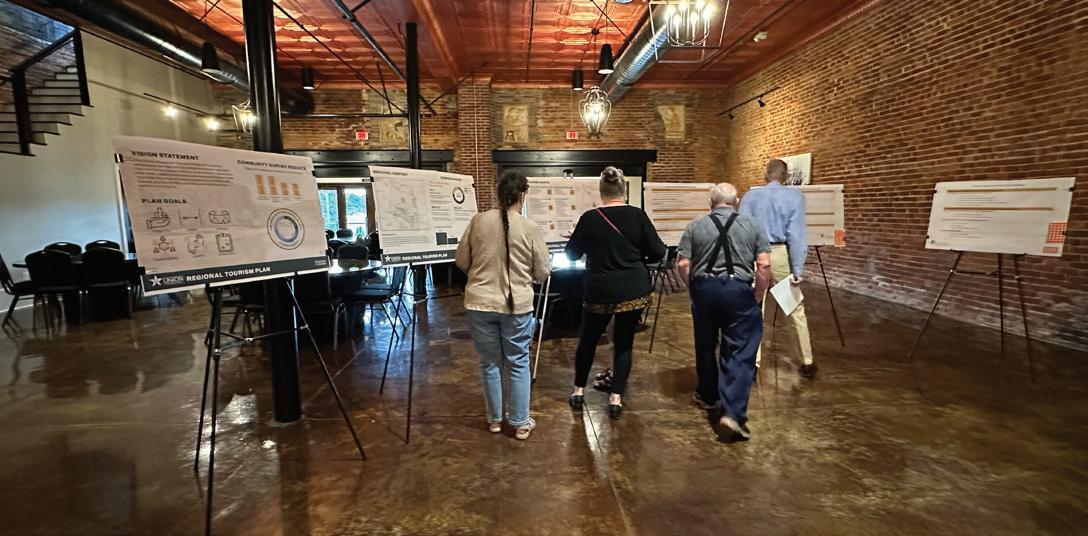
plan and proposed recommendations, and to encourage meaningful public involvement, the Project Oversight Committee organized a dropin community meeting. To encourage broad participation, the meeting was promoted through the local newspaper and social media platforms. Key engagement tools used to collect feedback included visioning exercises, voting, and activities focused on project prioritization (See Appendices A.1-A.6 ).

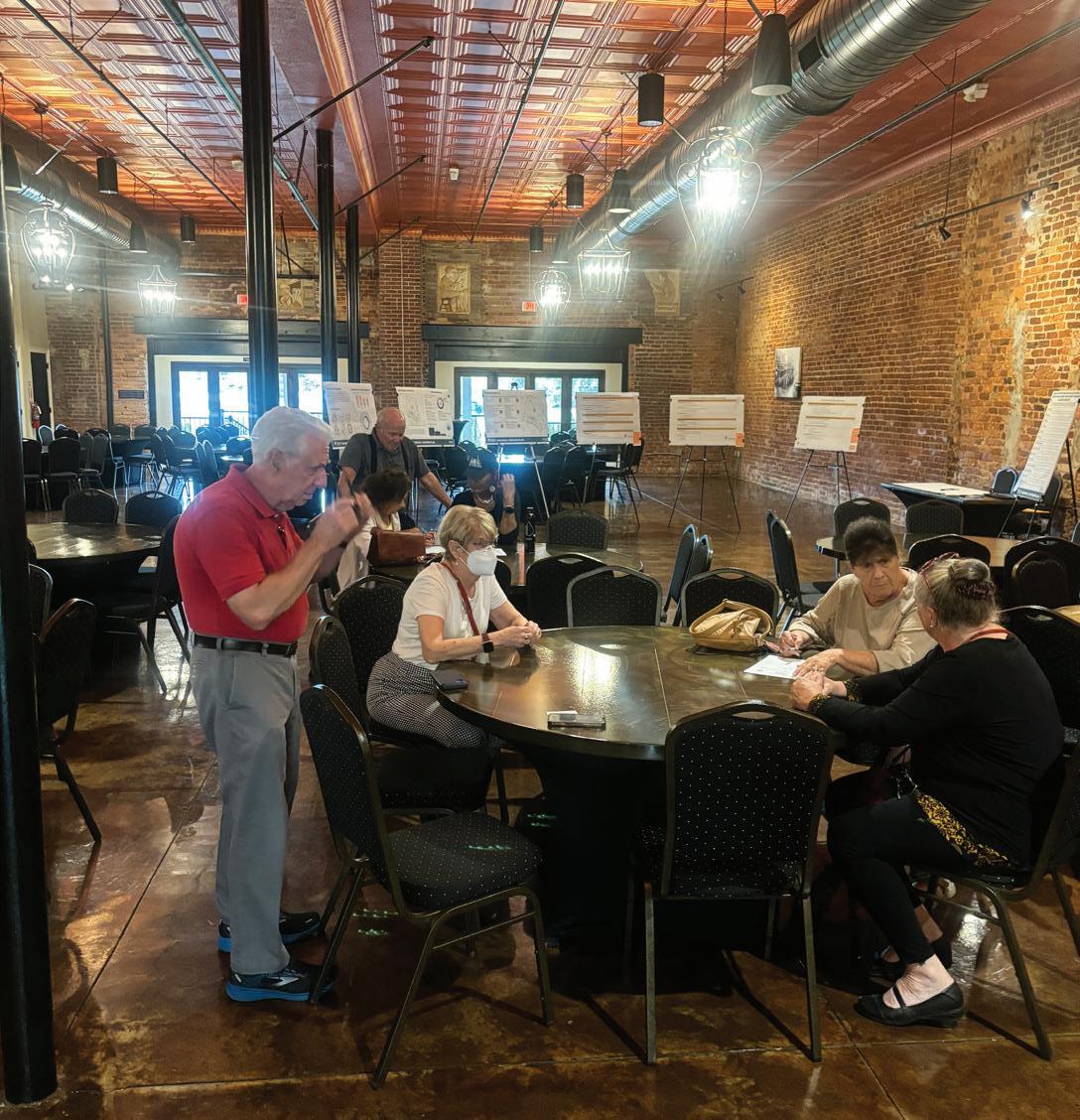
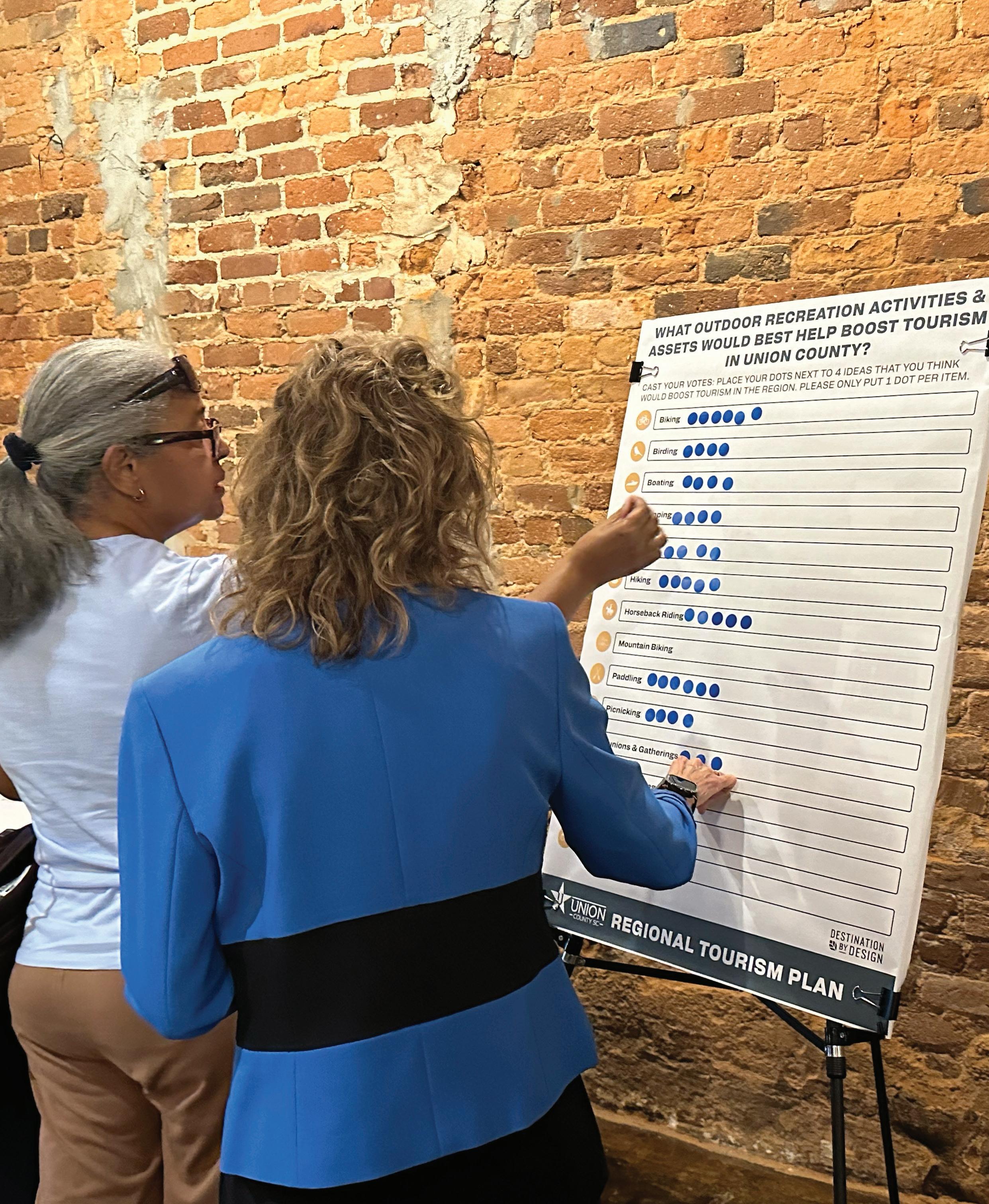
These recommendations provide the strategic framework of the Regional Tourism Plan. They are organized according to the two major Tourism Areas identified during the planning process: 1) the Countywide Tourism Area and 2) the Main Street Communities Tourism Area. These two Tourism Areas are divided into nine Focus Areas with a total of 17 individual tourism-related projects and 40 specific implementation strategies.
All recommended projects focus on improving and upgrading the existing assets within each Focus Area, with efforts tailored to the specific type of asset. All recommendations are designed to enhance the inventory of tourism assets, increase the area’s appeal as a destination, and boost the regional tourism economy.
4.1 COUNTYWIDE TOURISM AREA
4.2 MAIN STREET COMMUNITIES TOURISM AREA
The Countywide Tourism Area is divided into five Focus Areas characterized by the following tourism asset types: A) Historic and Cultural Resources, B) Outdoor Recreation and Nature-Based Tourism, C) Managed Areas, D) Agritourism, and E) Sports Tourism.
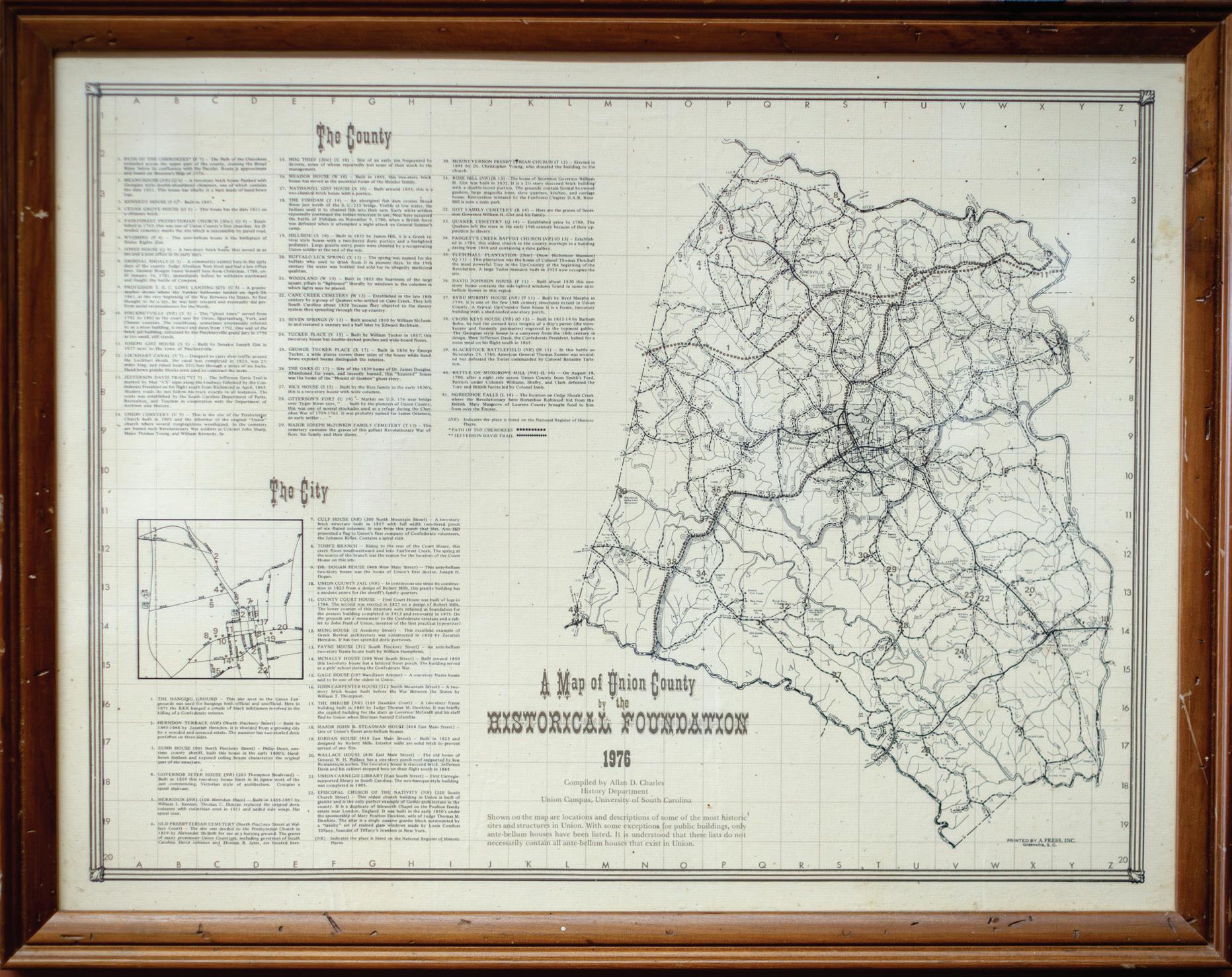
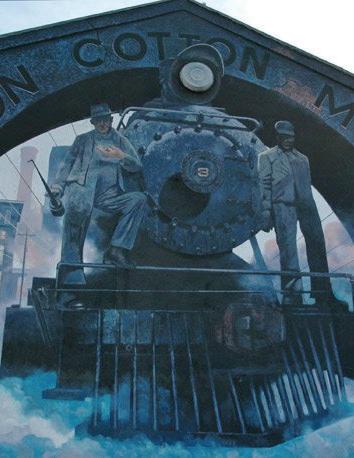
Union County is rich in culture and history, as evidenced by the region’s vibrant local culture that is reflected in its cuisine, music, arts, crafts, and enduring local traditions. Key recommendations for promoting these historic and cultural resources include repurposing the Historic Union Jail as a Visitor Center and amplifying marketing efforts for local venues, concerts, festivals, and events. Additionally, promoting food and beverage experiences, as well as public art, will further showcase the area’s heritage and help attract visitors eager to explore the area’s significant history and cultural offerings.
The Historic and Cultural Resources Focus Area includes a single project with five key recommendations.
KEY RECOMMENDATIONS
A.1.1 Historic Union Jail - Repurpose as Visitor Center.
A.1.2 Venues and Concert Marketing and Promotions
A.1.3 Festivals and Events Marketing and Promotions
A.1.4 Food and Beverages (e.g. BBQ Festival + Microbrewery/Distillery)
A.1.5 Public Art (Sculpture + Murals)
Main Street Junction is a versatile venue, ideal for events such as weddings, reunions, corporate meetings, and shows. It features a catering kitchen, banquet hall, covered veranda, and access to a fenced ornamental park. The second floor is elevator accessible and offers a kitchenette, conference room, bridal suite, and flex room. This type of destination is crucial for attracting more visitors and boosting activity in the area’s Central Business District.
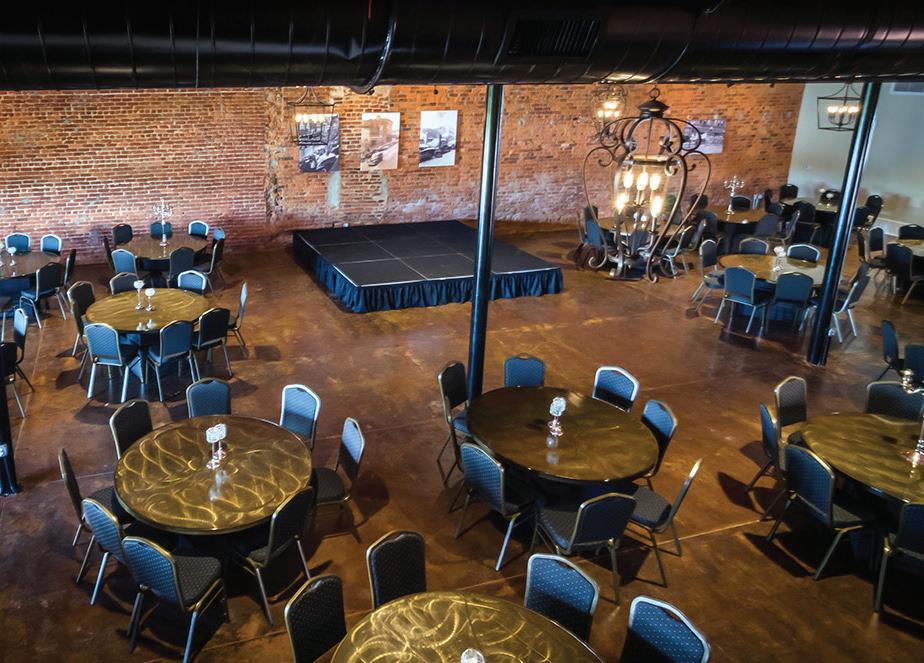
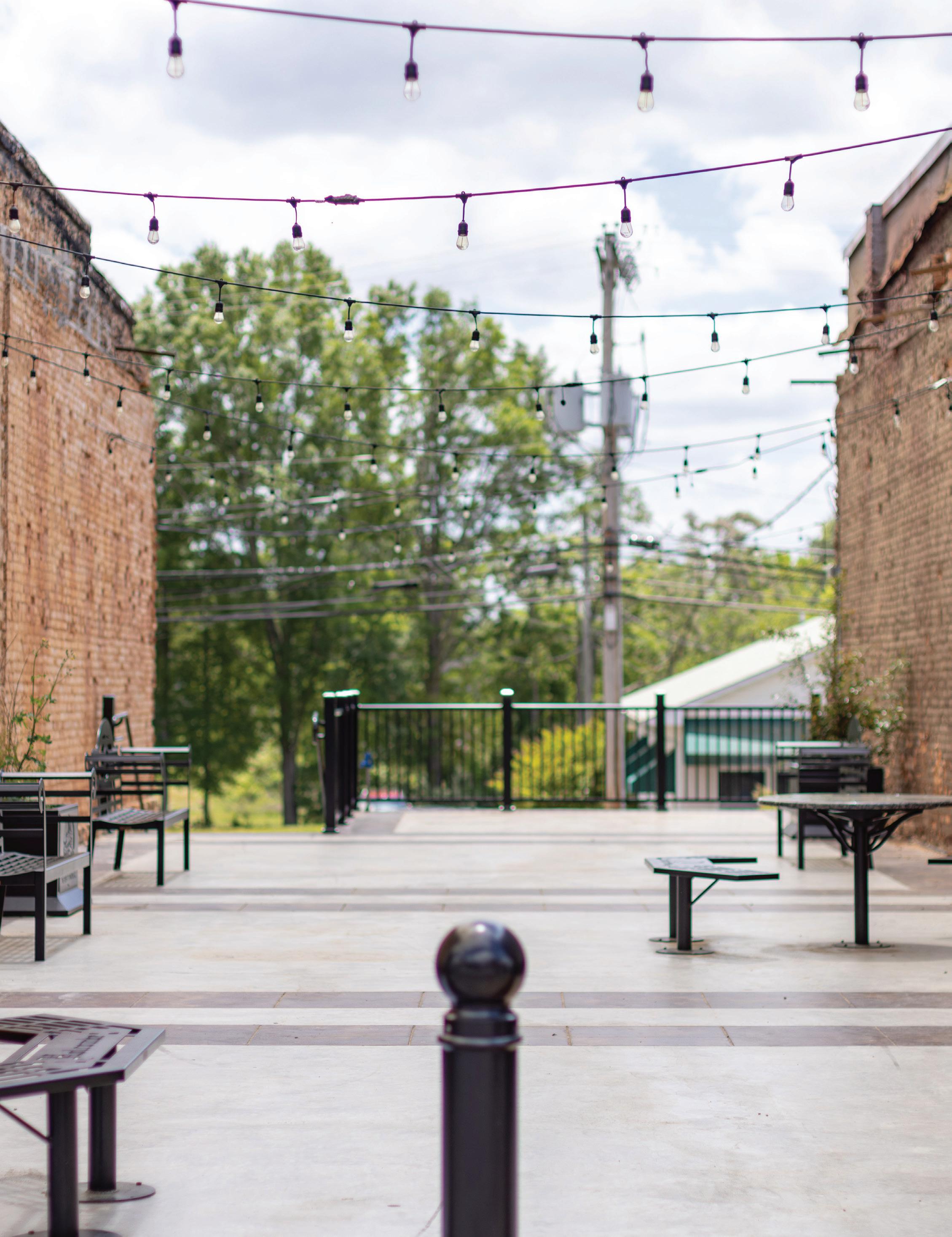
Natural resources play a crucial role in tourism development, environmental sustainability, and community well-being. Union County’s diverse landscape, with its rolling hills, vast forests, and extensive waterways, offers significant assets for nature-based tourism. Key recommendations focus on enhancing these resources, including the development of more paddle trails, river access points, and natural surface trails that cater to outdoor enthusiasts. Expanding campground facilities will also provide additional opportunities for visitors to experience the area’s natural beauty and produce longer stays. By investing in these initiatives, the area can attract more tourists, promote outdoor recreation, and foster vital natural resources for future generations.
The Outdoor Recreation and Nature-Based Tourism Focus Area includes three projects with seven recommendations.
KEY RECOMMENDATIONS
B.1.1 Agency Partnerships and Planning
B.1.2 River Accesses and Infrastructure Improvements
Paddle trails, or blueways, are designated water routes for kayaking, canoeing, and other water activities. They broaden an area’s appeal and attract outdoor enthusiasts who enjoy paddling, fishing, and wildlife observation. Blueways can help boost the local economy by drawing tourists who spend on rentals, guided tours, equipment, accommodations, dining, and other services. They not only contribute to the region’s tourism appeal, but blueways also support the health and wellness of local residents by offering more opportunities for physical, outdoor activities. Together, these benefits help strengthen both the tourism sector and the regional economy.
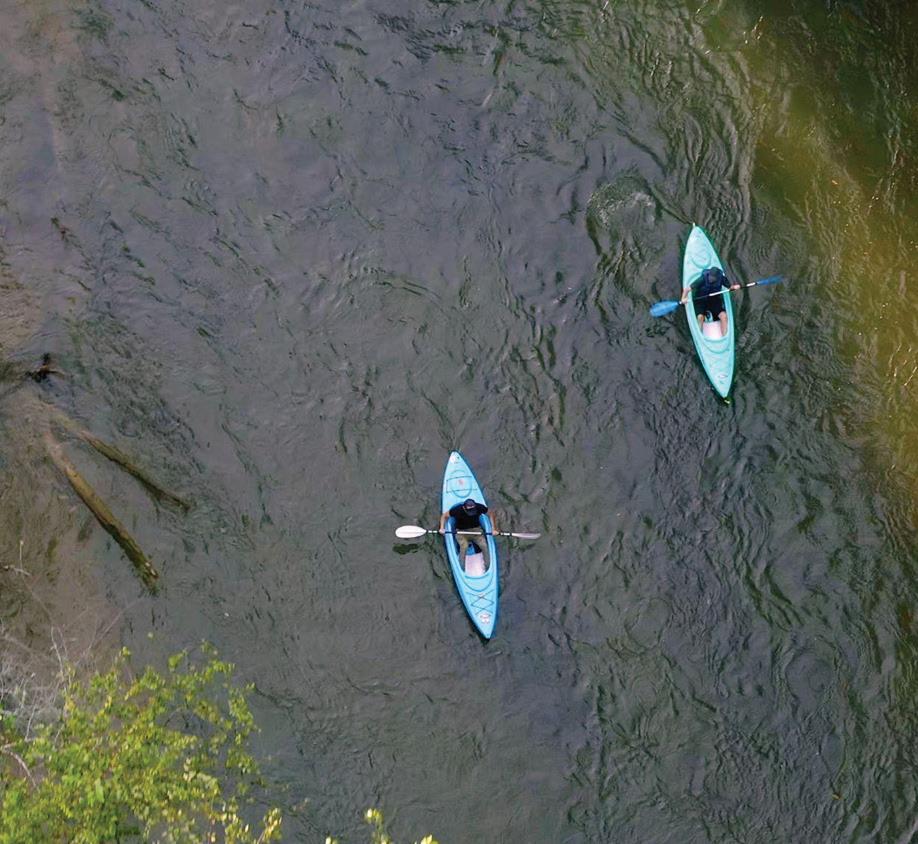
B.2.1
B.2.2
B.2.3
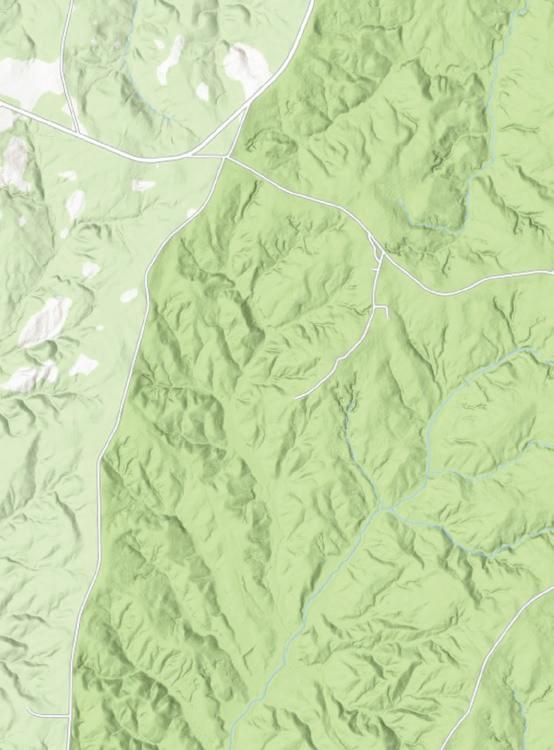
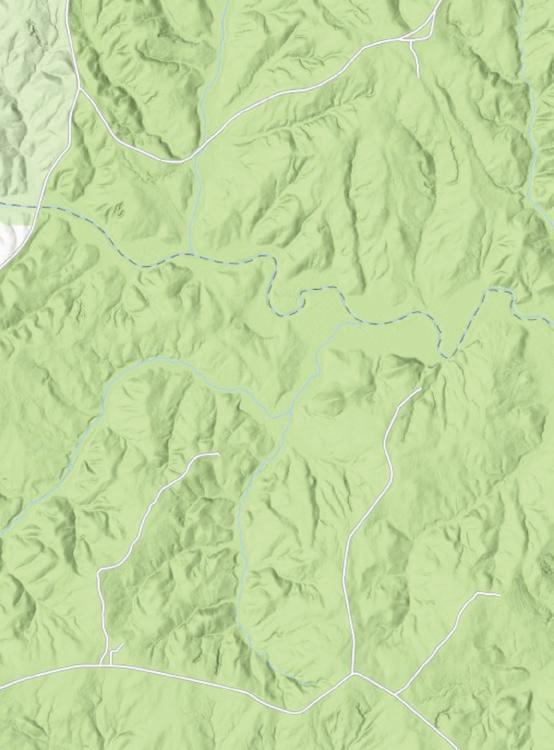

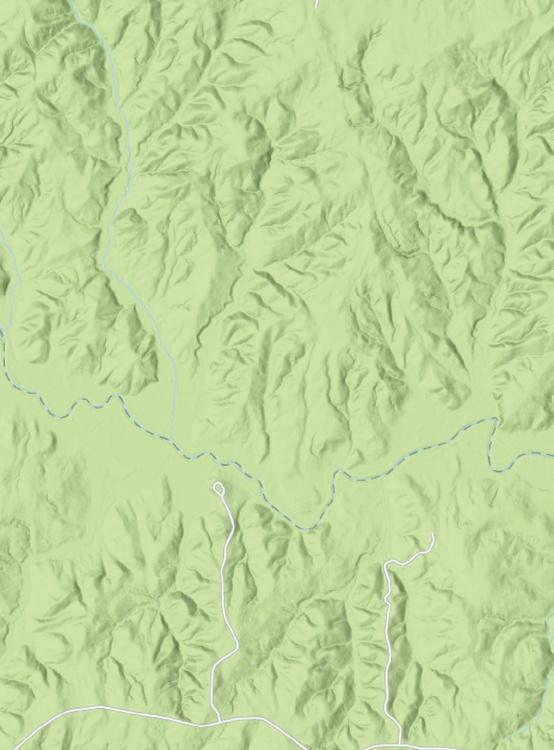
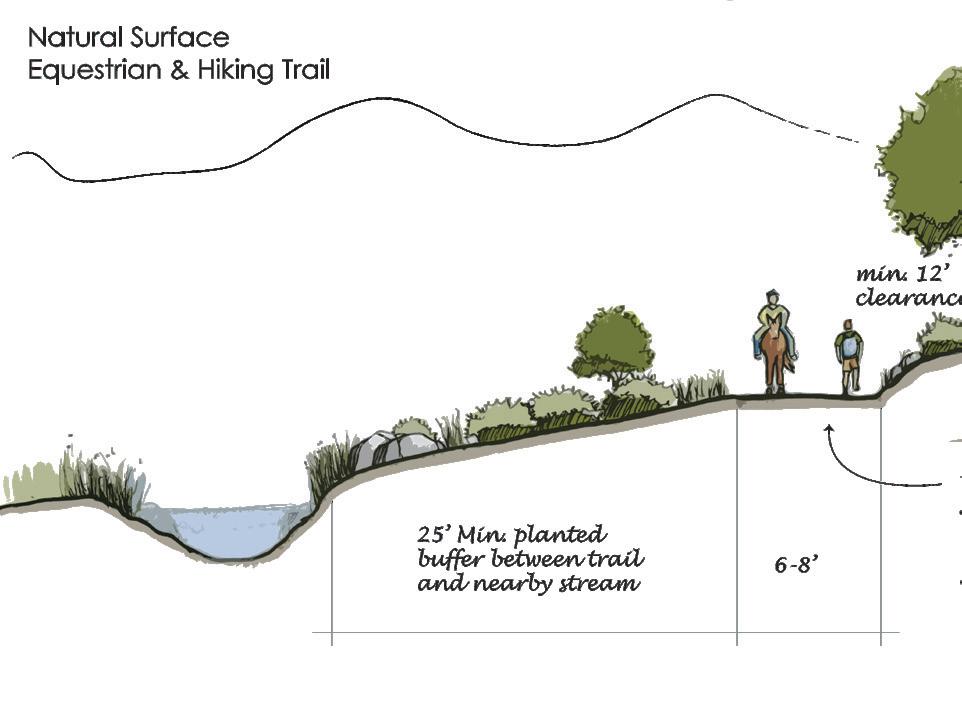
The Palmetto Trail is South Carolina’s longest trail system, stretching approximately 500 miles from the Blue Ridge Mountains to the Atlantic Coast upon completion. Currently, it spans about 360 miles across 14 counties, including Union, where the 36-mile Enoree Passage is easily accessible via trailheads in the Sumter National Forest. The entire Trail is open for hiking and backpacking, with designated areas allowing mountain biking, horseback riding, and camping.

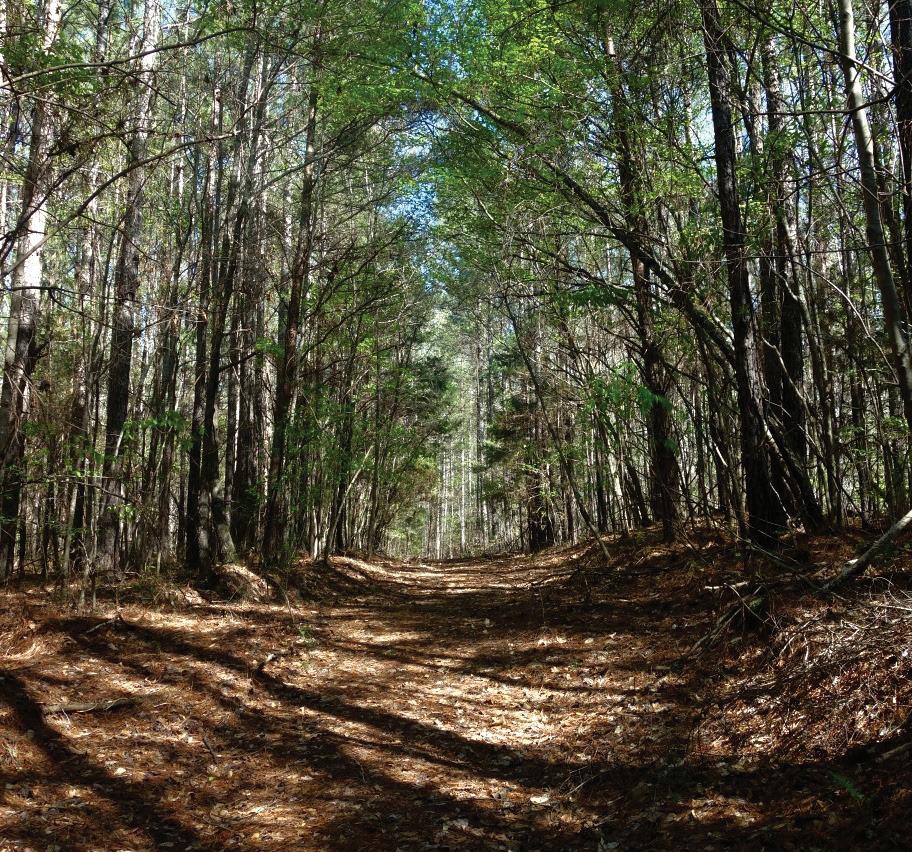
Key recommendations for regional tourism development focus on campground expansion and fostering partnerships with state and federal agencies to ensure adequate amenities and sufficient access to outdoor recreation opportunities on public lands. By developing additional campgrounds and improving access to hunting and fishing areas, the region can become a mecca for outdoor adventurers. Collaborating with state and federal agencies will help ensure that these resources are well-maintained and available and will help promote responsible use.
B.3.1 Agency Partnerships
B.3.2 RV Parks / Campground Development
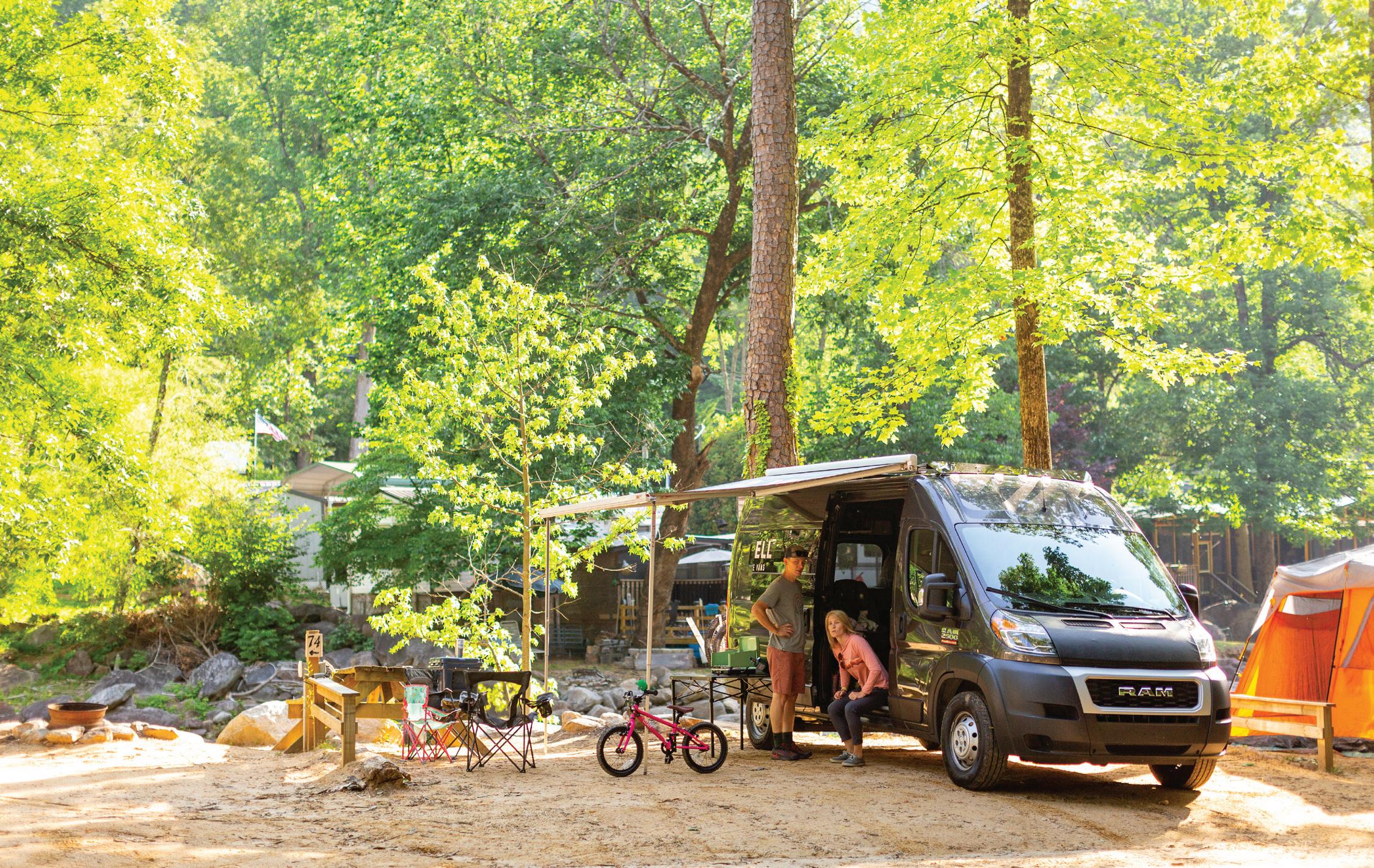
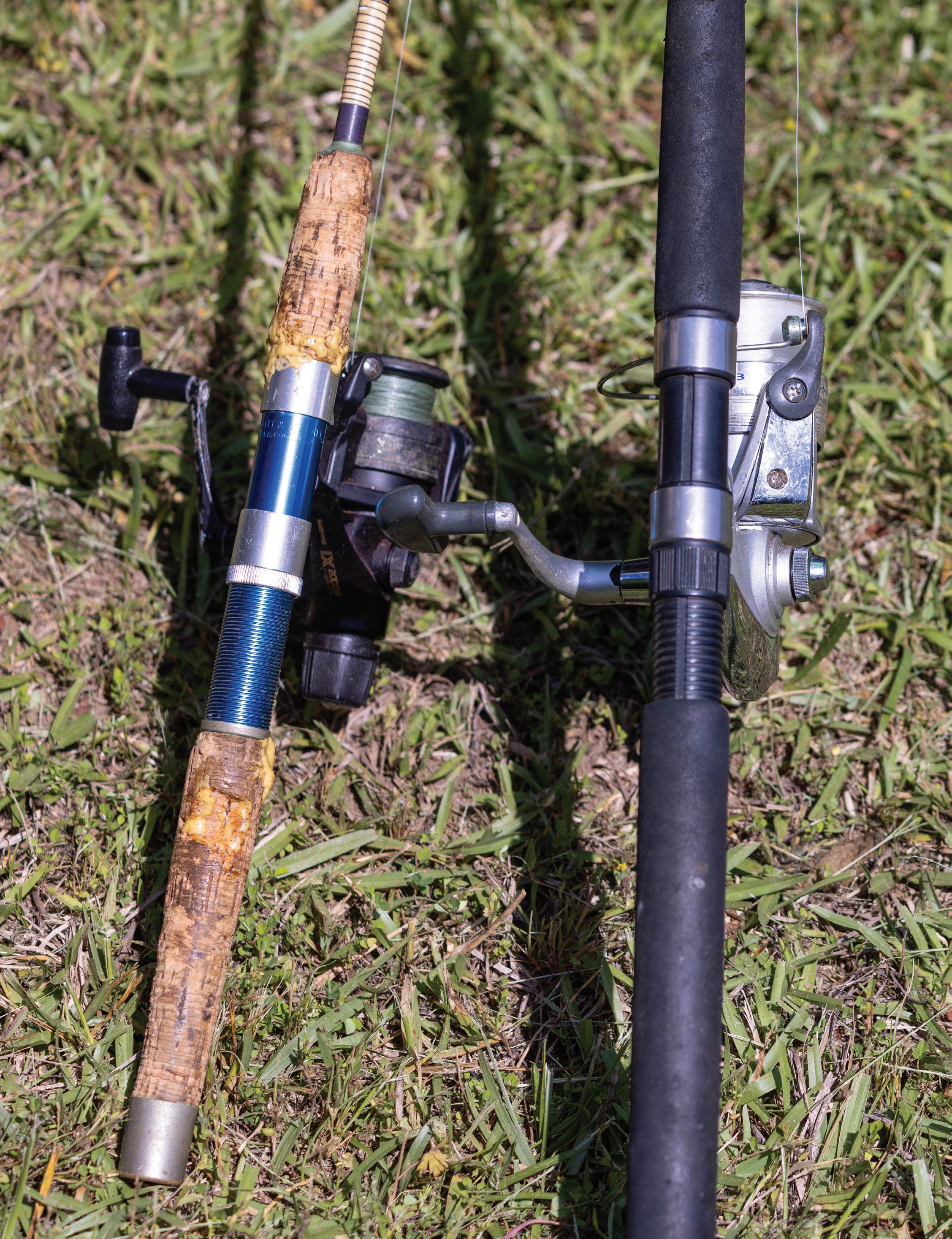
Union County has an abundance of managed areas and public lands that provide superb opportunities for outdoor recreation, from hunting and fishing to paddling and hiking. Key recommendations focus on building partnerships between local, state, and federal entities to enhance these assets. Improvements at Foster Park, Jonesville Reservoir, John D. Long Lake, Rose Hill State Park, and Sumter National Forest will further elevate the county’s appeal as a destination for nature lovers and adventure seekers. By working to promote and enhance the tourism assets in these areas, the region can attract more visitors and capitalize on the popularity of the many outdoor recreation activities available in the region.
The Managed Areas Focus Area includes three projects, each with two recommendations.
Enhancing Foster Park and the Jonesville Reservoir presents valuable opportunities for the local government to create an environment that supports tourism development. By investing in improvements such as upgraded trails, additional recreational facilities, better signage, and enhanced natural areas, both locations can become key attractions for visitors seeking nature-based experiences. For Foster Park,
the addition of amenities like picnic areas, playgrounds, and event spaces can increase its appeal as a family-friendly destination. Together, these local projects can create a stronger foundation for tourism growth and a more vibrant local economy.
C.1.1 Foster Park Enhancements
C.1.2 Jonesville Reservoir Enhancements
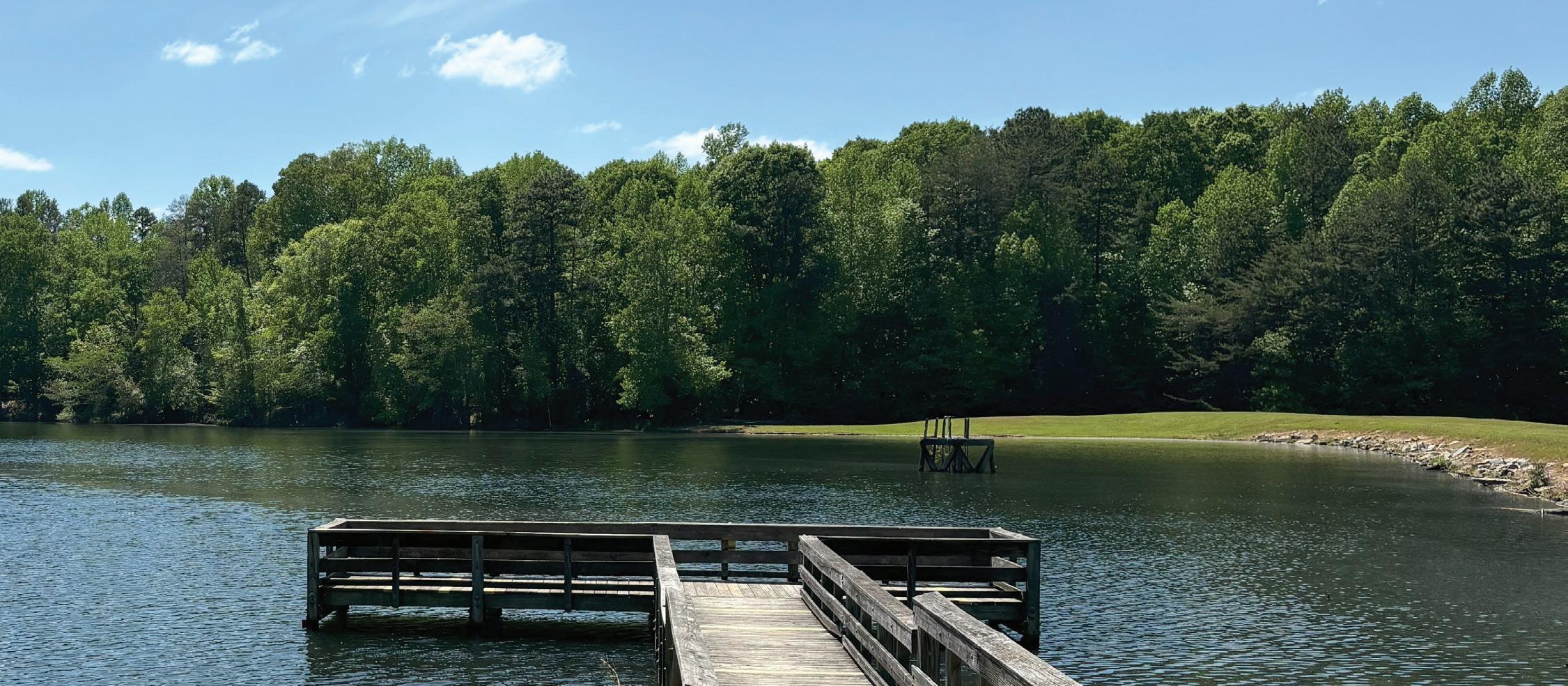
Enhancing John D. Long Lake and Rose Hill State Historic Site offers a strategic opportunity for assistance from the State of South Carolina to help support local economic growth and promote tourism development. Upgrading amenities at John D. Long Lake, such as improved boat ramps, camping facilities, and hiking trails, can offer a diverse range of activities like fishing, boating, and wildlife observation. These enhancements would elevate the lake as a prime destination for tourists seeking outdoor recreation, benefiting nearby businesses and driving regional economic growth.
At Rose Hill State Historic Site, improvements like expanded visitor facilities, interpretive signage, and preservation of historical
structures will enhance the educational and cultural value of the site. By attracting history and culture-focused tourists, these upgrades can bolster the site’s role in preserving the region’s heritage while stimulating the local economy through increased visitation. Together, these projects would not only strengthen the area’s tourism infrastructure but also align with state and local efforts to create a more robust tourism economy that fosters long-term economic growth in the region.
C.2.1 John D. Long Lake – Site Development & Enhancements
C.2.2 Rose Hill Plantation Enhancements
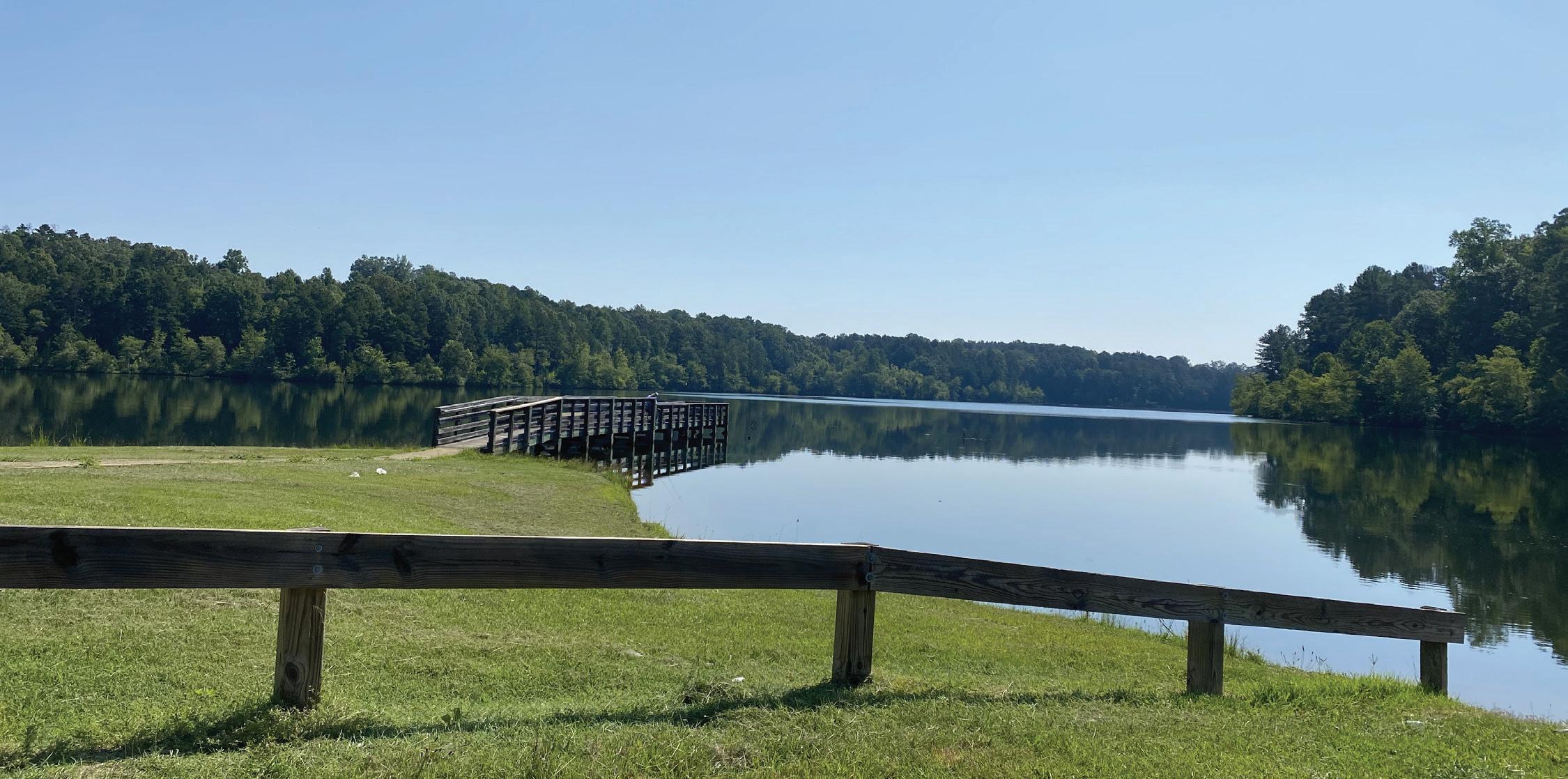
Enhancements at the Sumter National Forest Enoree District present a valuable strategy for securing federal assistance to support economic growth and to promote tourism development in the region. Upgrading the area’s existing infrastructure—such as improving hiking, biking, and equestrian trails, adding interpretive signage, and enhancing visitor amenities—can attract more outdoor enthusiasts and eco-tourists, thereby boosting visitation to the region. These improvements would help elevate the Enoree District as a key destination for nature-based tourism, with more opportunities for popular activities such as wildlife viewing, camping, and outdoor recreation. This in turn would generate more economic activity for local businesses, including lodging, dining, and other retailers.
By partnering with federal agencies to support these enhancements, local governments can leverage resources to create new tourism experiences that capitalize on the region’s natural beauty and ecological diversity. This strategy not only supports local economic development but also helps preserve the area’s natural assets. Strengthening the tourism infrastructure at Sumter National Forest aligns with broader initiatives to enhance the county’s appeal as a year-round destination and fosters a more diverse tourism economy.
C.3.1 Sumter National Forest - Increase Users
C.3.2 Agency Partnerships


Agriculture is a key industry in Union County, which can position the area as a leader in agritourism. The county’s rich agricultural assets attract visitors seeking authentic rural and farmlife experiences. The Union County Farm and Craft Market offers a variety of local produce, plants, and crafts, while showcasing the region’s agricultural heritage. Promoting the development and expansion of the fairground and farmers market facilities will further enhance the county’s appeal in this sector.
The Agritourism Focus Area includes two projects with three recommendations.
To promote tourism development, it is recommended that Union County move forward with plans to develop a MultiPurpose Arena at the Fairgrounds. This arena would host a variety of events, including equestrian competitions, livestock shows, dog shows, trade exhibitions, concerts, and other similar activities. This type of facility could attract regional, state, and national audiences, making it a key driver of economic growth, and expand Union County’s appeal as a tourism destination.
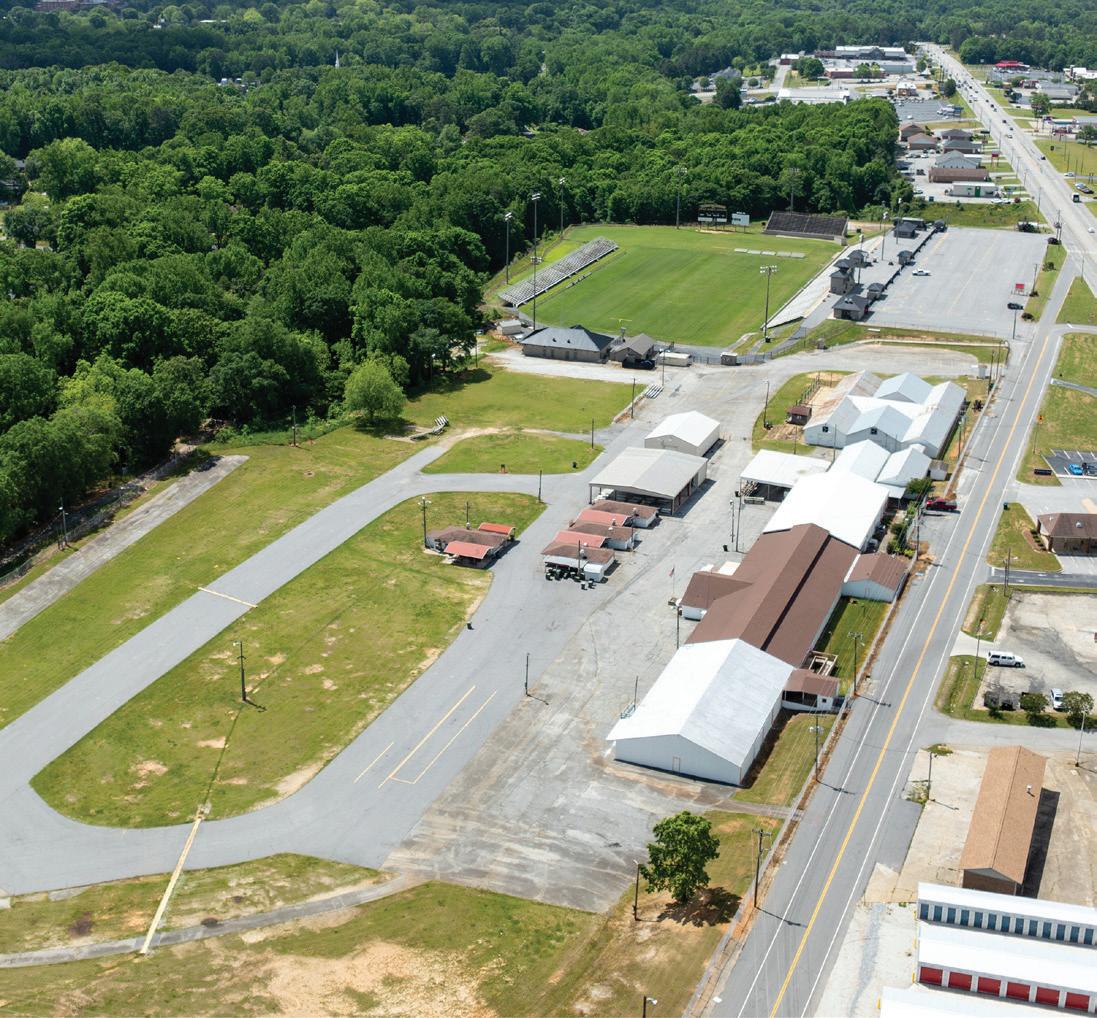
D.1.1 Improvements to Existing Facilities
D.1.2 New Destination-Quality Facilities / Arena
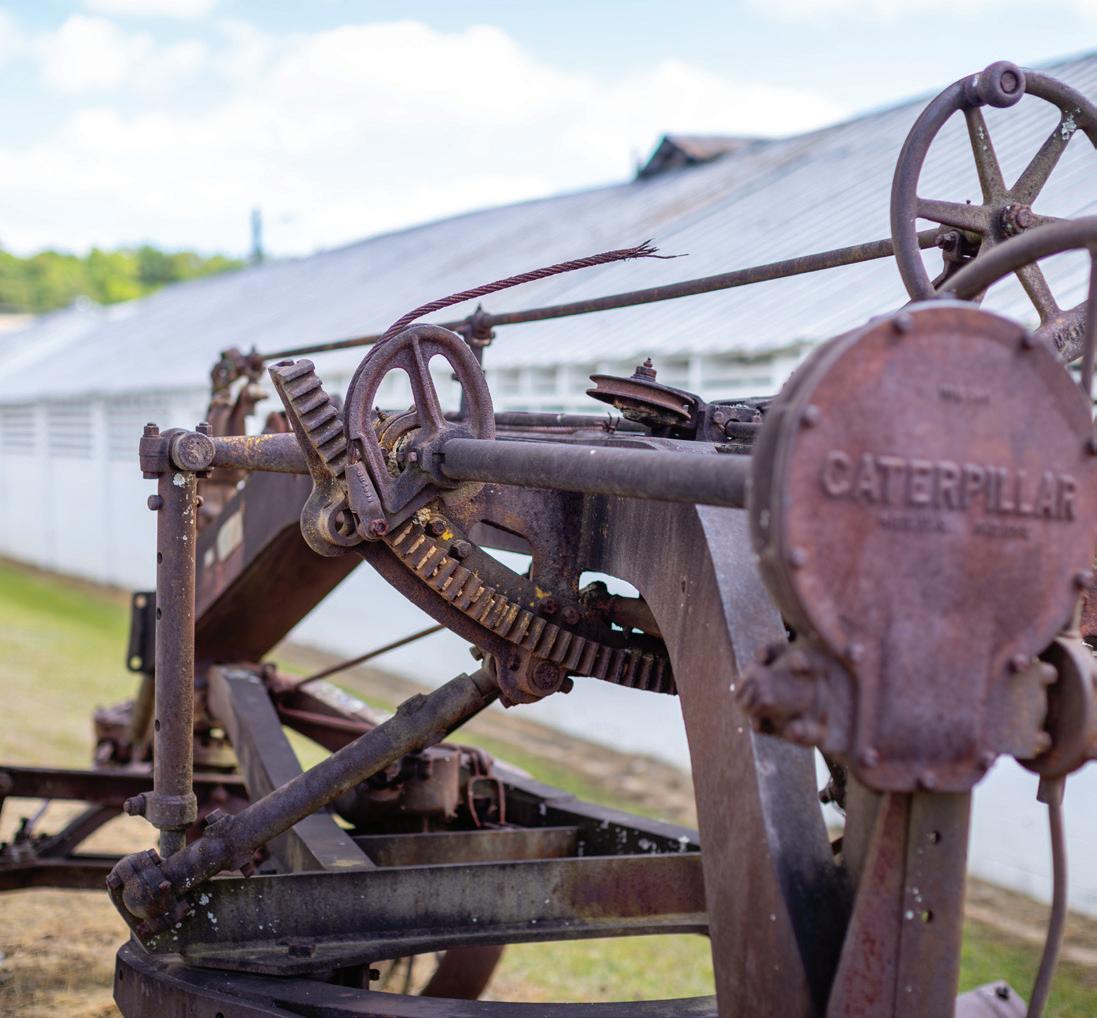
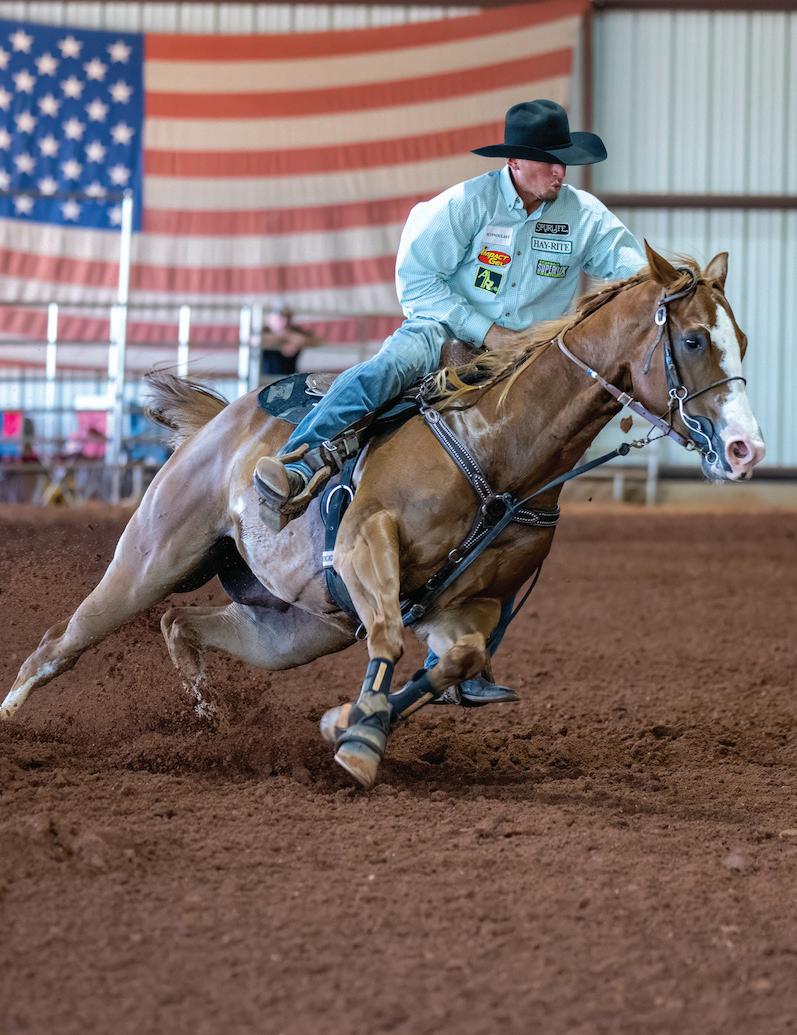
Farmers markets are an important tourism and economic development asset, attracting visitors seeking fresh, local produce and unique artisanal products. The Union County Farm and Craft Market not only supports local farmers and artisans, but it also serves as a vibrant social hub that fosters community engagement and boosts the local economy. To enhance its role as a key tourism attraction, improvements such as expanding vendor spaces, upgrading infrastructure for better accessibility, and adding additional amenities
like seating areas and restrooms would make the market more inviting for both locals and tourists. Promoting events such as cooking demonstrations or live entertainment could further increase visitor engagement. By highlighting local agriculture, food traditions, and culture, these upgrades would elevate the market’s appeal and strengthen Union County’s position as a tourism destination.
D.2.1 Improvements to Existing Facilities
The Fountain Inn Farmers Market is a vibrant community hub featuring over 40 vendors who offer a wide variety of fresh produce, artisanal products, and local goods. Located in a well-maintained pavilion, the market provides a pleasant space for both shopping and socializing. The pavilion is also available for rental, making it an ideal venue for community gatherings and events. Supported by Fountain Inn’s Main Street America program, the market plays a key role in boosting local commerce, promoting small businesses, and fostering a sense of community. Its success contributes to Fountain Inn’s broader tourism and economic development efforts, attracting both locals and visitors to the area.
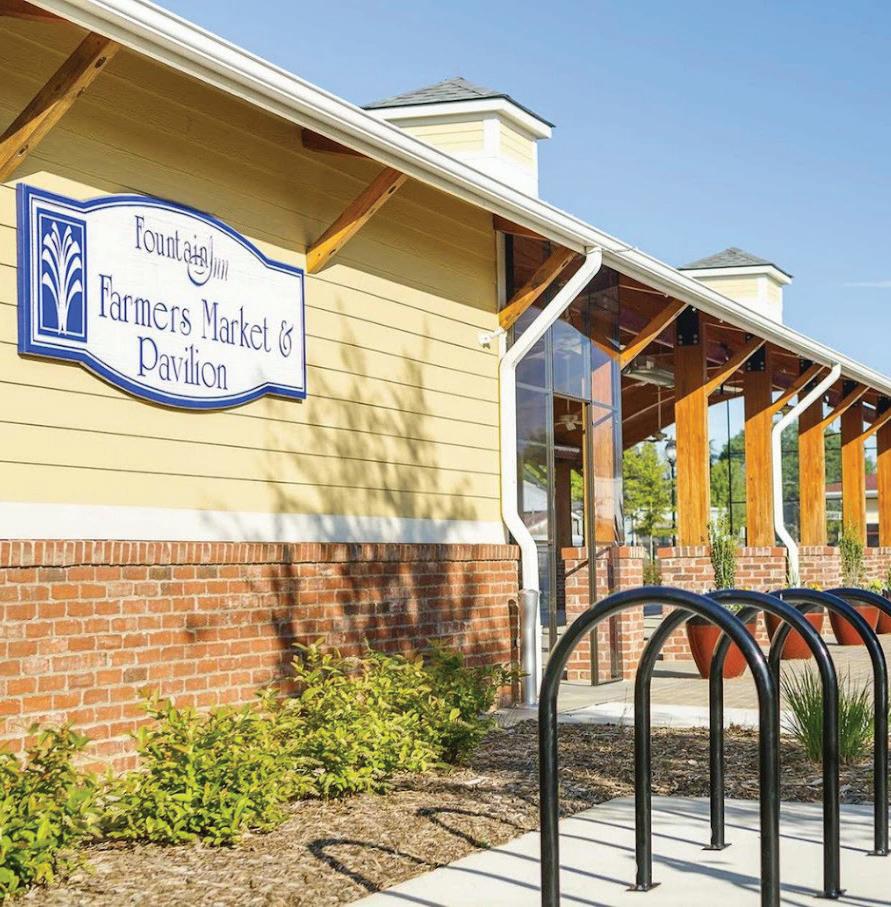
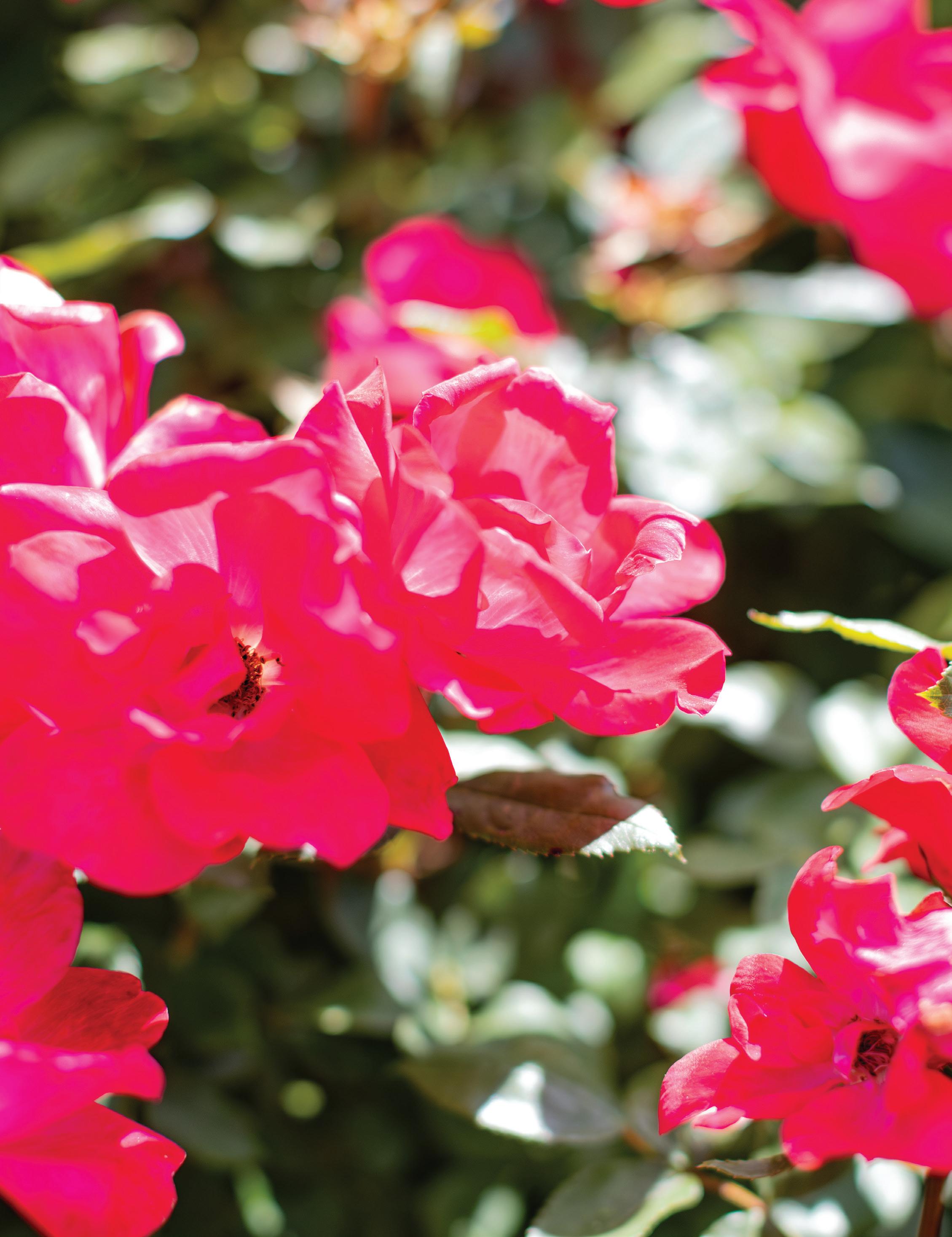
Sports tourism offers significant tourism development benefits by attracting visitors and generating revenue through various sporting events and activities. The Sports Tourism Focus Area includes projects such as promoting the Timken Sports Complex and Union County Stadium, which can help draw large crowds for team sports events. Additionally, hosting road racing and bicycling events further enhances the area’s appeal to athletes and spectators. In the motorsports sector, events like drag racing, motocross, and car shows provide further opportunities to attract visitors and increase the visibility of the region as a destination for sports tourism.
The Sports Tourism Focus Area includes two projects with six recommendations.
Hosting baseball, football, and other team sporting events in small rural communities provides significant benefits. Besides the economic benefits, these events foster community engagement, bringing residents together to support local teams and to volunteer in the community. For young athletes, these events offer excellent opportunities to compete, develop teamwork and leadership skills, and gain exposure to higher levels of competition, which can
potentially lead to academic scholarships or other future opportunities. Overall, sports events can also help increase the community’s visibility, attract more visitors, and support the local economy.
KEY RECOMMENDATIONS
E.1.1 Timken Sports Complex Marketing & Promotion
E.1.2 Union County Stadium Marketing & Promotion
E.1.3 Host Road Racing and Bicycling Events
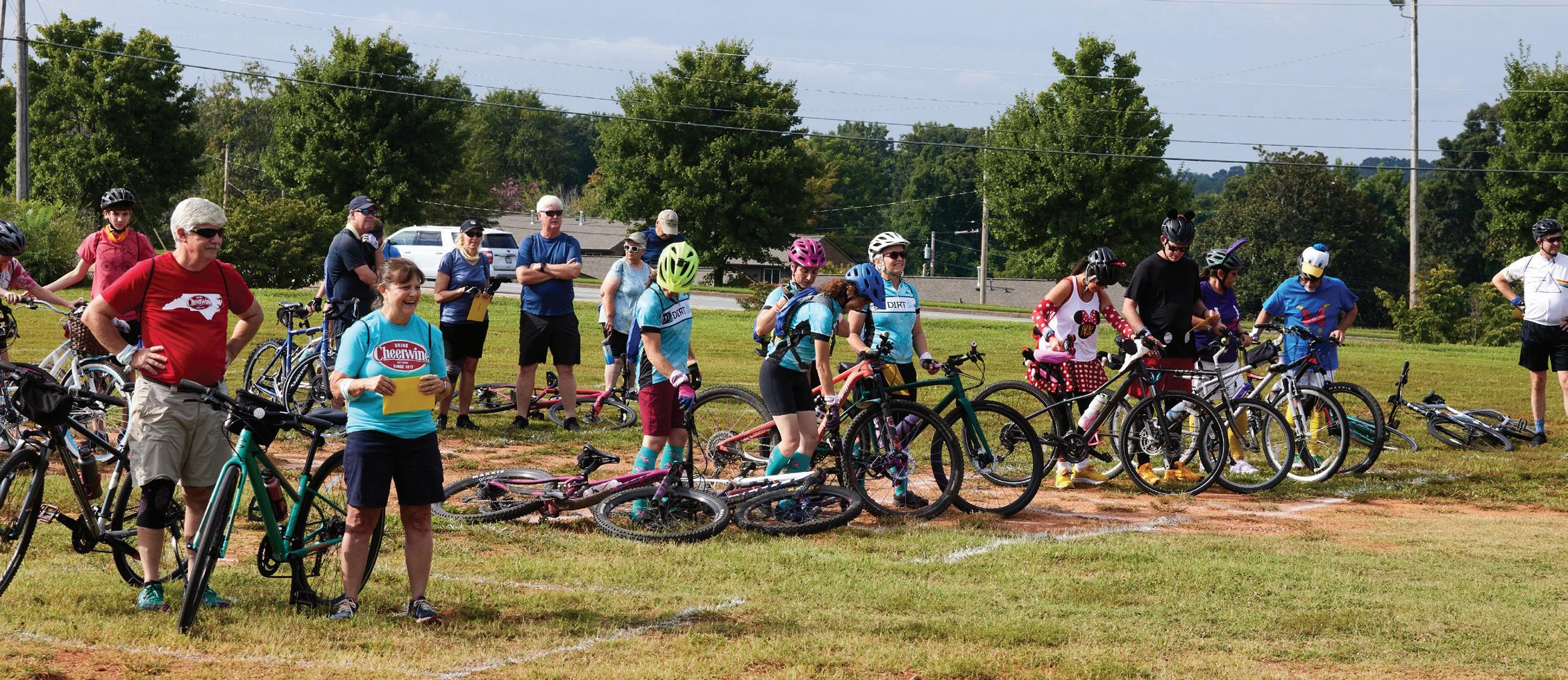
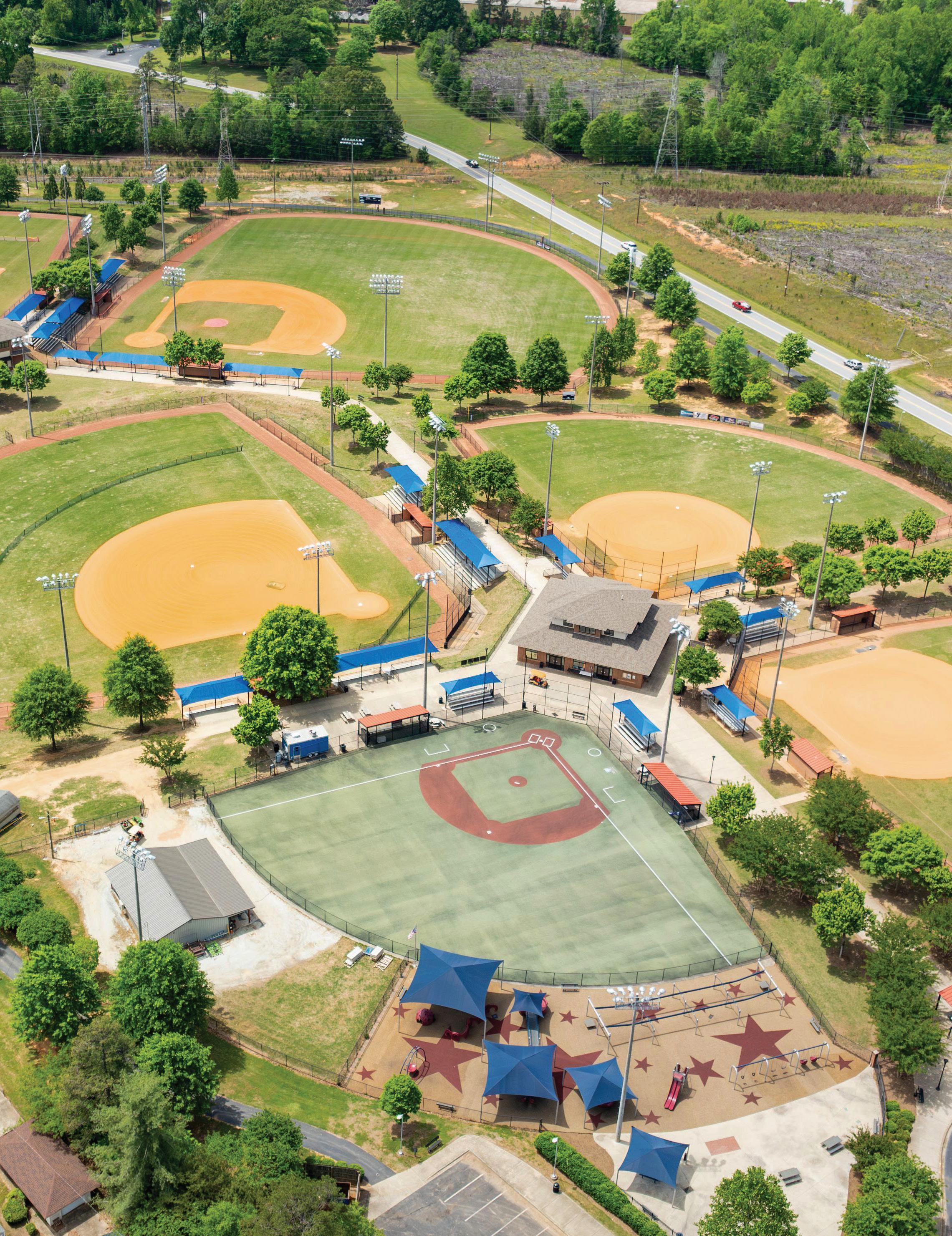
To boost tourism development, Union County should focus on attracting more large-scale events, such as motocross, enduro racing, and sanctioned drag races. Sports tourism—travel for the purpose of attending or participating in sporting events—can significantly benefit the local economy. By promoting Union County as a hub for motorsports, the area will draw more visitors, create jobs, and stimulate growth in local businesses, all while solidifying the region’s reputation as a sports tourism destination.
E.2.1 Support a wide range of events at Union Dragway
E.2.2 Promote the area as a popular destination for motorcyclists and offroad racing enthusiasts
E.2.3 Support classic and custom car shows through sponsorship and promotion
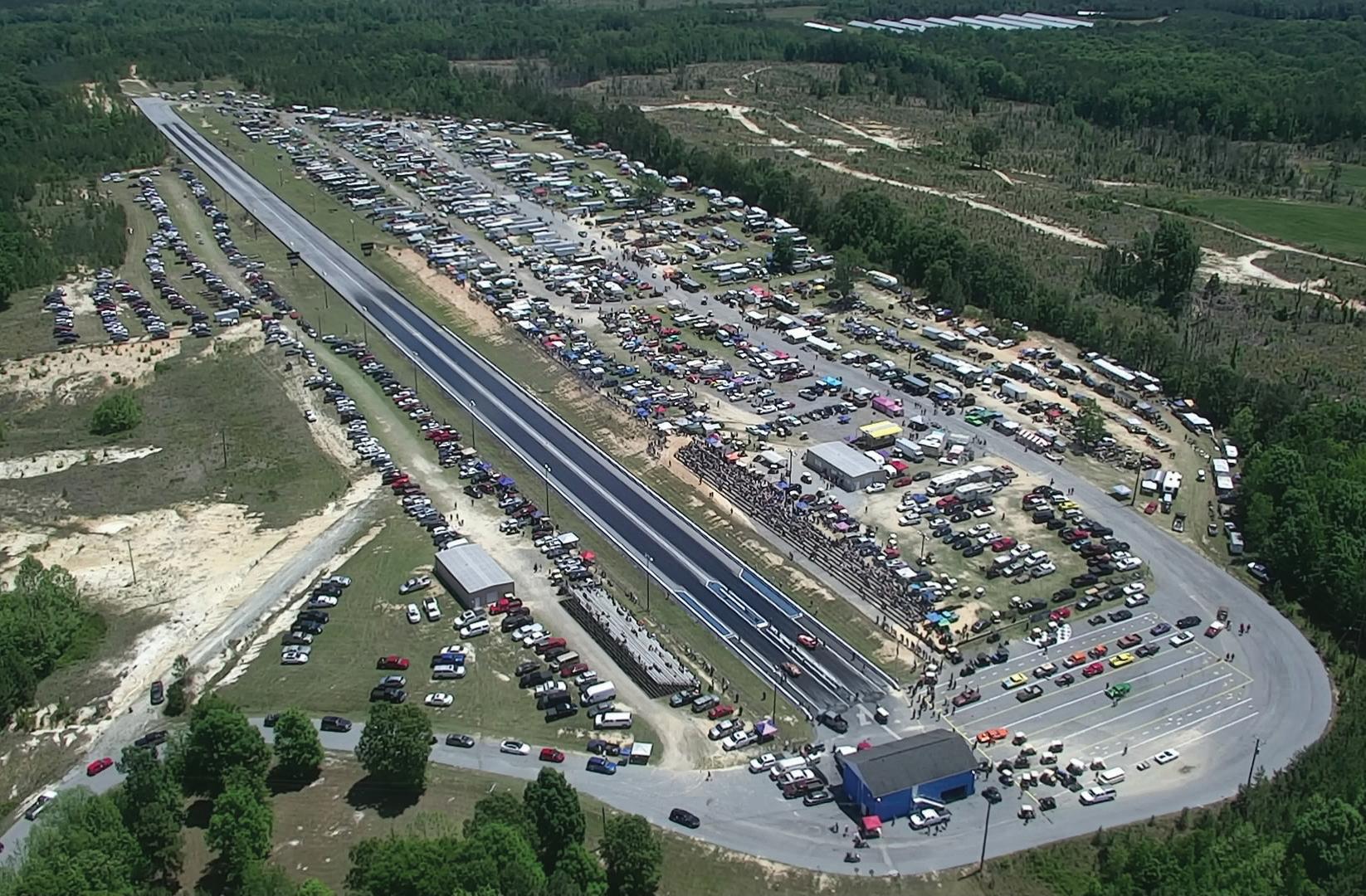
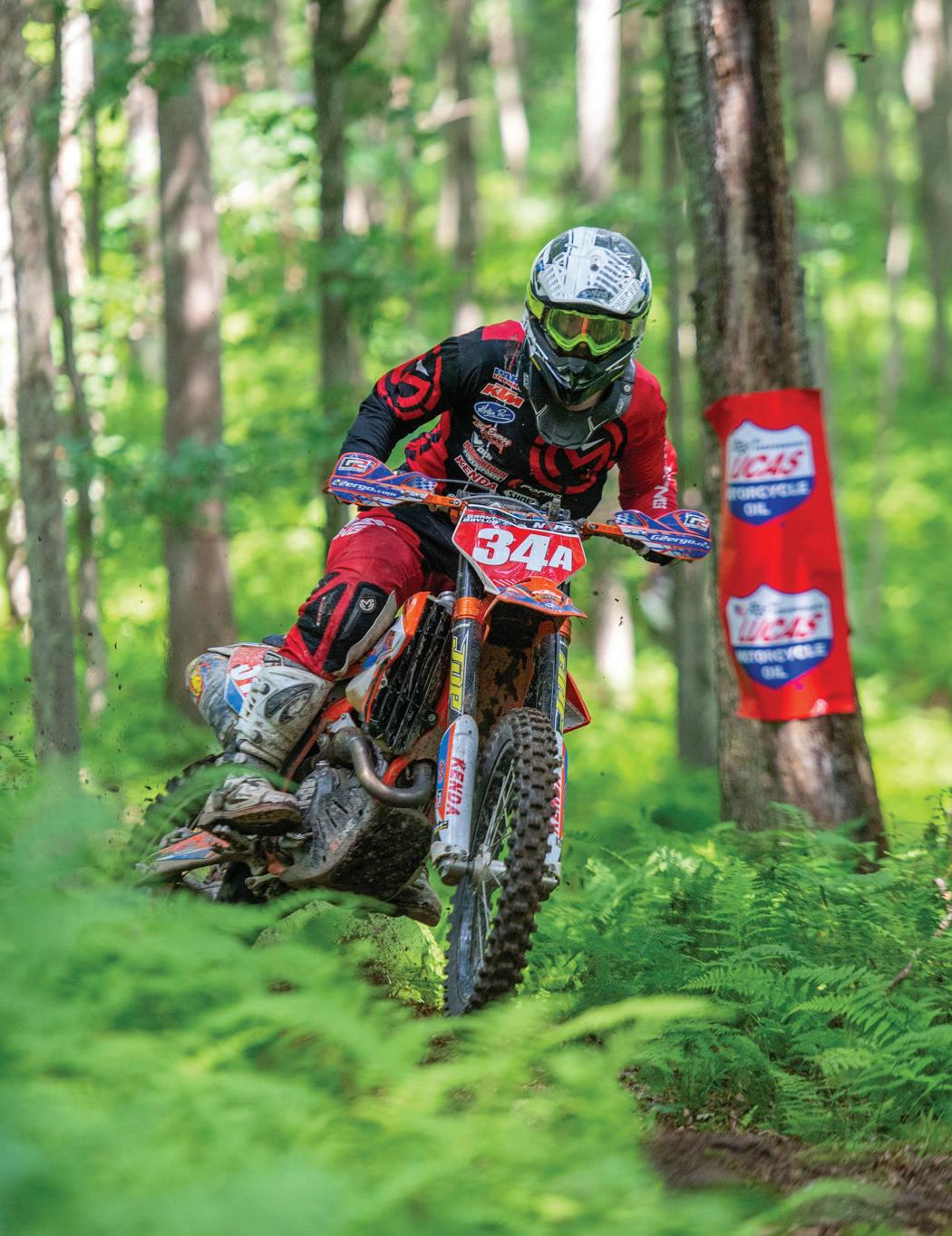
The Main Street Focus Areas are based on four clearly defined communities: A) the City of Union, B) Town of Jonesville, C) Town of Lockhart, and D) Town of Carlisle.
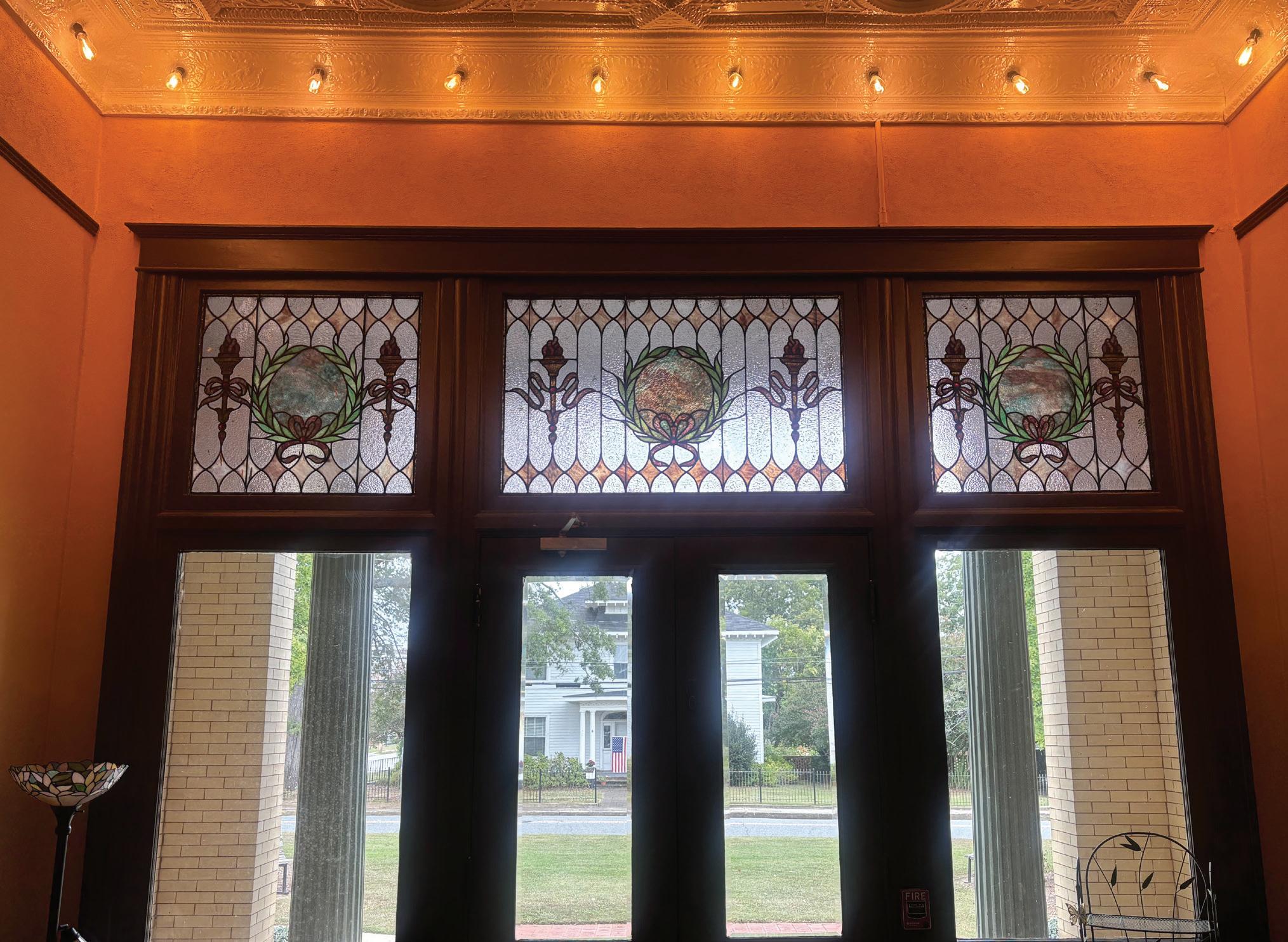
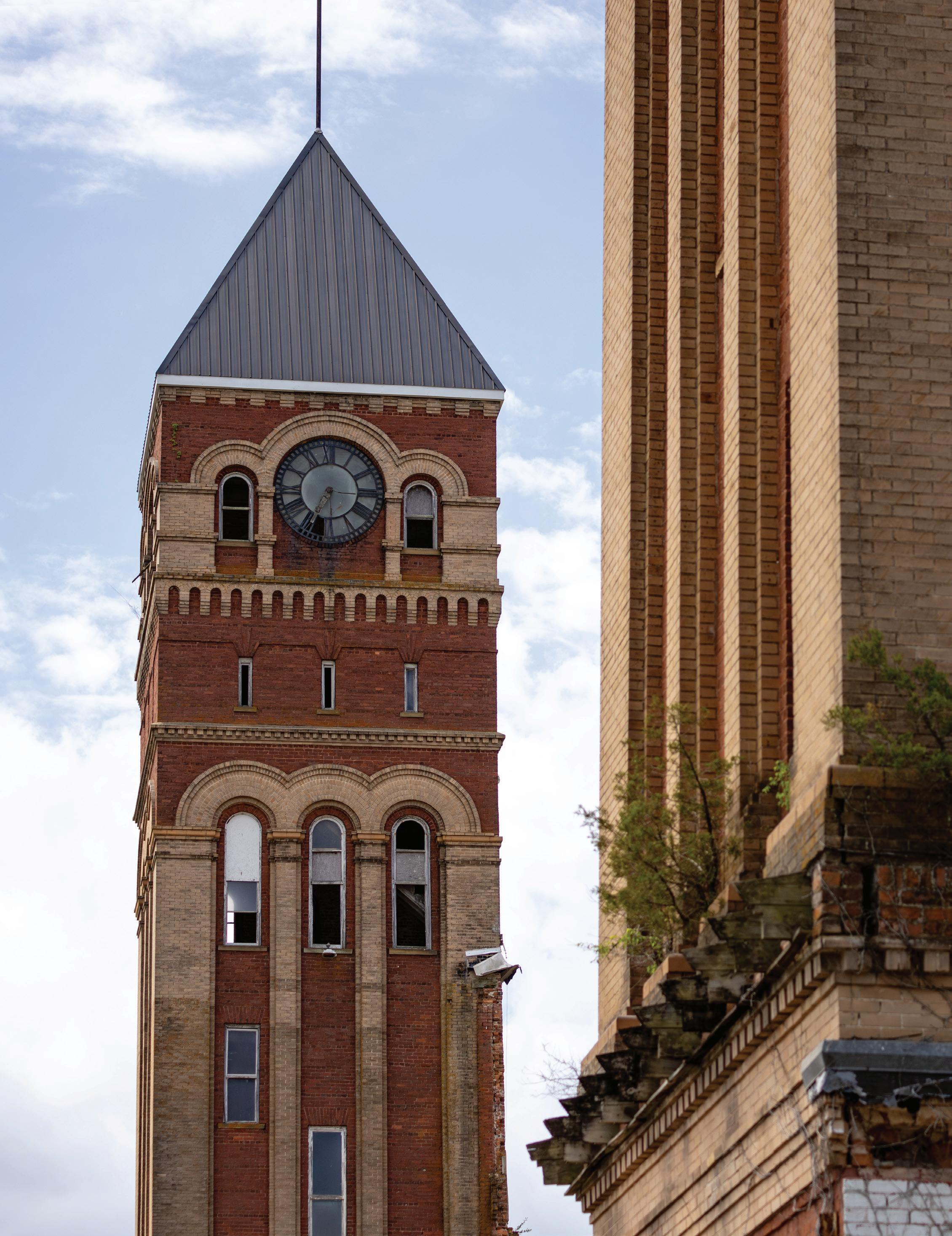
The City of Union Focus Area includes three projects with five recommendations.
Development of an amphitheater can significantly contribute to the fabric of a small town by serving as a focal point for community engagement, cultural enrichment, and economic growth. The facility will provide a space for events, performances, and festivals, offering entertainment and cultural experiences that bring more people to town, especially if it becomes a venue for regional and national acts. Drawing both locals and tourists into the heart of town and providing more customers for area restaurants, shops, and hotels, should help revitalize the downtown area.
A.1.1 Design and construct destinationquality amphitheater and grounds
A.1.2 Perform ongoing marketing, operation, and maintenance of the venue

Union is developing a downtown revitalization plan with the goal of creating an environment that encourages business investment and attracting more visitors and residents to the city. Key efforts include establishing a downtown advisory group, preserving the character and charm of downtown, activating the use of outdoor spaces, facilitating business recruitment/retention, improving awareness/coordination of parking, and examining major urban design projects.
A.2.1 Adopt and implement recommendations from the plan
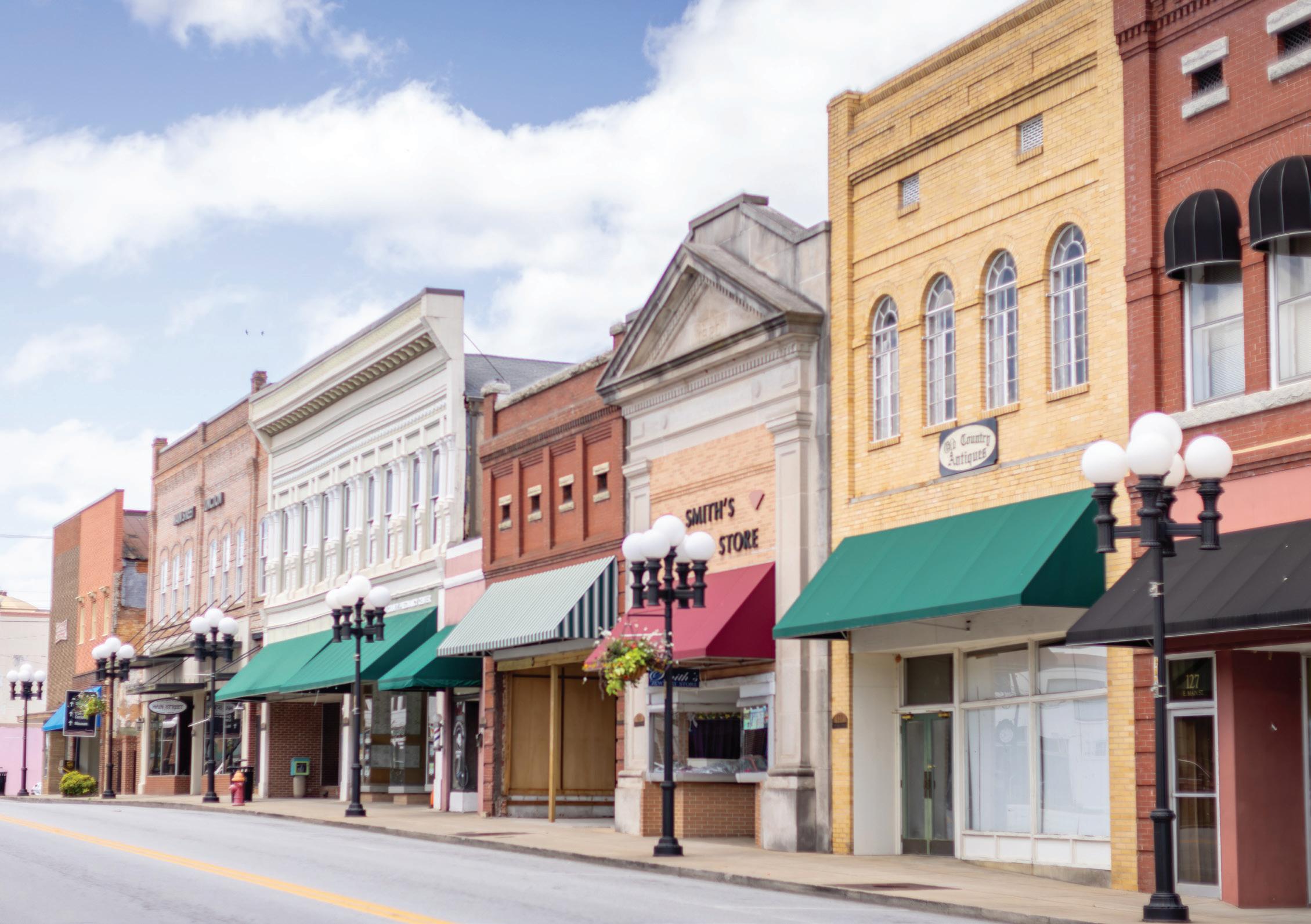
Developing a rail trail on an unused rail corridor involves several key steps, starting with a feasibility study to assess the condition of the corridor and to determine the community’s interest. Securing ownership or easements is essential, along with conducting an environmental impact assessment and obtaining necessary permits. The trail design must include accessible features, such as parking, signage, and rest areas for trail users. Partnerships with local governments and transportation organizations are
key to successful development. Ongoing operation and maintenance will include regular maintenance and repairs. Community engagement will be necessary to promote the trail and attract new users.
A.3.1 Conduct feasibility study for redevelopment of corridor as paved multi-use greenway
A.3.2 Identify partners to help fund, construct, and manage the trail
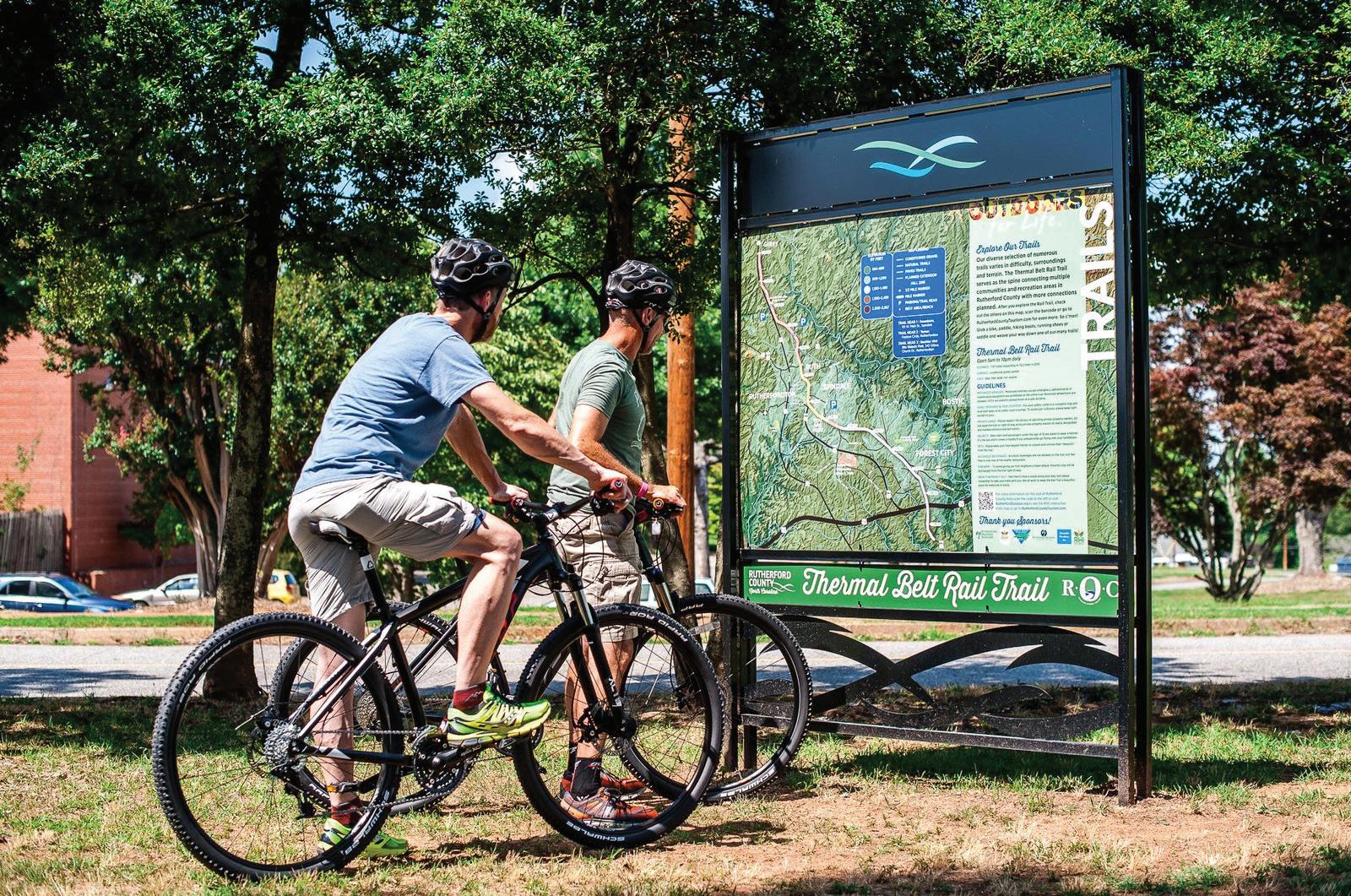
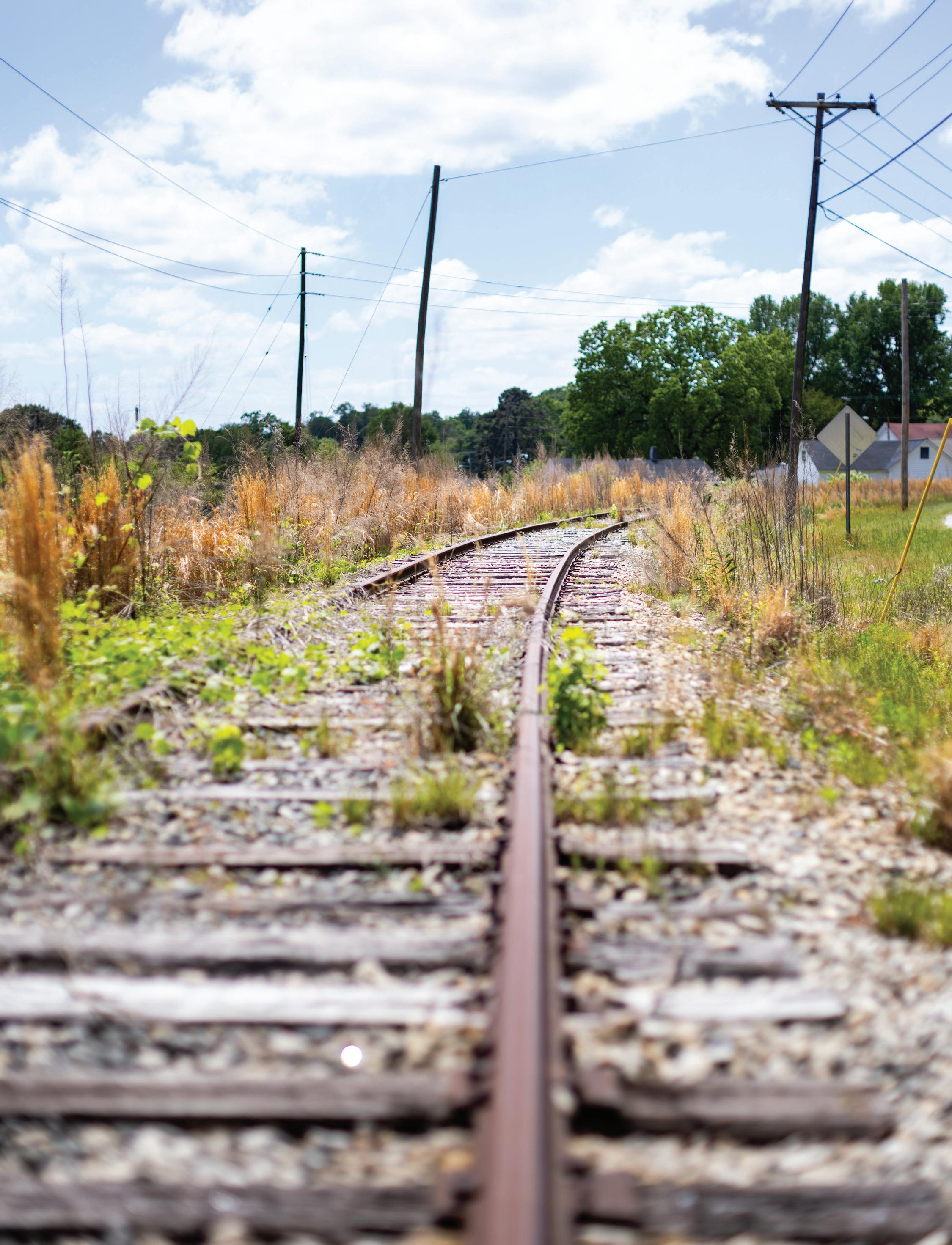
The Town of Jonesville Focus Area includes one project with 2 recommendations.
The strategic development of downtown Jonesville, including infill development, streetscape enhancements, and gateway plazas, alongside upgrades to Jonesville Park, can significantly contribute to the local economy and support tourism development. By improving the town’s infrastructure and public spaces, these efforts should create a more inviting environment for both residents and visitors, encourage longer stays, and increase spending in local businesses. Additionally, these improvements will enhance Jonesville’s appeal as a destination for both day trips and extended stays and contribute to the long-term growth of the town’s economic vitality.
B.1.1 Downtown Jonesville (Continue to pursue infill development opportunities, streetscape enhancements, and gateway plazas)
B.1.2 Jonesville Park Upgrades (including, but not limited to, a playground and restrooms)
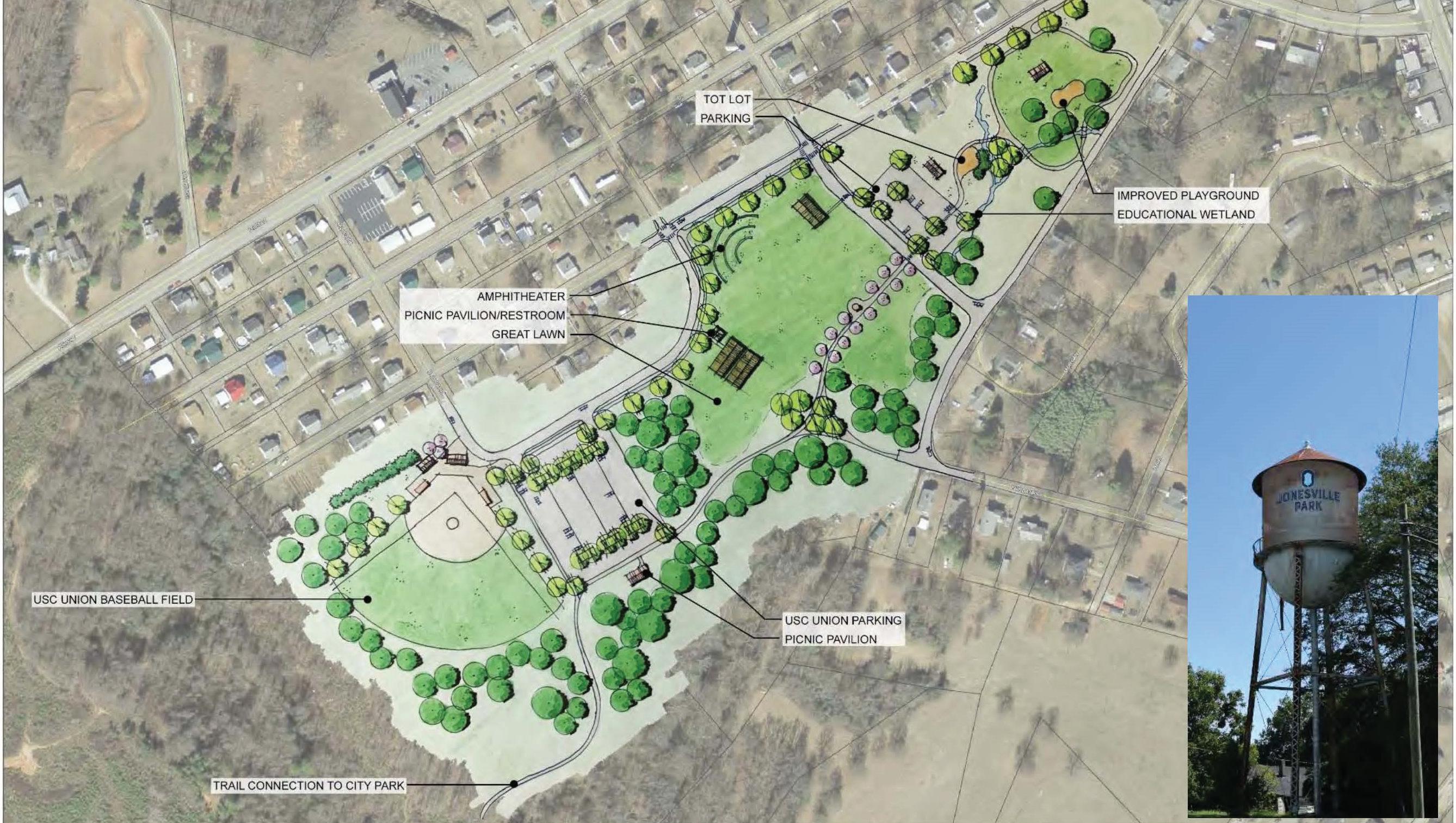
The Town of Lockhart Focus Area includes one project with three recommendations.
The Town of Lockhart has made significant strides in implementing its Lockhart Tomorrow community development plan. With a focus on key areas aimed at revitalizing the town and improving the quality of life for its residents, the current initiatives include continued planning and fundraising for their Town Square Park and pedestrian bridge projects. These projects aim to create a more inviting and functional central area for residents and visitors. In the River District, the Flat Stack Park Enhancement focuses on revitalizing public spaces and offering additional recreational opportunities, by improving accessibility to the riverfront. The Hill District’s Residential Neighborhood Revitalization efforts are
centered on improving housing quality and fostering a stronger sense of community. Together, these efforts align with the broader vision of transforming Lockhart into a more vibrant and connected town, which has the potential to support both local economic development and the growth of tourism.
C.1.1 Town Square Park Improvements
C.1.2 River District: Flat Stack Park Enhancement
C.1.3 Hill District: Residential Neighborhood Revitalization
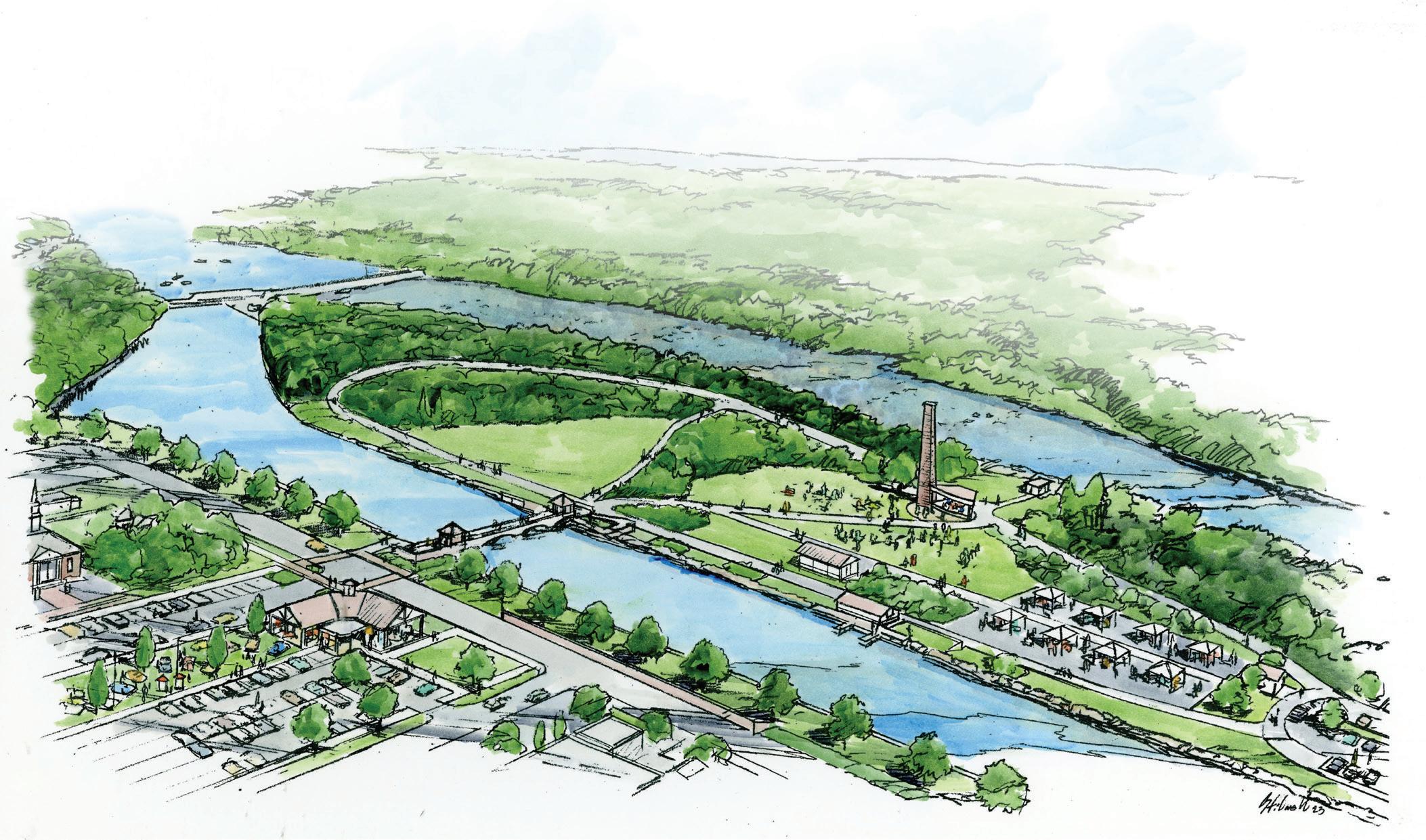
The Town of Carlisle Focus Area includes one project with three recommendations.
Gateway signs offer several benefits for small communities, particularly in the context of tourism development and local identity. These signs serve as landmarks that highlight the community’s name, history, and unique characteristics and often help create a sense of place and pride for residents. Gateway signs enhance the visibility of small communities, making them more recognizable to travelers and can also serve as a tool for promoting community events, cultural heritage, and local initiatives, and contribute to a more positive community image.
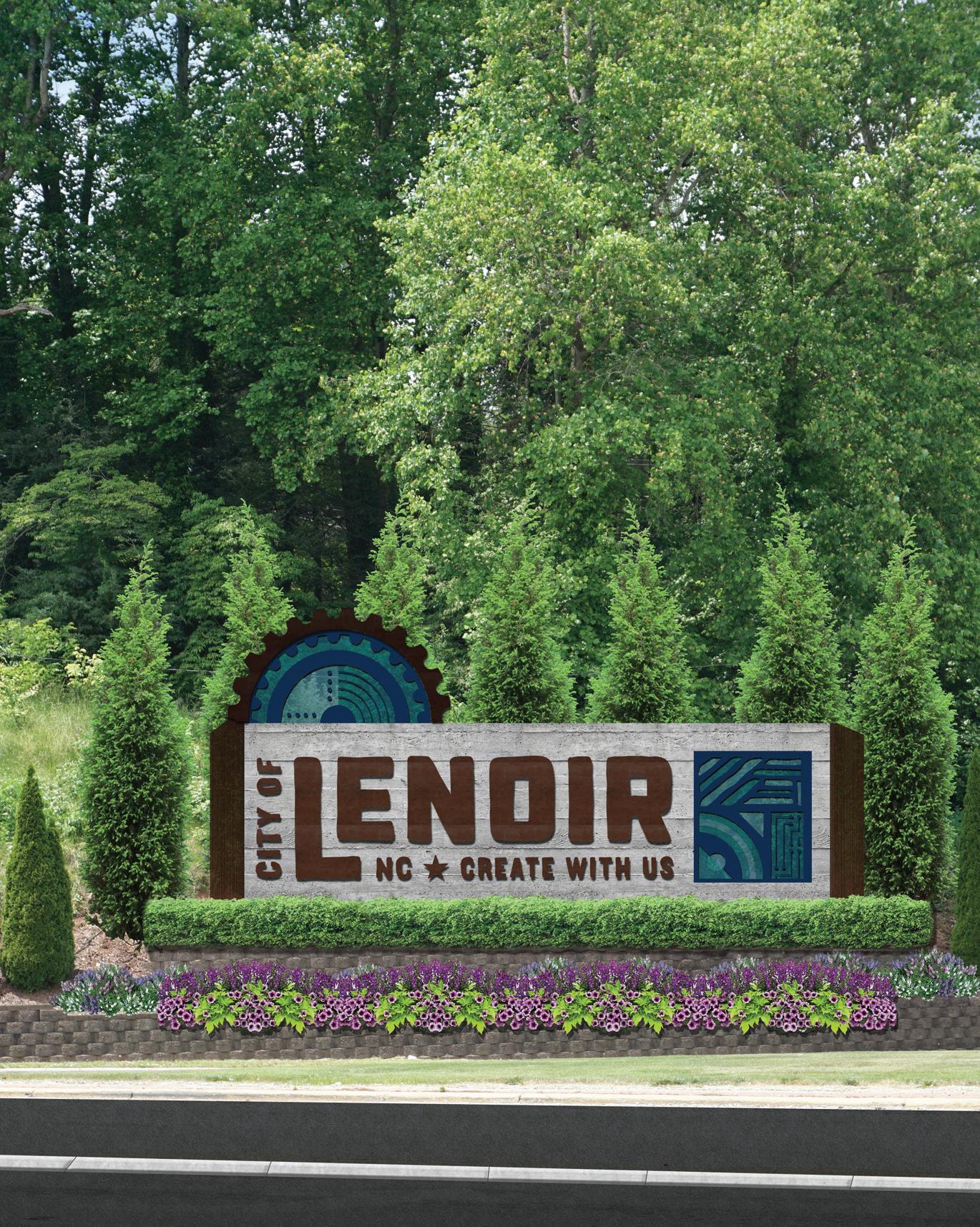
D.1.1 Welcome / gateway signage
D.1.2 Increased Promotion of Events (New Christmas Decorations)
D.1.3 Carlisle Finishing industrial site repurposed for recreation or mixeduse development with river access
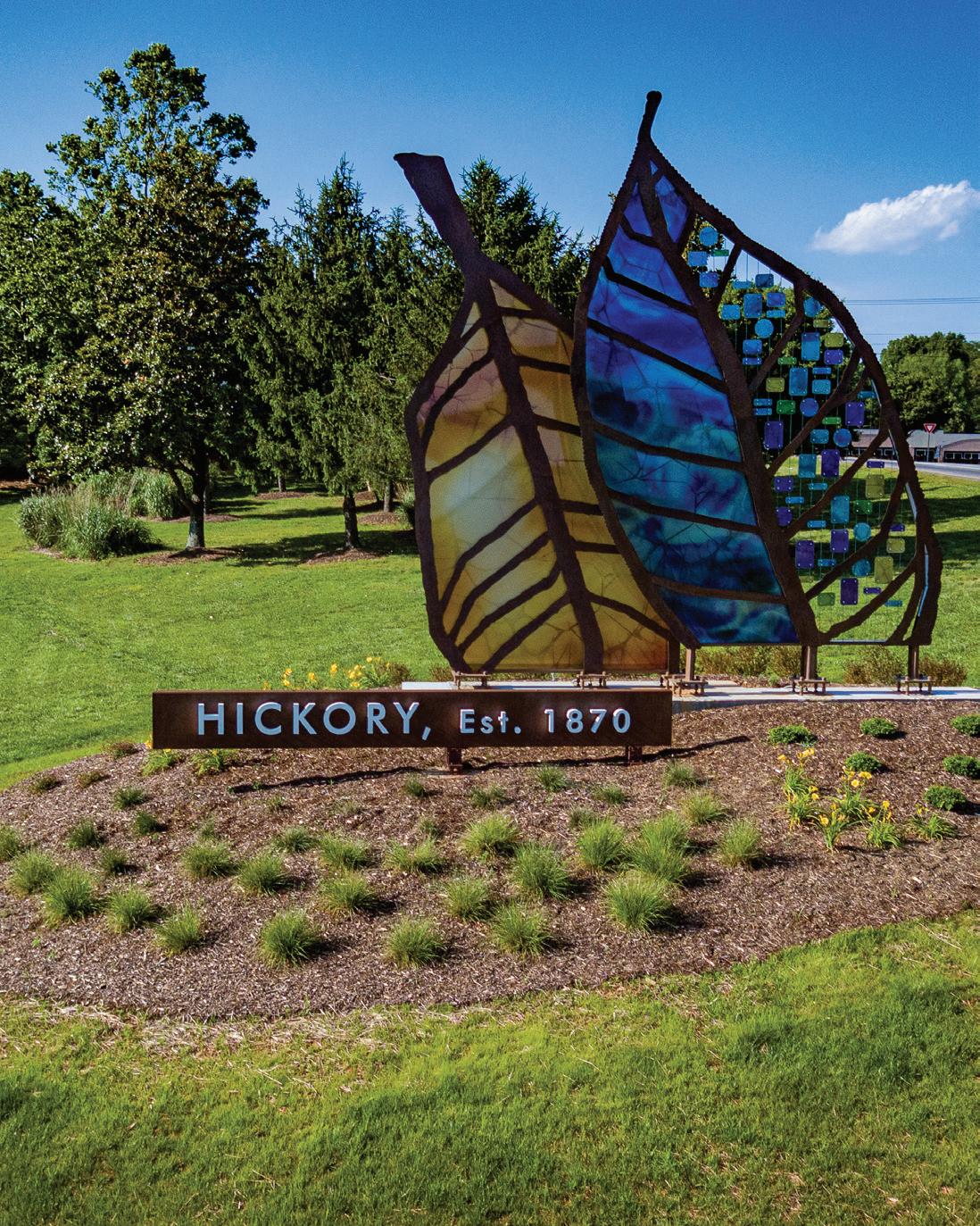
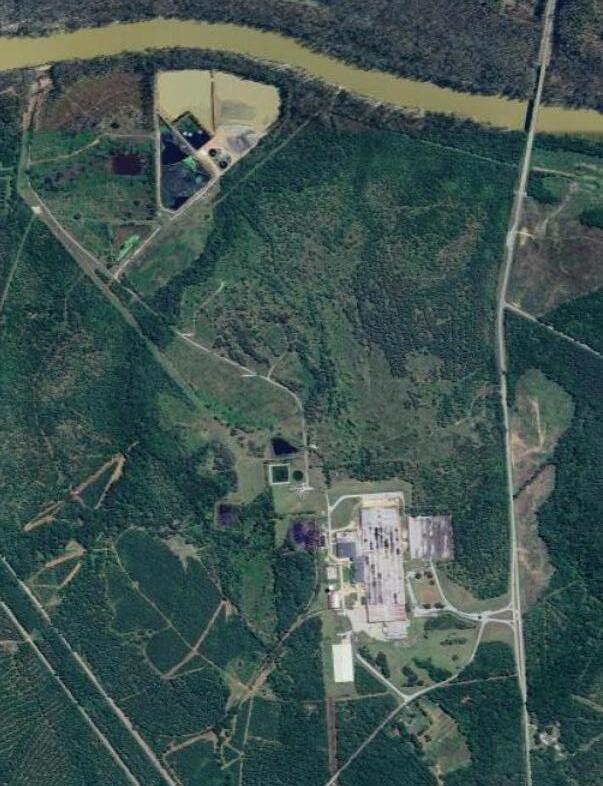
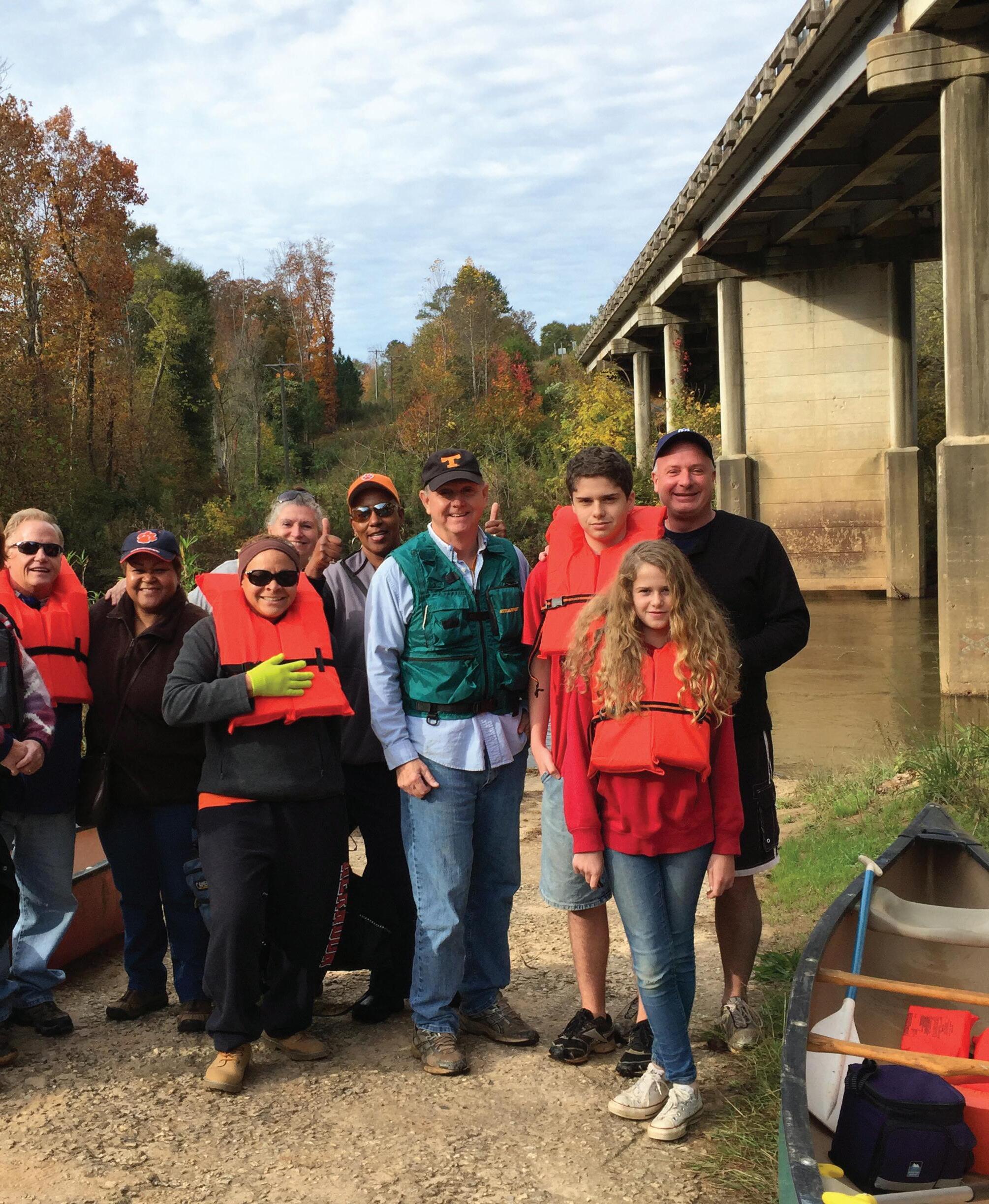
This chapter outlines general recommendations for plan implementation, provides a summary implementation matrix, and highlights key grant-funding opportunities. Where applicable, the implementation matrix provides realistic cost estimates derived from comparable projects successfully implemented in similar communities. Actual project costs for capital projects are typically influenced by current market conditions and prevailing prices for design services, labor, and materials, as determined through a competitive bid and procurement process.
The prioritization plan included here intends that the most desired and impactful projects are addressed promptly, while balancing organizational capacity and budget constraints. By categorizing projects into high, medium, and low priority tiers, resources can be strategically allocated, while funding opportunities should be targeted to implement projects that are mostaligned with community needs. These needs should be identified through a collaborative process facilitated by a dedicated team, as outlined in the General Recommendations section.
5.1 GENERAL RECOMMENDATIONS
5.2 IMPLEMENTATION MATRIX
5.3 KEY GRANT-FUNDING OPPORTUNITIES
The Regional Tourism Plan outlines a strategic approach for strengthening Union County’s economy by leveraging the region’s tourism assets to create a more vibrant and diverse tourist destination that is more attractive to visitors. The plan aims to attract new visitors, encourage longer stays, support local businesses, and create new jobs, all of which contribute to a stronger economy. Additionally, the plan enhances the quality of life for residents by promoting the development of accessible recreational spaces and initiatives that encourage outdoor activities. By prioritizing projects that promote active lifestyles, the plan provides opportunities for more physical activity and social engagement. These efforts not only improve residents’ health but also contribute to a more connected and dynamic community where people can enjoy a higher standard of living and a greater sense of well-being.
The Plan recommends specific projects that support the growth of the tourism sector and fosters an environment that encourages active lifestyles and it also offers the following set of more general recommendations intended to make the implementation process more effective.
The Project Oversight Committee, led by the Union County Tourism Department, should expand its outreach and include additional partners from government agencies, the private sector, and relevant nonprofit organizations to establish an 8-12 member Tourism Development Committee. These members would be representatives from each local government jurisdiction and other key stakeholder groups. The Committee should also include partners from other governmental agencies, the private sector, and relevant nonprofit organizations. This committee would be responsible for prioritizing tourism projects, fundraising, and ensuring the adequate progress of plan implementation.
The Tourism Development Committee should offer support by supplementing organizational capacity, assisting county and municipal efforts to establish key assets, and when applicable fostering relationships with state and federal land managers to promote outdoor recreation and tourism assets on public lands.
After the adoption of the Regional Tourism Development Plan, the Tourism Development Committee should initiate the capital campaign necessary to pursue state and federal grants and secure funding from various private and corporate sources.
The Tourism Development Committee should consider hiring a project consultant to manage and oversee the acquisition, grant procurement, design, and engineering of capital infrastructure projects, ensuring accountability and successful project execution.
Acomprehensive public relations and communications strategy, alongside a strong brand identity, should be developed to position the region as a premier tourism destination while highlighting the continued efforts of the Tourism Development Committee. This strategy should include targeted outreach to key audiences, media partnerships, and consistent messaging to build public awareness and engagement.
Gateway signage should be installed at all major entry points into the County, incorporating the new brand identity to create a welcoming and cohesive first impression for visitors. These signs should highlight the County’s unique attributes and serve as a visual representation of the region’s commitment to tourism, community pride, and its distinct identity.
Consider creating a dedicated staff position, such as an Outdoor Recreation Planner or Tourism Development Planner, to oversee the implementation of the Regional Tourism Plan. This position, which could be funded through grants or an interlocal partnership, would be responsible for building and maintaining partnerships with stakeholders, securing funding, managing projects, promoting completed projects, and ensuring the overall execution of the plan. Having a dedicated role will help streamline efforts and ensure the successful development of tourism infrastructure and projects.
To accommodate the increasing number of visitors, the area needs to prioritize the expansion of hotel lodging options and actively recruit more short-term vacation rentals and hosts. By diversifying accommodation offerings, the region can better support tourism growth and provide a variety of options to meet different traveler needs. This expansion will not only enhance the visitor experience but also contribute to the local economy by attracting more guests and generating additional revenue for local businesses.
Union County’s Tourism Development Committee will have a unique opportunity to foster regional tourism growth by implementing strategies that highlight the distinct yet shared cultural, historical, and natural assets across the Upstate region. By collaborating with neighboring Cherokee County, which boasts significant tourism assets and extensive experience in tourism development, Union County can help create a cohesive tourism experience that draws on the strengths of both areas.
Cherokee County features regional destinations such as the Overmountain Victory Trail, Cowpens National Battlefield, and Kings Mountain National Military Park, all of which attract thousands of visitors annually. These destinations, along with shared natural resources like the Broad and Pacolet Rivers, provide a strong foundation for a unified tourism offering. Additionally, the historic downtowns of Chesnee, Gaffney, and Blacksburg, with their vibrant Main Street connections, further enhance the region’s tourism appeal.
By marketing Union and Cherokee counties as a unified tourism destination, the two counties could emphasize their shared heritage and experiences, offering visitors a more expansive and enriching travel experience. This approach not only strengthens the tourism product of both counties but also promotes regionalism, ensuring a broader, more sustainable tourism economy for the Upstate region.
A.1.3 Festivals and Events Marketing and Promotions
A.1.4 Food and Beverages (e.g. BBQ Festival + Microbrewery/Distillery) A.1.5 Public Art (Sculpture + Murals)
B.1.1 Agency Partnerships and Planning A.1.2 Venues and Concert Marketing and Promotions
B.2.2 Trailheads
Natural Surface Trails (Hiking, Biking, Equestrian)- cont’d
Focus Area C: Managed Areas Focus Area D: Agritourism
D.1.2 New Destination-Quality Facilities / Arena
E.1: Team Sports
E.1.1 Timken Sports Complex Marketing & Promotion
E.1.2 Union County Stadium Marketing & Promotion
E.1.3 Host Road Racing and Bicycling Events
E.2.1 Support a wide range of events at Union Dragway
E.2.2 Promote the area as a popular destination for motorcyclists and off-road racing enthusiasts
E.2.3 Support classic and custom car shows through sponsorship and promotion
Cost Estimate
$25,000
$25,000
$25,000
$25,000
$25,000
$25,000
A.1.1 Design and construct destination-quality amphitheater and grounds
Perform ongoing marketing, operation and maintenance of venue
A.2: Downtown Revitalization Plan (in progress)
A.2.1 Adopt and implement recommendations from plan when completed
A.3: Buffalo Rail Trail
A.3.1 Conduct feasibility study for redevelopment of corridor as paved multi-use greenway
A.3.2 Identify partners to help fund, construct, and manage trail
Focus Area B: Jonesville
B.1: Continue to Implement Strategic Master Plan
B.1.1 Downtown Jonesville (Continue to pursue infill development opportunities, streetscape enhancements, and gateway plazas)
B.1.2 Jonesville Park Upgrades (including but not limited to a playground and restrooms)
Focus Area C: Lockhart
C.1: Continue to Implement Lockhart Tomorrow Plan
Town Square Park Improvements
River District: Flat Stack Park Enhancement
C.1.3 Hill District: Residential Neighborhood Revitalization
Focus Area D: Carlisle
D.1: Capital projects
Welcome / Gateway Signage
Increased Promotion of Events (Christmas Decorations)
D.1.3 Carlisle Finishing industrial site repurposed for recreation or mixed-use development with river access
There are numerous grant-funding opportunities from organizations dedicated to supporting outdoor recreation, as well as cultural and heritage tourism development projects. These organizations offer financial resources to enhance public access to natural spaces, preserve cultural heritage, and promote environmental stewardship. By targeting a broad range of initiatives, from trail construction and conservation efforts to the promotion of local traditions and historical landmarks, these grants can help build a robust tourism sector. This list highlights key funding opportunities that are committed to the advancement of impactful tourism-related projects.
AgSouth Farm Credit annually supports nonprofits and farmers markets in South Carolina to promote agricultural development. Key objectives include investing in the future, enhancing quality of life, and serving as a responsible corporate citizen. Supported projects range from children’s market programs to livestock arena improvements and agricultural events.
The America the Beautiful Challenge seeks to conserve, connect, and restore lands, waters, and wildlife. Eligible projects span a range of categories, including Implementation, Planning, Sentinel Landscape Grants, National Forest Grants, Private Forests, and Rangeland and Farmland.
This program supports partners in completing trail research, design, planning, stewardship, and maintenance projects that are inclusive, promote improved trail user behavior, and connect trail assets to a wider range of users. It is intended for non-Forest Service federal lands, as well as state, local, and private lands. Projects on Forest Service lands should be directed to the Legacy Trails Program.
This program enables project partners to complete trail projects that enhance watershed health, restore aquatic organism passages, preserve access, and decommission unauthorized or previously closed trails.
The Appalachian Regional Commission (ARC) is a federal agency dedicated to economic development in the Appalachian region. It collaborates with states and local communities to provide grants that support a wide range of initiatives. Key investment priorities include enhancing community infrastructure, promoting regional culture and tourism, and fostering business growth and workforce development.
The East Coast Greenway Alliance is dedicated to advancing the development, stewardship, and public enjoyment of a safe, accessible, multi-use greenway that connects cities and towns from Maine to Florida. Funding will support trail projects aimed at expanding the East Coast Greenway System (EGST) across various eastern states, including South Carolina.
This grant program provides emerging tourism destinations with financial support to drive new visitation through targeted tourism advertising initiatives.
FLAP was established to enhance transportation facilities providing access to, adjacent to, or within federal lands. The Access Program supplements state and local resources for public roads, transit systems, and other transportation infrastructure, with a focus on high-use recreation sites and key economic drivers.
The Land and Water Conservation Fund (LWCF) offers grants for the acquisition and development of outdoor recreation areas and facilities. Funds can be used to revitalize existing LWCF properties or support new park projects, particularly those that address capacity challenges.
The Lowe’s Hometown Grants Program funds community projects focused on physical improvements and enhancements. Eligible projects must be sponsored by a nonprofit or government entity and align with at least one of the following categories: community spaces and resources, safe and affordable housing, cultural preservation, area revitalization, or skilled trades education initiatives.
This grant program supports economic development projects that deliver measurable outcomes and enhance a municipality’s quality of life. It encourages and highlights innovative economic development practices that are sustainable over time and can be replicated in other cities.
The ORLP provides new or significantly improved recreation opportunities in economically-disadvantaged communities.
PARD is a noncompetitive grant that provides funding for recreational opportunities within each county of South Carolina. Funds may be used for the development of new public recreation facilities or the enhancement / renovation of existing facilities.
The South Carolina Community Development Block Grant (CDBG) Program offers funding to local governments for projects that support community revitalization. CDBG projects must benefit low- to moderateincome neighborhoods, reduce blight, or address other pressing community needs.
The Transportation Alternatives Program, funded by the Federal Highway Administration (FHWA), enables local governments in South Carolina to apply for grants to support a range of nonmotorized transportation projects.
The Recreational Trails Program is a federal grant initiative aimed at helping states develop and improve recreational trails. Administered by the South Carolina Department of Parks, Recreation and Tourism, the program provides funding for trail-related projects in local communities, including land acquisition, trail construction, maintenance, and safety and education initiatives.
The STAR grant program provides funding to nonprofit tourism or sports organizations to recruit new sporting events. These events aim to generate significant economic impact for local communities through participant and visitor spending, while also enhancing the overall quality of life.
The Timken Fund is an independent philanthropic foundation dedicated to strengthening the communities where it operates. It provides grants to support local initiatives in key areas, including basic needs, education, and community development.
T-Mobile has partnered with Smart Growth America and Main Street America to strengthen and revitalize small towns and rural communities. Through the T-Mobile Hometown Grants program, the company is investing in these communities by awarding grants of up to $50,000 for qualifying projects. The program focuses on funding initiatives that build or renovate public spaces, helping to enhance the local infrastructure and improve the community’s overall vitality.
The TAG grant is designed to boost visitation and increase visitor spending. Funds can be used to support festivals and events, enhance attractions such as historic districts, main streets, museums, and historic sites, or promote destinations.
The Undiscovered SC grant program provides funding to unlock the untapped tourism potential of emerging destinations and their historic, cultural, or recreational attractions. Funds can be used to support publicly owned tourism projects, develop or expand viable tourism products, implement existing plans, or enhance and expand current tourism offerings.
The Economic Development Administration (EDA) provides financial assistance to communities facing economic challenges, funding planning and infrastructure projects aimed at leveraging local assets and building long-term economic capacity. It supports innovative, locally-driven solutions that foster sustainable prosperity and encourages the adoption of tailored development strategies that align with the unique needs and conditions of each community.
The USDA Rural Development program provides grants and loans to support the development or improvement of essential public services and facilities in rural communities. These funds can be used to construct, expand, or enhance communitybased projects that improve quality of life and contribute to the economic development and long-term sustainability of rural areas.
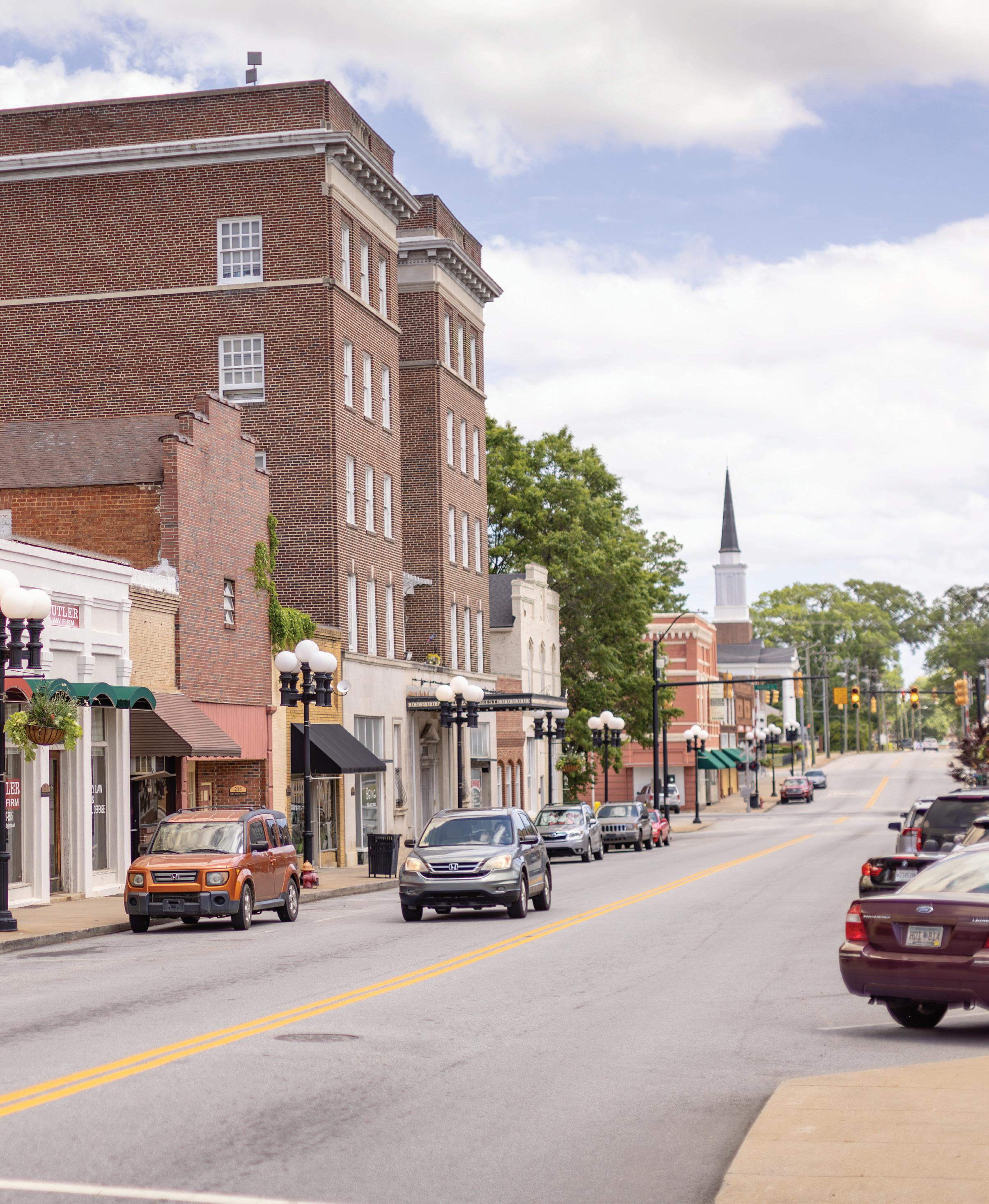
A.1 REGIONAL TOURISM PLAN FACT SHEET
A.2 COMMUNITY SURVEY RESULTS
A.3 PUBLIC FORUM NOTICE
A.4 PUBLIC FORUM SIGN-IN SHEETS
A.5 COMMENT CARDS
A.6 PUBLIC ENGAGEMENT ACTIVITIES
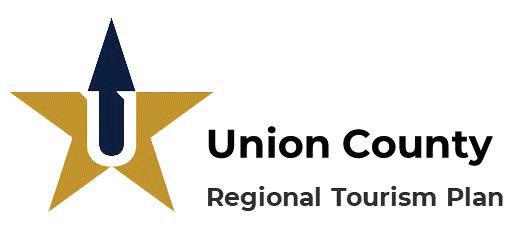
ASSETS. Identify the County’s existing tourism assets and evaluate the current conditions and their ability to support community and economic development.
PARTNERS. Engage local stakeholders and community leaders to establish a vision for enhancing tourism opportunities and the quality of life within the County and Municipalities
GAPS. Identify new and innovative projects to fill existing gaps and help support and realize the County’s vision for the future.
UNITY. County and City officials will support a unified, agreed upon collection of projects which inspire community and civic pride, encourages entrepreneurship, investments in small businesses, and promotes tourism.
VISUAL. Create a plan that generates interest and inspires the community by including high-quality imagery and other graphics that help effectively communicate the plan recommendations.
STRATEGY. Provide Union County and its partners with implementation strategies and recommendations that will help attract visitors, residents, and businesses

Eric Woolridge, AICP President
Destination by Design Planning
828-386-1866 eric@DbDplanning.com
PURPOSE: Union County is embarking on a planning process intended to identify the County's unique cultural, architectural, historic, and geographic features and develop strategies to attract visitors and businesses and encourage greater use of local assets by current residents and businesses.
VISION: The Union County Tourism Plan will identify strategies for tourism development that will highlight the County’s unique cultural and natural resources and offer clearly defined recommendations on how to make the most of these assets to enhance the overall quality of life and help promote tourism within the County.
1) Direction Setting
The consultant team conducted a direction-setting meeting with the County’s project steering committee to discuss key opportunities and constraints. The team will conduct an extensive field analysis to assess existing conditions in the County
2) Discovery and Analysis
Conduct an on-line survey and a series of interviews and focus groups meetings with community leaders and stakeholders to gather ideas and help establish the overall project direction.
3) Draft Plan Development
With guidance from key stakeholders and steering committee members, the consultant team will create a plan framework that introduces preliminary recommendations intended to stimulate tourism development.
4) Final Plan Development
The final plan will feature the agreed upon recommendations, a phasing schedule, estimate of probable costs, and an outline of potential funding sources.

Curtiss Hunter
Union County Tourism Director Union, SC 864-706-0274 chunter@countyofunion.com
Please visit the project website and follow the link to an online community-wide survey at...



